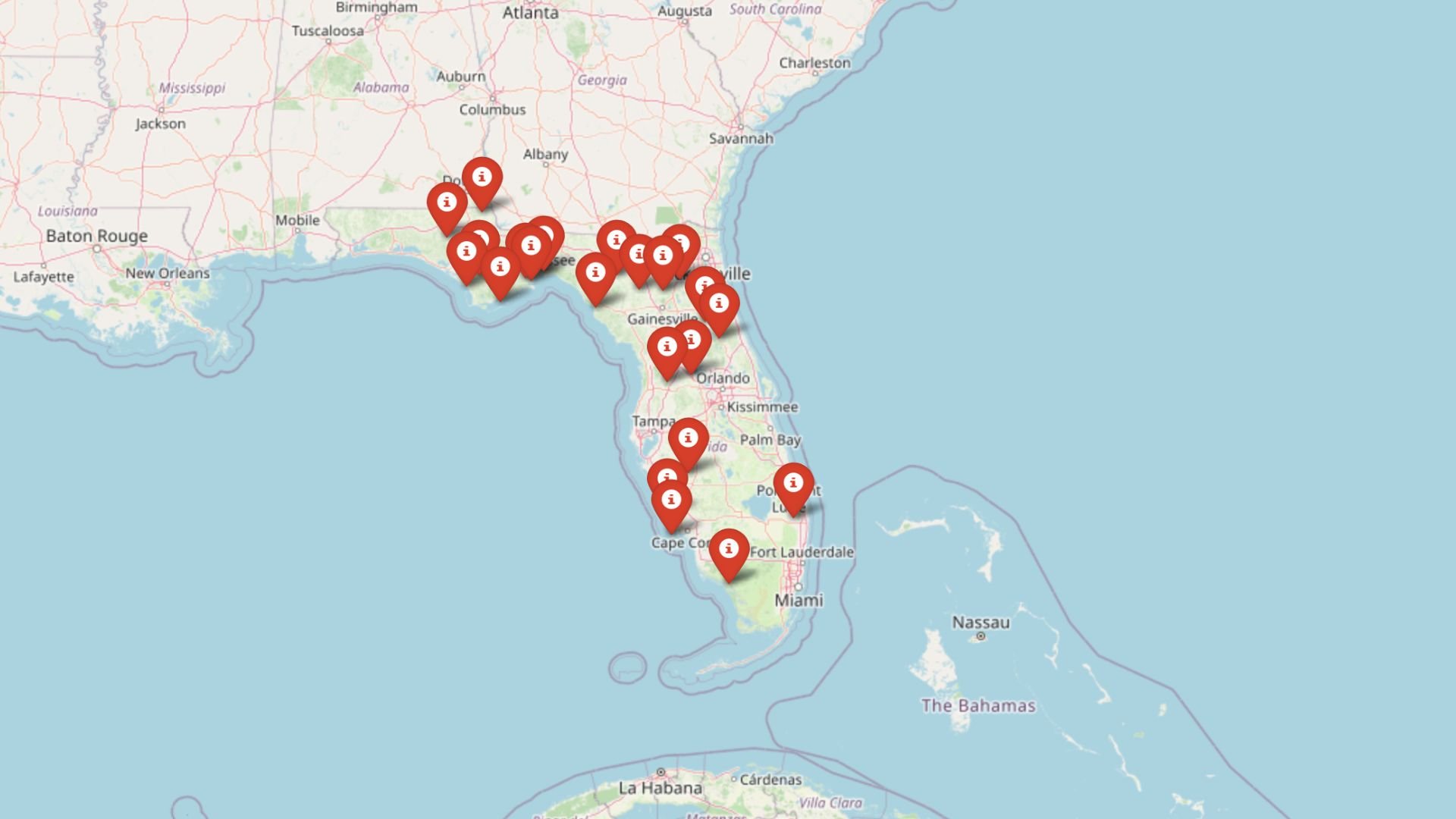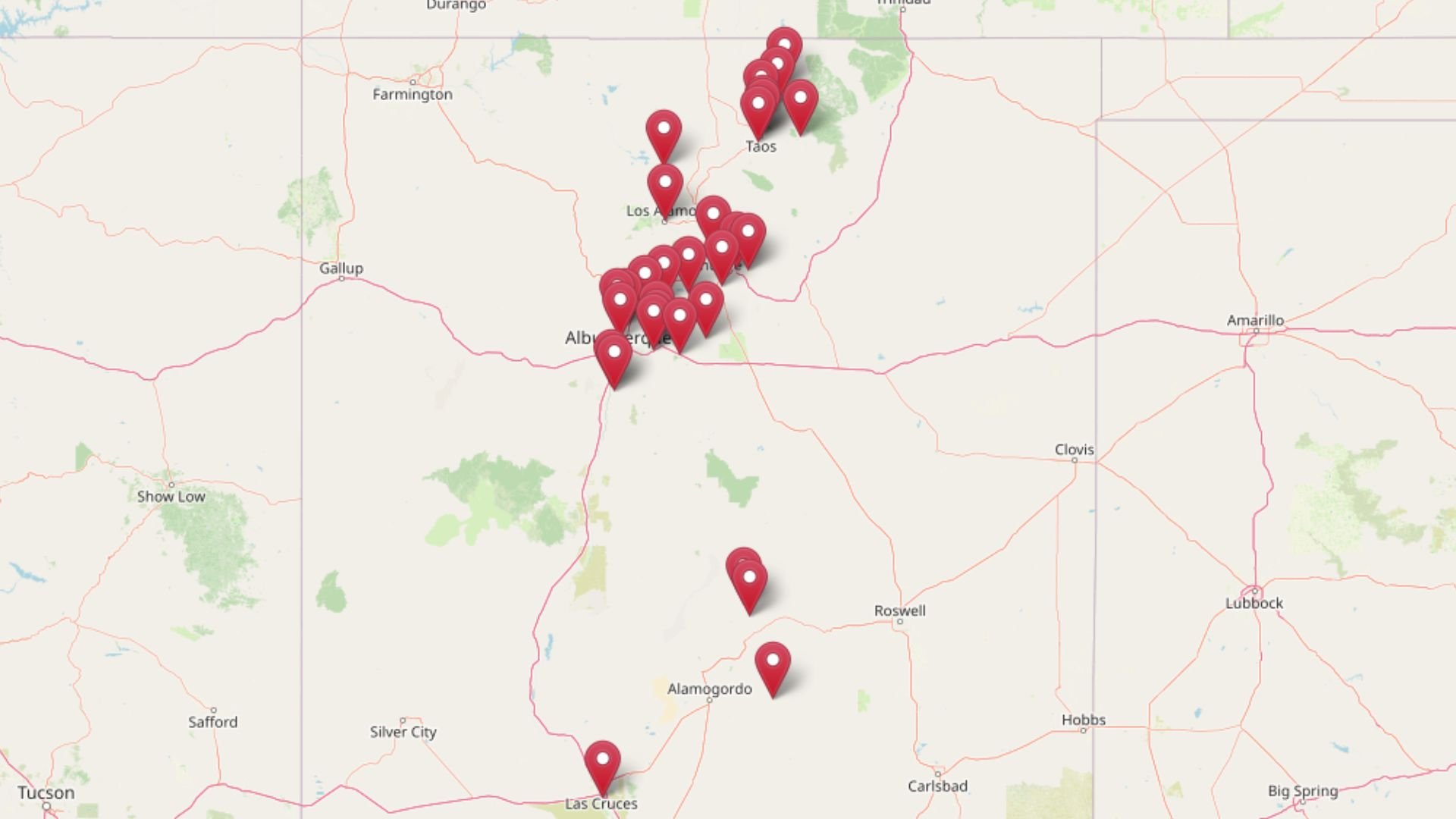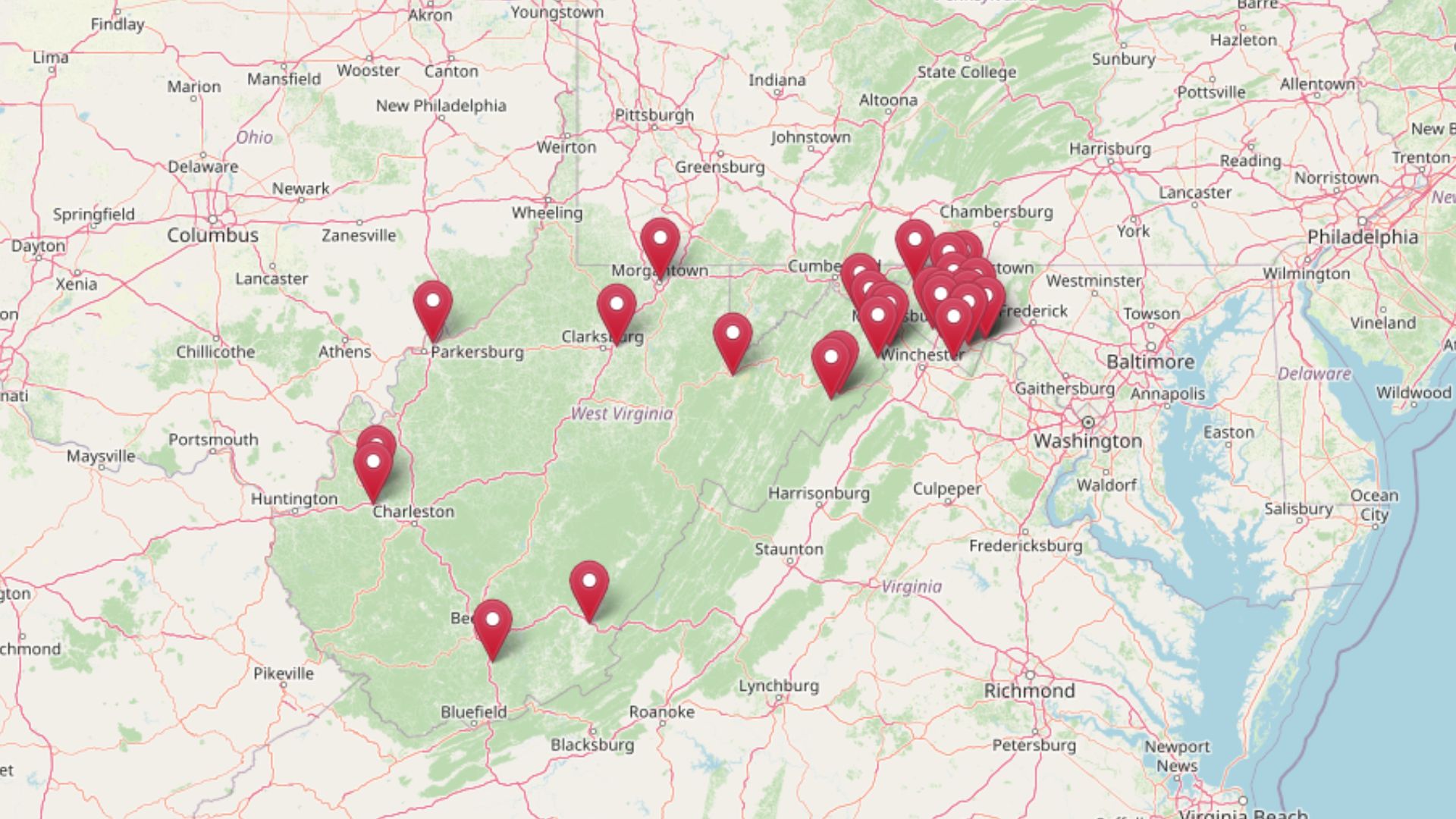
The latest Zillow Home Value Index data reveals dramatic changes across West Virginia’s housing market, with home prices climbing substantially since 2010. Eastern Panhandle communities dominate the rankings, driven by their proximity to Washington D.C. employment centers and improved commuter access. Small mountain towns and historic communities round out the list, showing how buyers value both convenience and character.
These price increases reflect broader market forces including remote work trends, limited housing inventory, and growing demand from out-of-state buyers. Each community offers unique advantages, from college town stability to scenic mountain retreats. Understanding these markets helps buyers, sellers, and investors make informed decisions in West Virginia’s evolving real estate environment.
30. Baker – 79% Home Price Increase Since 2015
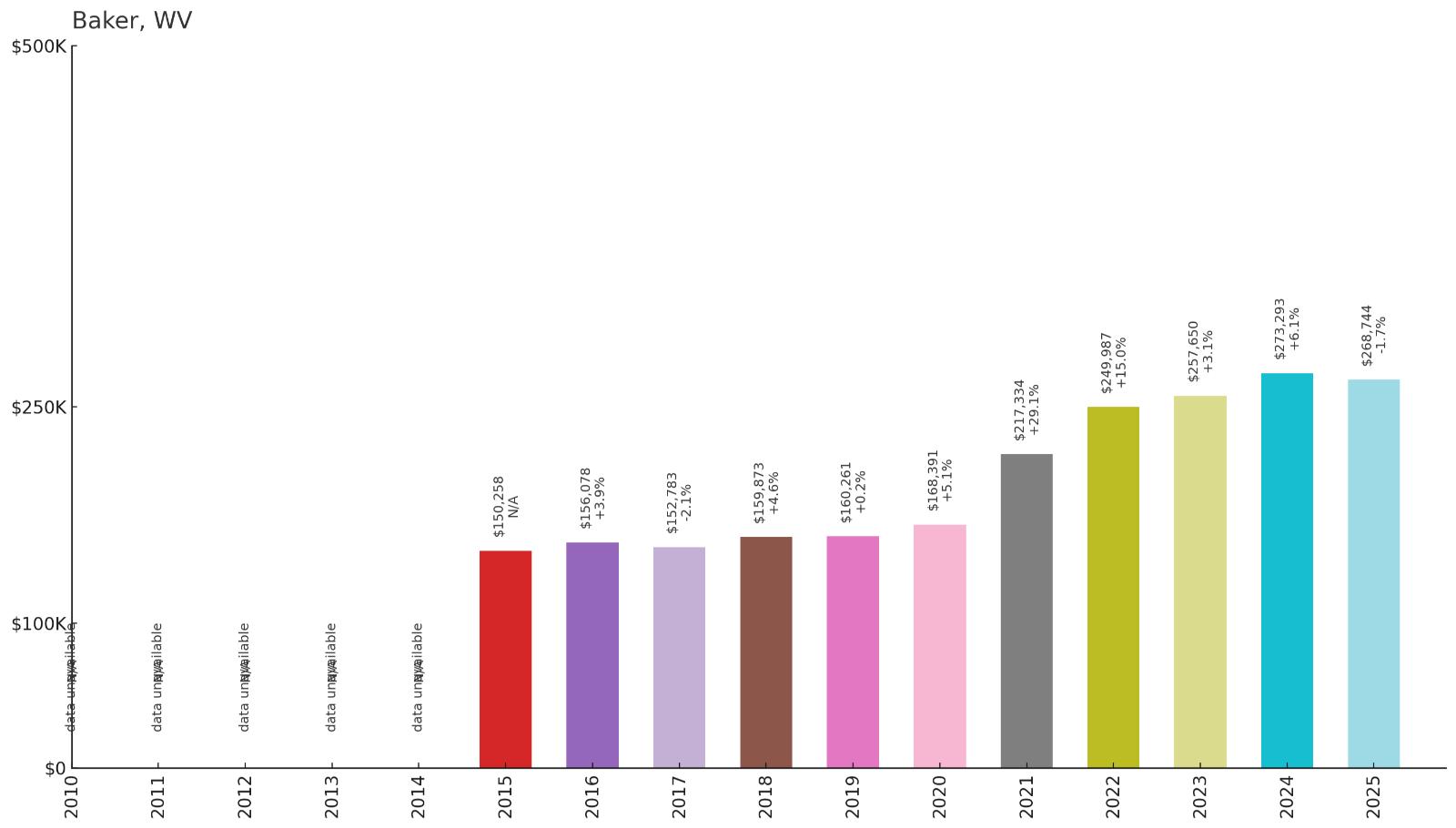
- 2010: N/A
- 2011: N/A
- 2012: N/A
- 2013: N/A
- 2014: N/A
- 2015: $150,258
- 2016: $156,078
- 2017: $152,783
- 2018: $159,873
- 2019: $160,261
- 2020: $168,391
- 2021: $217,334
- 2022: $249,987
- 2023: $257,650
- 2024: $273,293
- 2025: $268,744
Baker experienced steady growth from 2015 until 2020, when pandemic-driven market forces accelerated home values significantly. The town saw its biggest jump in 2021 with a gain of nearly $49,000, though prices have moderated slightly in 2025. Current median home prices of $268,744 represent strong market appreciation over the past decade.
Why Baker?
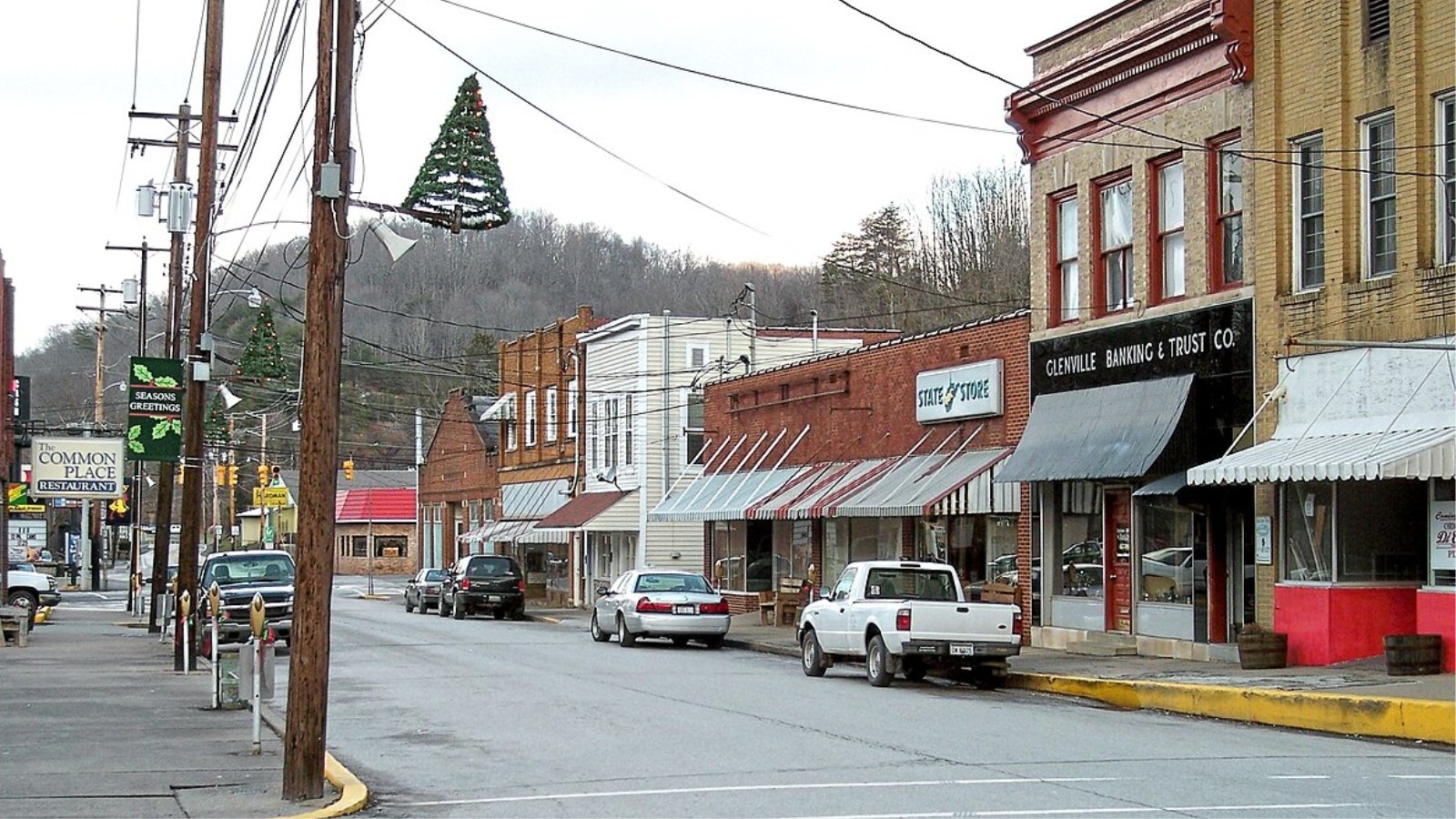
Why Are People Willing to Pay So Much to Live Here? What’s Special About It?
Baker attracts buyers seeking affordable entry points into West Virginia’s real estate market while maintaining rural character and natural beauty. The community offers larger lots and newer construction opportunities that appeal to families wanting space and privacy. Its location provides access to outdoor recreation while staying connected to regional employment centers and amenities.
How Baker Rose to Prominence
Baker’s development followed patterns common to small West Virginia communities, starting as an agricultural area before transitioning to residential use. The town benefited from broader economic growth in the region, particularly as families sought affordable housing options outside more expensive metropolitan areas. Recent growth reflects the statewide trend of increased interest in rural and semi-rural living, especially post-2020.
3 Interesting Tidbits
1. Rural Character – Baker maintains its small-town atmosphere with agricultural roots still visible in the surrounding landscape and property types.
2. Growth Timing – Unlike many communities that saw gradual appreciation, Baker’s most significant price increases occurred during the pandemic housing boom.
3. Market Entry – Baker represents one of the more affordable options among West Virginia’s fastest-appreciating communities, making it attractive to first-time buyers.
29. Morgantown – 45% Home Price Increase Since 2010
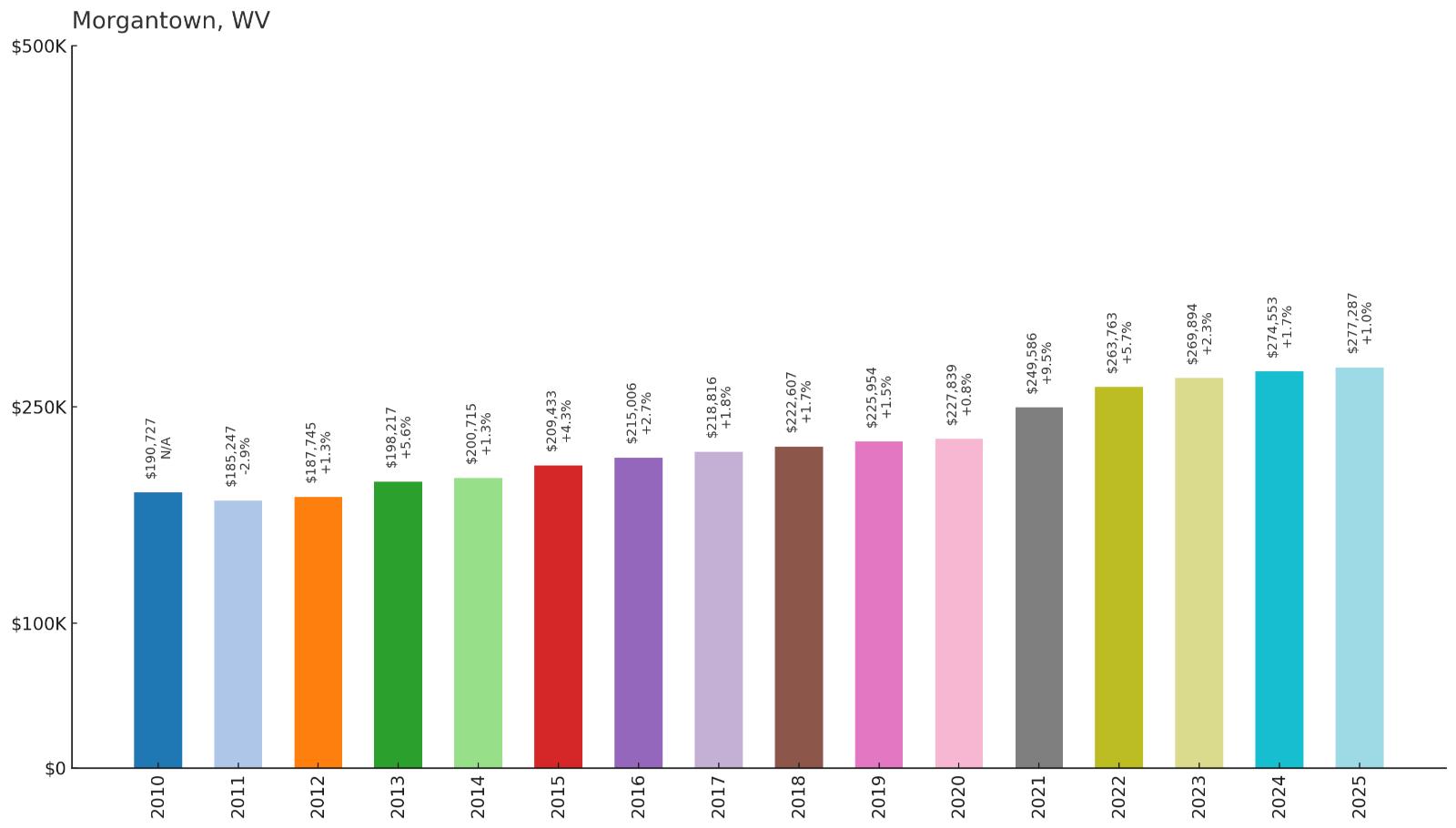
- 2010: $190,727
- 2011: $185,247
- 2012: $187,745
- 2013: $198,217
- 2014: $200,715
- 2015: $209,433
- 2016: $215,006
- 2017: $218,816
- 2018: $222,607
- 2019: $225,954
- 2020: $227,839
- 2021: $249,586
- 2022: $263,763
- 2023: $269,894
- 2024: $274,553
- 2025: $277,287
Morgantown shows consistent, steady appreciation over 15 years with minimal volatility compared to other markets. The town recovered from an early 2011 dip and maintained gradual growth through 2020 before accelerating during the pandemic years. Current values at $277,287 reflect the stability that comes with a strong educational anchor and diverse local economy.
Why Morgantown?
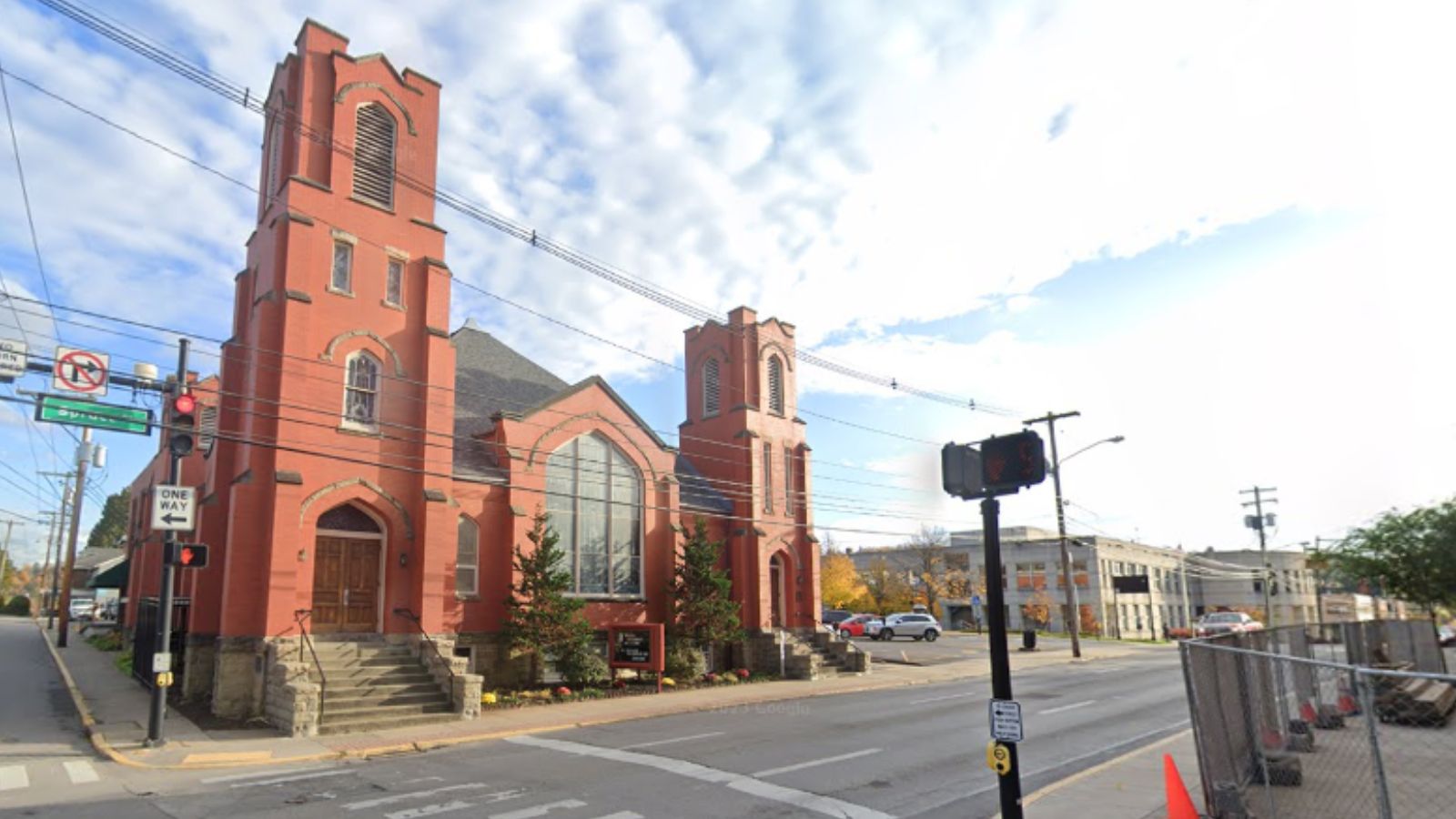
Why Are People Willing to Pay So Much to Live Here? What’s Special About It?
Morgantown benefits from West Virginia University’s presence, creating steady rental demand and employment opportunities that stabilize the housing market. The college town atmosphere attracts young professionals, faculty, and families who value educational resources and cultural amenities. The city offers urban conveniences while maintaining small-town accessibility and reasonable living costs compared to major metropolitan areas.
How Morgantown Rose to Prominence
Morgantown’s prominence stems from West Virginia University, founded in 1867, which became the economic and cultural foundation of the community. The university’s growth attracted businesses, healthcare facilities, and professional services, creating a diversified economy beyond traditional West Virginia industries. This educational anchor provided stability during economic downturns and attracted residents seeking the benefits of a college town environment.
3 Interesting Tidbits
1. University Impact – West Virginia University enrolls over 28,000 students, creating consistent housing demand and economic activity throughout the year.
2. Medical Hub – The WVU Health System serves as a major regional employer and draws medical professionals to the area, supporting higher-end housing demand.
3. River Town – Morgantown sits along the Monongahela River, offering waterfront recreation and scenic views that enhance property values in certain neighborhoods.
28. High View – 85% Home Price Increase Since 2010

- 2010: $151,701
- 2011: $148,691
- 2012: $151,831
- 2013: $151,984
- 2014: $151,720
- 2015: $155,003
- 2016: $163,092
- 2017: $165,885
- 2018: $171,520
- 2019: $174,976
- 2020: $182,804
- 2021: $221,137
- 2022: $256,956
- 2023: $256,603
- 2024: $273,186
- 2025: $280,009
High View remained relatively flat through 2015 before beginning steady appreciation that accelerated significantly after 2020. The community saw its largest gains in 2021 and 2022, with growth moderating but continuing upward to current levels of $280,009. This pattern reflects the broader Eastern Panhandle trend of pandemic-era acceleration.
Why High View?
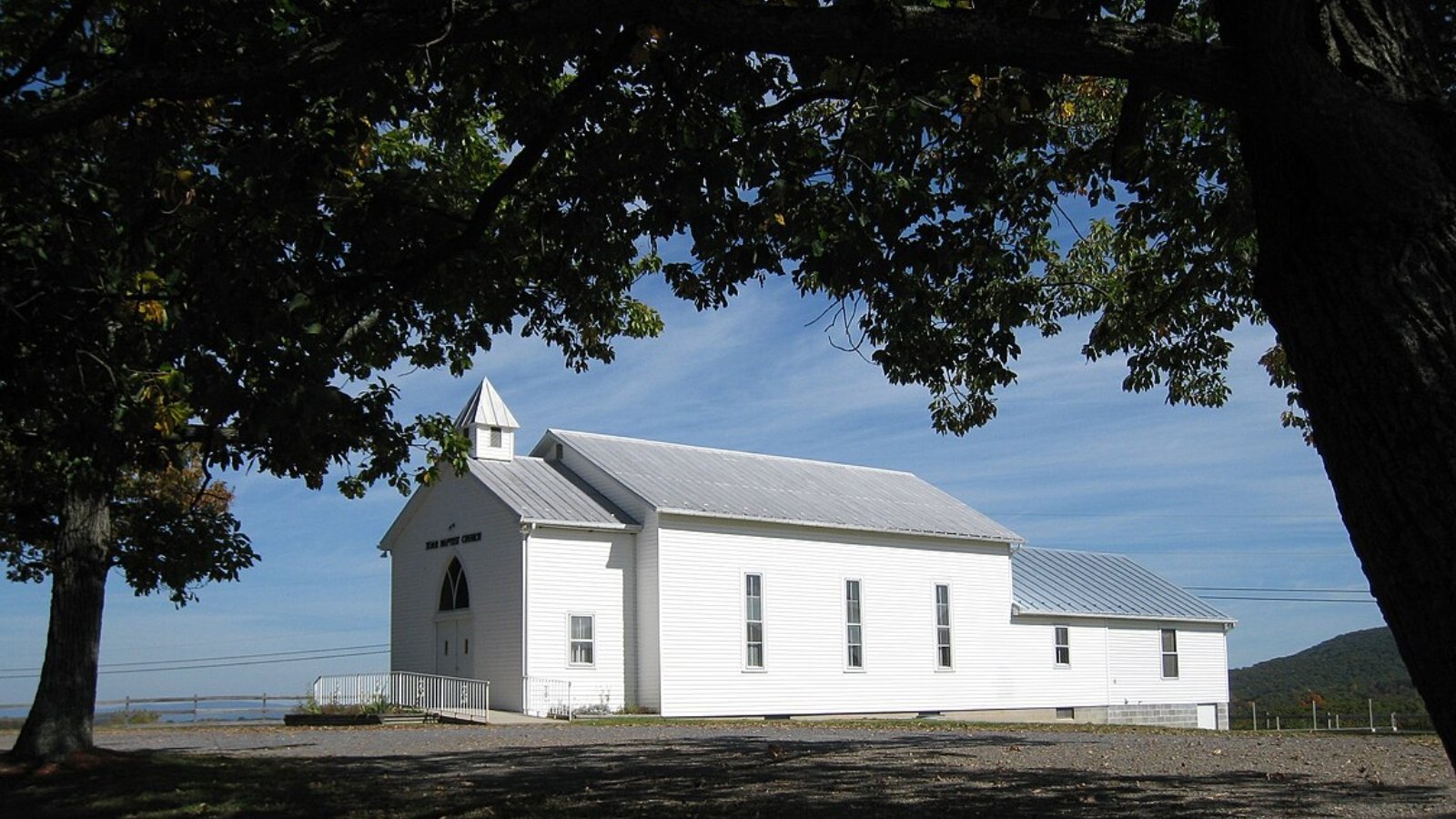
Why Are People Willing to Pay So Much to Live Here? What’s Special About It?
High View lives up to its name with elevated terrain offering stunning Appalachian mountain vistas that attract buyers seeking scenic rural living. The community provides a peaceful lifestyle while maintaining reasonable commuting distance to Winchester, Virginia and regional employment centers. Larger lots and custom home opportunities appeal to buyers wanting privacy and space without complete isolation.
How High View Rose to Prominence
High View developed as part of Hampshire County’s transition from purely agricultural use to residential development serving the Winchester metropolitan area. The community’s elevation and scenic location made it attractive to buyers seeking mountain views and rural character while staying within commuting distance of Virginia employment centers. Growth accelerated as remote work options increased, allowing more people to prioritize scenic locations over proximity to offices.
3 Interesting Tidbits
1. Mountain Views – The community’s elevated position provides panoramic views of the surrounding Appalachian landscape, a key selling point for properties.
2. Winchester Access – High View sits within the Winchester, VA metropolitan area, providing access to larger city amenities while maintaining rural character.
3. Growth Timing – The community’s most significant appreciation occurred during the 2020-2022 period when remote work trends increased demand for scenic rural properties.
27. Lost City – 75% Home Price Increase Since 2010
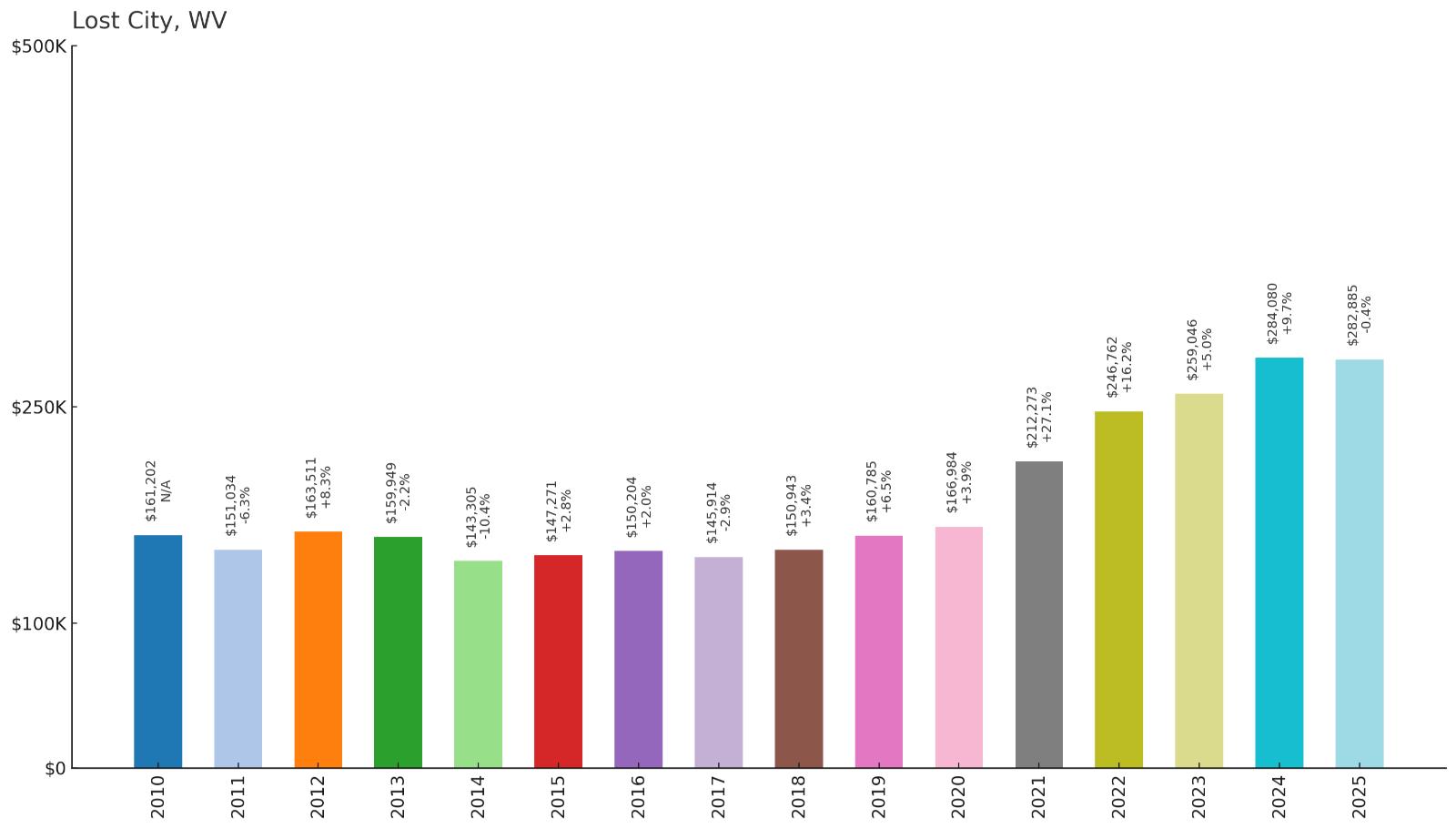
- 2010: $161,202
- 2011: $151,034
- 2012: $163,511
- 2013: $159,949
- 2014: $143,305
- 2015: $147,271
- 2016: $150,204
- 2017: $145,914
- 2018: $150,943
- 2019: $160,785
- 2020: $166,984
- 2021: $212,273
- 2022: $246,762
- 2023: $259,046
- 2024: $284,080
- 2025: $282,885
Lost City experienced significant volatility through 2018, including notable dips in 2011, 2014, and 2017 before finding stability around 2019. The pandemic years brought dramatic appreciation, with the community gaining over $45,000 in value between 2020 and 2021. Current prices near $283,000 represent substantial growth despite the market’s earlier instability.
Why Lost City?
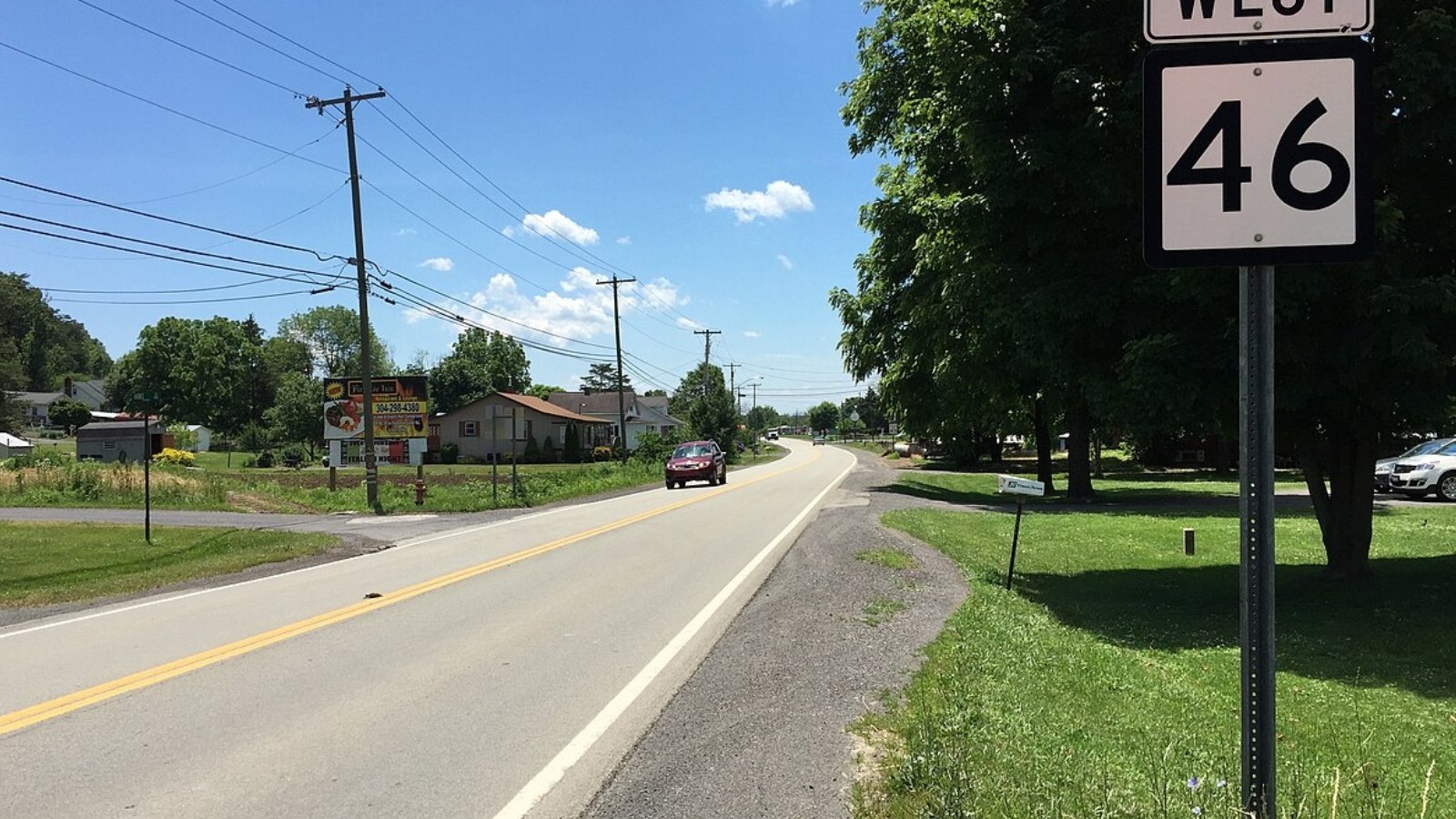
Why Are People Willing to Pay So Much to Live Here? What’s Special About It?
Lost City appeals to buyers seeking unique natural beauty and outdoor recreation opportunities in a distinctive West Virginia setting. The area’s name and geography create intrigue while offering access to hiking, fishing, and mountain activities that attract outdoor enthusiasts. Properties tend to offer more land and privacy than suburban alternatives, appealing to buyers wanting space and character.
How Lost City Rose to Prominence
Lost City’s prominence grew from its unique natural features and location within Hardy County’s scenic landscape. The area attracted attention from outdoor recreation enthusiasts and those seeking distinctive properties with character and history. Recent growth reflects broader trends toward rural living and the appeal of communities with natural amenities and recreational access, particularly as remote work made location flexibility more practical.
3 Interesting Tidbits
1. Unique Name – The “Lost City” name adds mystique and marketing appeal that distinguishes it from typical residential communities.
2. Natural Features – The area is known for distinctive rock formations and geological features that enhance its recreational and scenic appeal.
3. Market Recovery – After years of price volatility, Lost City found stability and strong growth beginning around 2019, coinciding with increased interest in rural properties.
26. Points – 98% Home Price Increase Since 2010
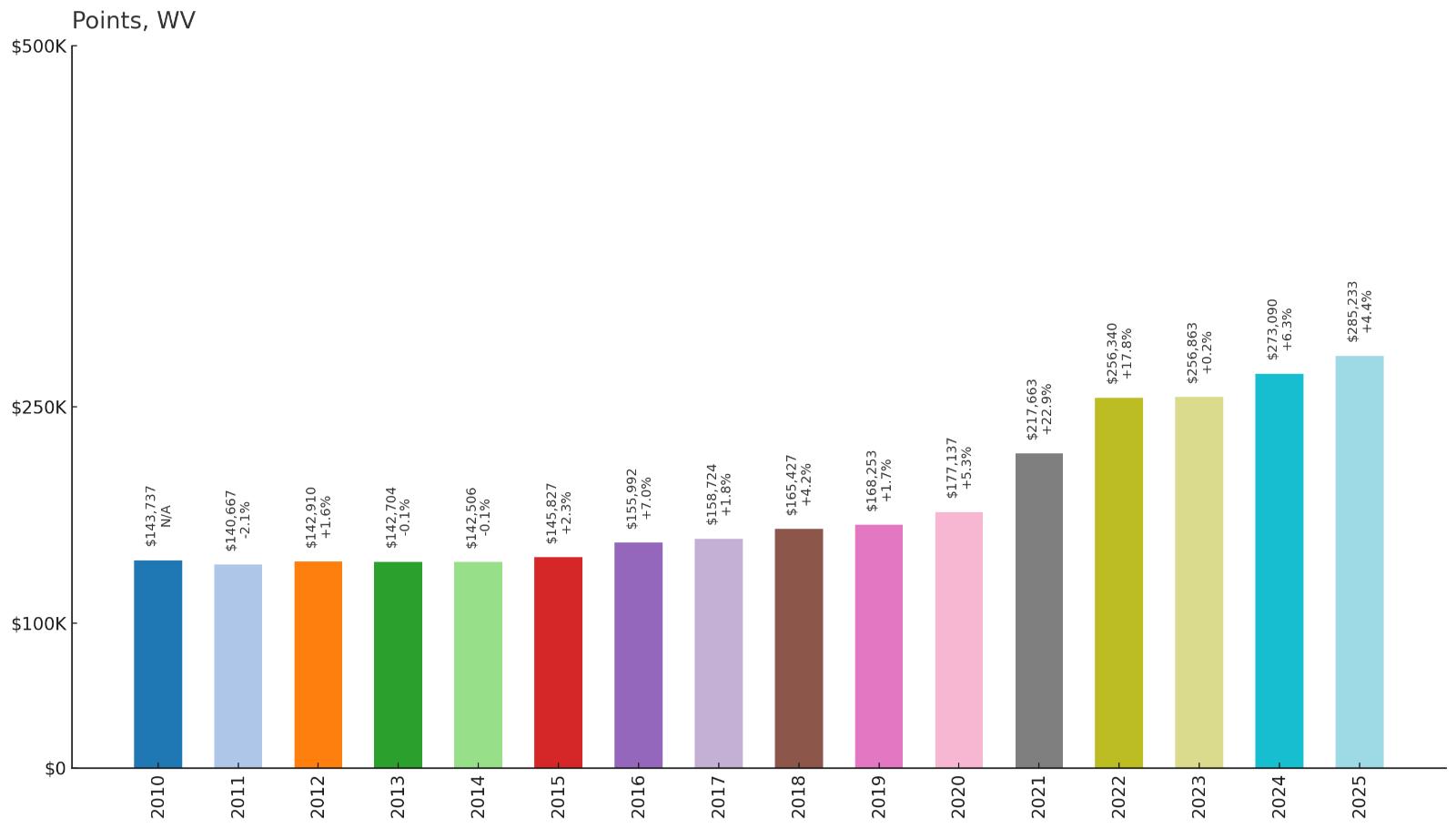
- 2010: $143,737
- 2011: $140,667
- 2012: $142,910
- 2013: $142,704
- 2014: $142,506
- 2015: $145,827
- 2016: $155,992
- 2017: $158,724
- 2018: $165,427
- 2019: $168,253
- 2020: $177,137
- 2021: $217,663
- 2022: $256,340
- 2023: $256,863
- 2024: $273,090
- 2025: $285,233
Points remained remarkably stable through 2015, with prices hovering around $142,000-$145,000 before beginning steady growth. The community nearly doubled in value since 2010, with the most dramatic increases occurring during 2021-2022 when prices jumped over $40,000 annually. Current values approaching $285,000 represent consistent upward momentum.
Why Points?
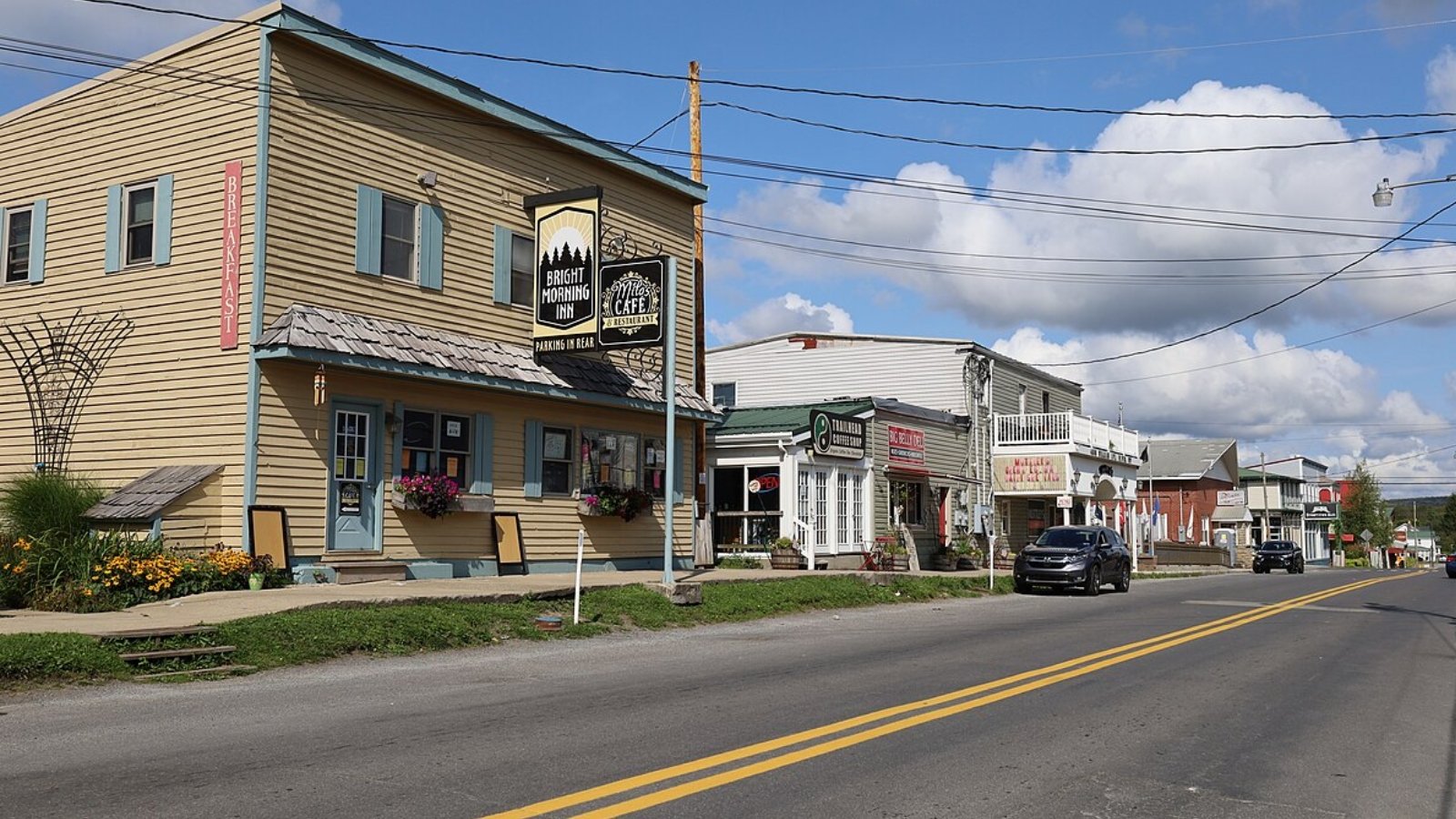
Why Are People Willing to Pay So Much to Live Here? What’s Special About It?
Points attracts buyers with its combination of affordability and growth potential in a community that has nearly doubled in value over 15 years. The area offers rural character with convenient access to regional employment and amenities, appealing to families seeking space and value. Lower entry costs compared to more established communities make it attractive to first-time buyers and investors.
How Points Rose to Prominence
Points developed as part of West Virginia’s broader residential expansion, particularly benefiting from spillover demand as buyers sought alternatives to higher-priced markets. The community’s steady appreciation and eventual dramatic growth during the pandemic years established it as a notable market for both residents and investors. Its rise reflects the broader trend of buyers discovering value in previously overlooked West Virginia communities.
3 Interesting Tidbits
1. Price Stability – Points showed remarkable price stability for five years (2010-2015) before entering sustained growth mode.
2. Investment Appeal – The community’s 98% appreciation since 2010 makes it one of the strongest performers for long-term real estate investment.
3. Market Timing – Points benefited significantly from pandemic-era market dynamics, with values increasing over 60% between 2020 and 2025.
25. Scott Depot – 62% Home Price Increase Since 2010
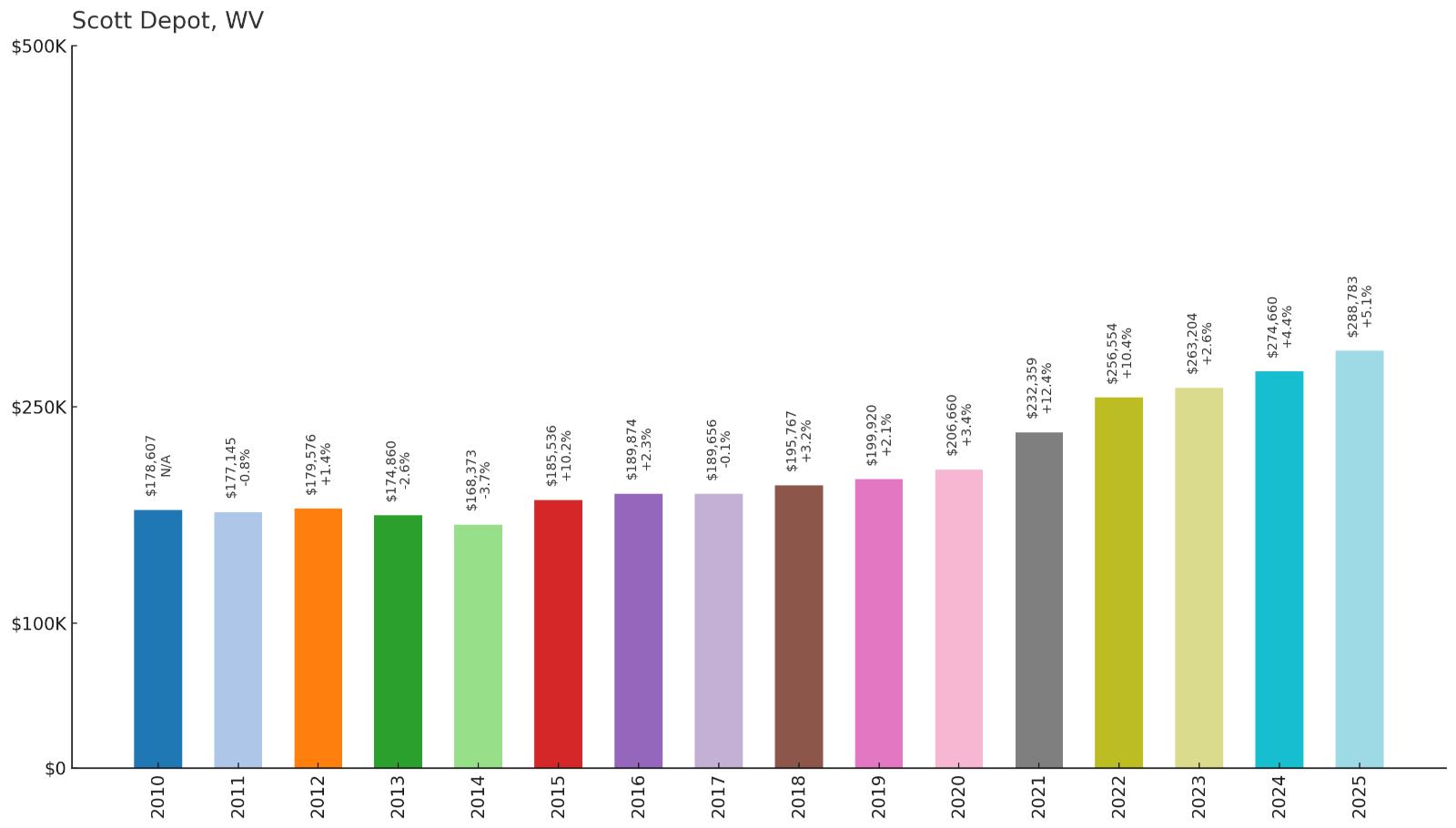
- 2010: $178,607
- 2011: $177,145
- 2012: $179,576
- 2013: $174,860
- 2014: $168,373
- 2015: $185,536
- 2016: $189,874
- 2017: $189,656
- 2018: $195,767
- 2019: $199,920
- 2020: $206,660
- 2021: $232,359
- 2022: $256,554
- 2023: $263,204
- 2024: $274,660
- 2025: $288,783
Scott Depot experienced a mid-decade dip in 2014 before recovering and maintaining steady growth through 2020. The community saw strong acceleration during pandemic years, gaining over $50,000 in value between 2020 and 2022. Current prices near $289,000 reflect consistent demand and the area’s appeal to families seeking suburban amenities with reasonable access to Huntington and Charleston.
Why Scott Depot?
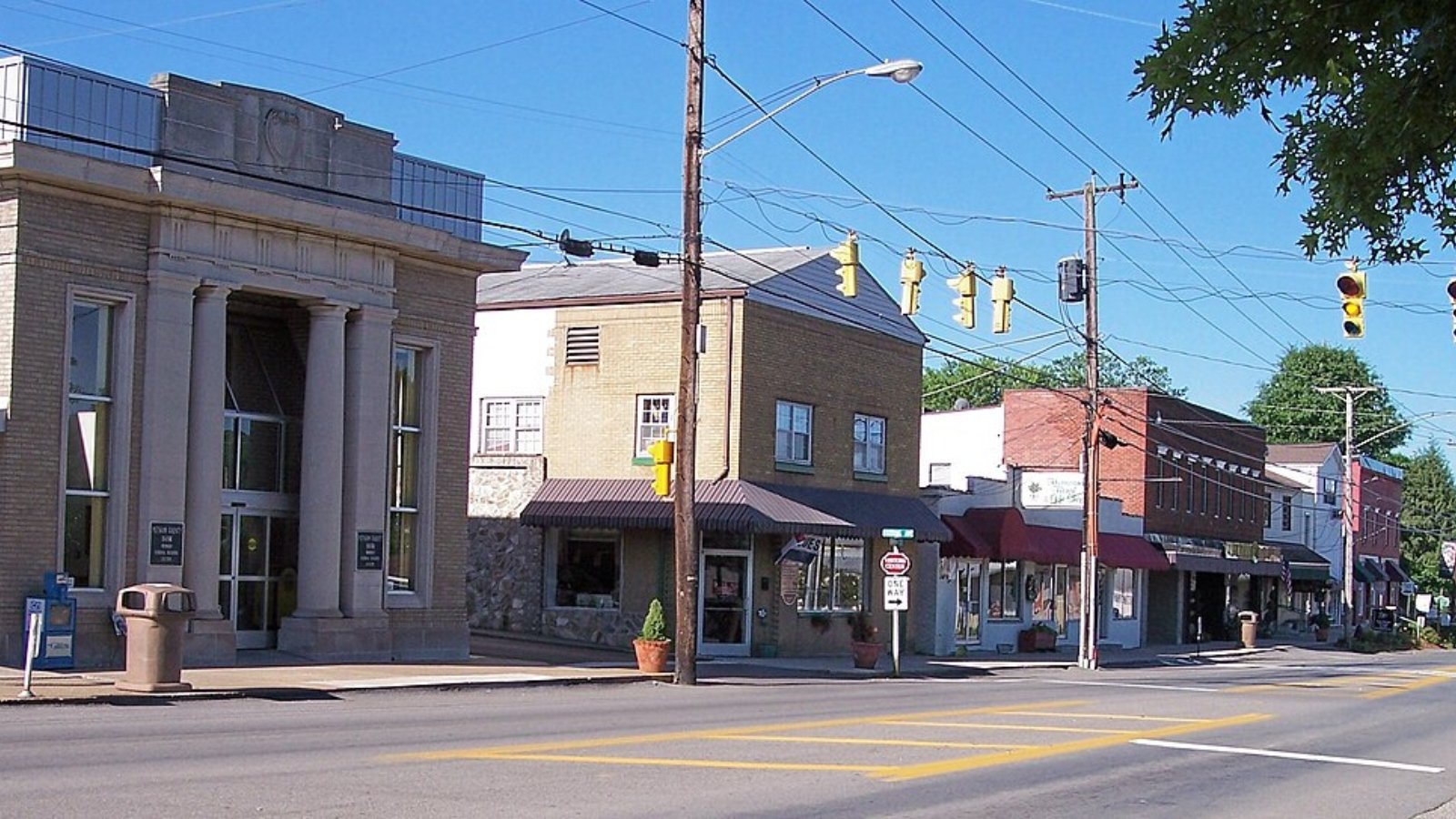
Why Are People Willing to Pay So Much to Live Here? What’s Special About It?
Scott Depot attracts families seeking suburban lifestyle with good schools, shopping, and recreational facilities while maintaining reasonable commuting distance to major employment centers. The community offers newer housing developments and amenities that appeal to middle-class families wanting convenience and quality of life. Its location provides access to both Charleston and Huntington job markets while avoiding urban congestion.
How Scott Depot Rose to Prominence
Scott Depot developed as a planned suburban community in Putnam County, benefiting from its strategic location between Charleston and Huntington. The area attracted families and professionals seeking modern amenities and good schools while maintaining reasonable commuting distances to major employment centers. Its growth reflects the broader trend toward suburban development in West Virginia’s more populated regions.
3 Interesting Tidbits
1. Retail Hub – Scott Depot features significant retail development including shopping centers and restaurants that serve the broader Putnam County area.
2. School Quality – The community is served by highly-rated Putnam County schools, a major draw for families with children.
3. Strategic Location – Scott Depot’s position along Interstate 64 provides convenient access to both Charleston and Huntington metropolitan areas.
24. Ghent – 79% Home Price Increase Since 2010
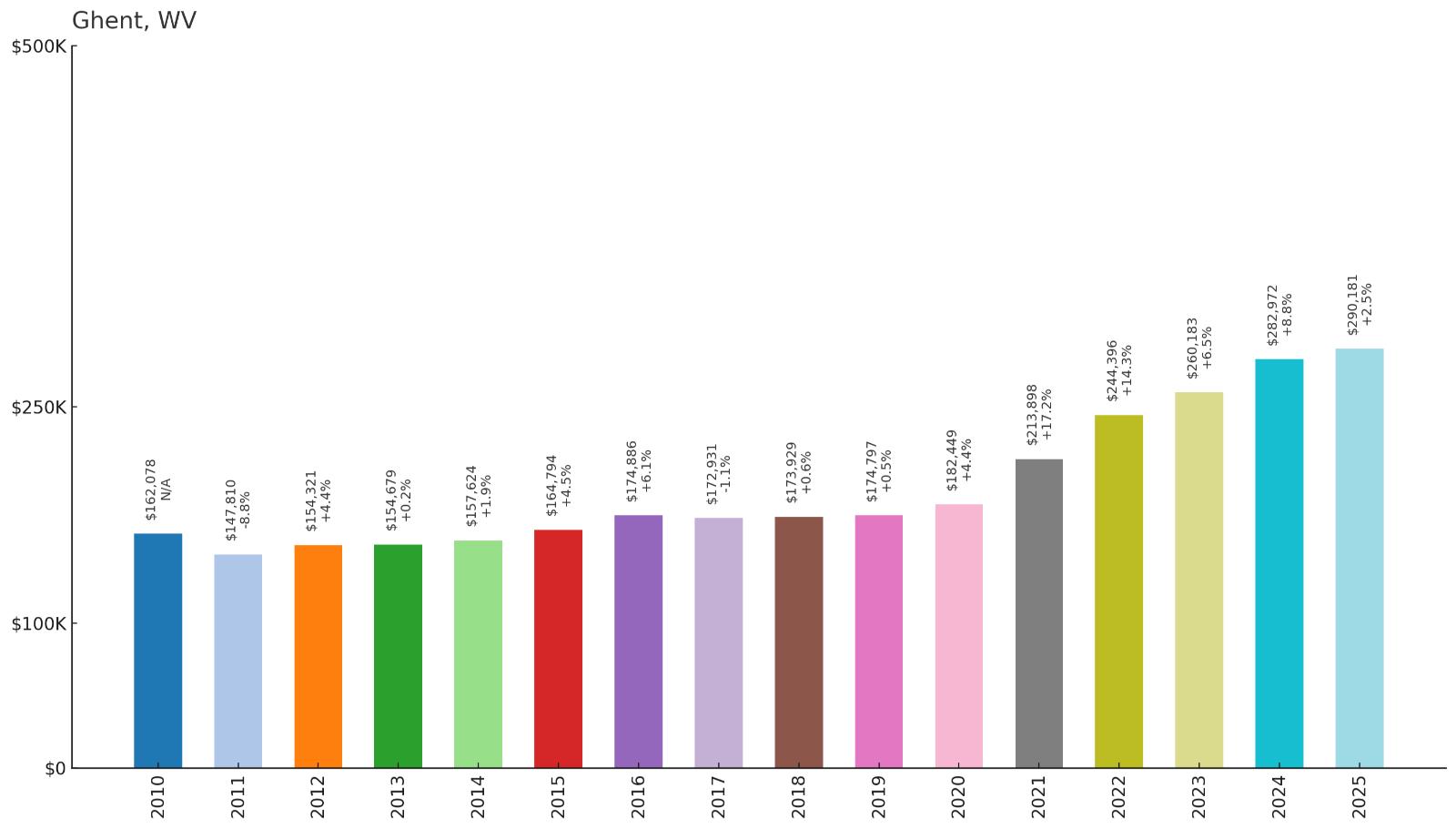
- 2010: $162,078
- 2011: $147,810
- 2012: $154,321
- 2013: $154,679
- 2014: $157,624
- 2015: $164,794
- 2016: $174,886
- 2017: $172,931
- 2018: $173,929
- 2019: $174,797
- 2020: $182,449
- 2021: $213,898
- 2022: $244,396
- 2023: $260,183
- 2024: $282,972
- 2025: $290,181
Ghent recovered from an early 2011 decline and maintained steady, gradual appreciation through 2020 with remarkable consistency. The pandemic years brought significant acceleration, with values increasing over $100,000 between 2020 and 2025. Current prices near $290,000 represent strong market performance in this Raleigh County community.
Why Ghent?
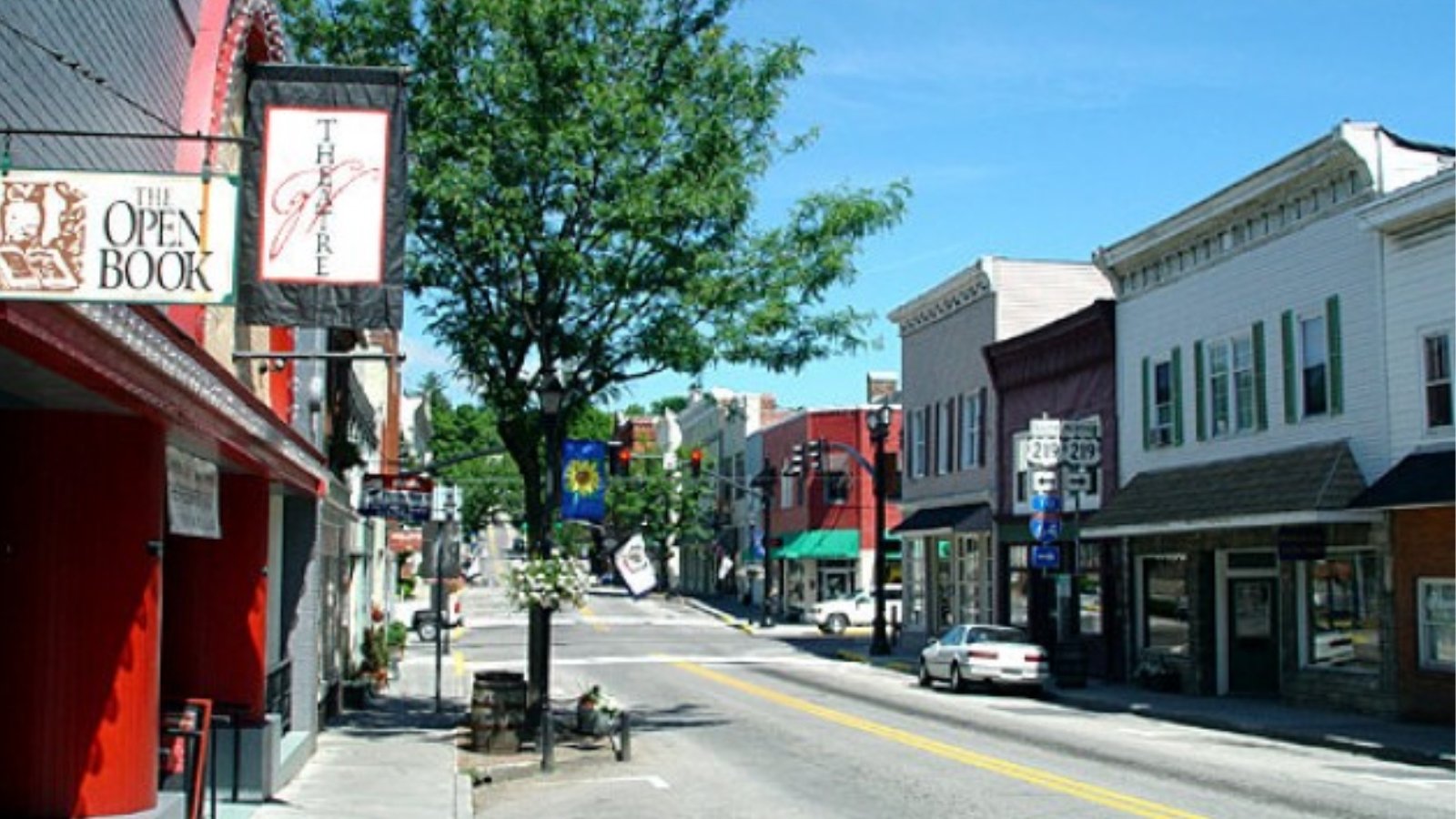
Why Are People Willing to Pay So Much to Live Here? What’s Special About It?
Ghent appeals to buyers seeking small-town character within the Beckley metropolitan area, offering rural atmosphere with access to employment and services. The community provides affordable entry into homeownership while showing strong appreciation potential for long-term residents. Its location offers outdoor recreation opportunities while maintaining connection to regional economic centers.
How Ghent Rose to Prominence
Ghent developed as part of Raleigh County’s residential expansion, serving families and workers connected to the Beckley area’s economy. The community benefited from the broader trend toward suburban and rural living, particularly as buyers sought value and space outside traditional urban centers. Recent growth reflects both local economic stability and broader market trends favoring smaller communities.
3 Interesting Tidbits
1. Beckley Metro – Ghent sits within the Beckley metropolitan area, providing access to regional employment and services while maintaining rural character.
2. Coal Heritage – The area reflects West Virginia’s coal mining heritage while adapting to modern residential and economic development.
3. Steady Growth – Despite early volatility, Ghent showed remarkable price stability from 2013-2020 before accelerating during the pandemic era.
23. Ranson – 130% Home Price Increase Since 2010

- 2010: $126,280
- 2011: $118,945
- 2012: $122,474
- 2013: $131,423
- 2014: $139,297
- 2015: $142,163
- 2016: $149,365
- 2017: $161,228
- 2018: $171,774
- 2019: $178,588
- 2020: $185,756
- 2021: $223,855
- 2022: $250,663
- 2023: $255,641
- 2024: $278,826
- 2025: $290,513
Ranson recovered from early market softness and achieved consistent growth year-over-year since 2012. The community more than doubled in value over 15 years, with particularly strong gains during 2017-2018 and again during the pandemic years. Current values exceeding $290,000 reflect its position within the Washington D.C. metropolitan statistical area.
Why Ranson?
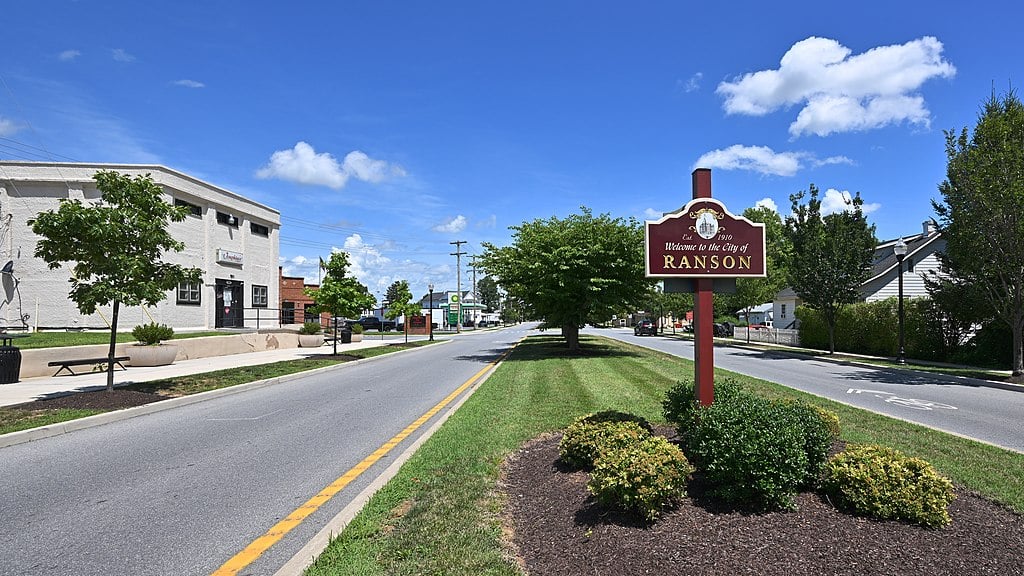
Why Are People Willing to Pay So Much to Live Here? What’s Special About It?
Ranson attracts buyers seeking proximity to Washington D.C. employment while enjoying West Virginia’s lower cost of living and rural character. The community offers newer housing developments and suburban amenities that appeal to commuters and families relocating from more expensive metropolitan areas. Its Jefferson County location provides access to excellent schools and growing retail and service sectors.
How Ranson Rose to Prominence
Ranson benefited significantly from its inclusion in the Washington D.C. metropolitan statistical area, attracting commuters seeking affordable alternatives to Virginia and Maryland housing markets. The community’s growth accelerated as transportation improvements and remote work options made longer commutes more feasible. Development of retail, schools, and services created a complete suburban environment attractive to families and professionals.
3 Interesting Tidbits
1. D.C. Metro Area – Ranson is officially part of the Washington-Arlington-Alexandria metropolitan statistical area, providing access to high-paying federal and contractor jobs.
2. Outdoor Recreation – The town offers proximity to the Appalachian Trail, Potomac River, and Shenandoah River for hiking, fishing, and water sports.
3. Retail Growth – Ranson has seen significant commercial development including shopping centers and restaurants serving the broader Jefferson County area.
22. Bloomery – 77% Home Price Increase Since 2010
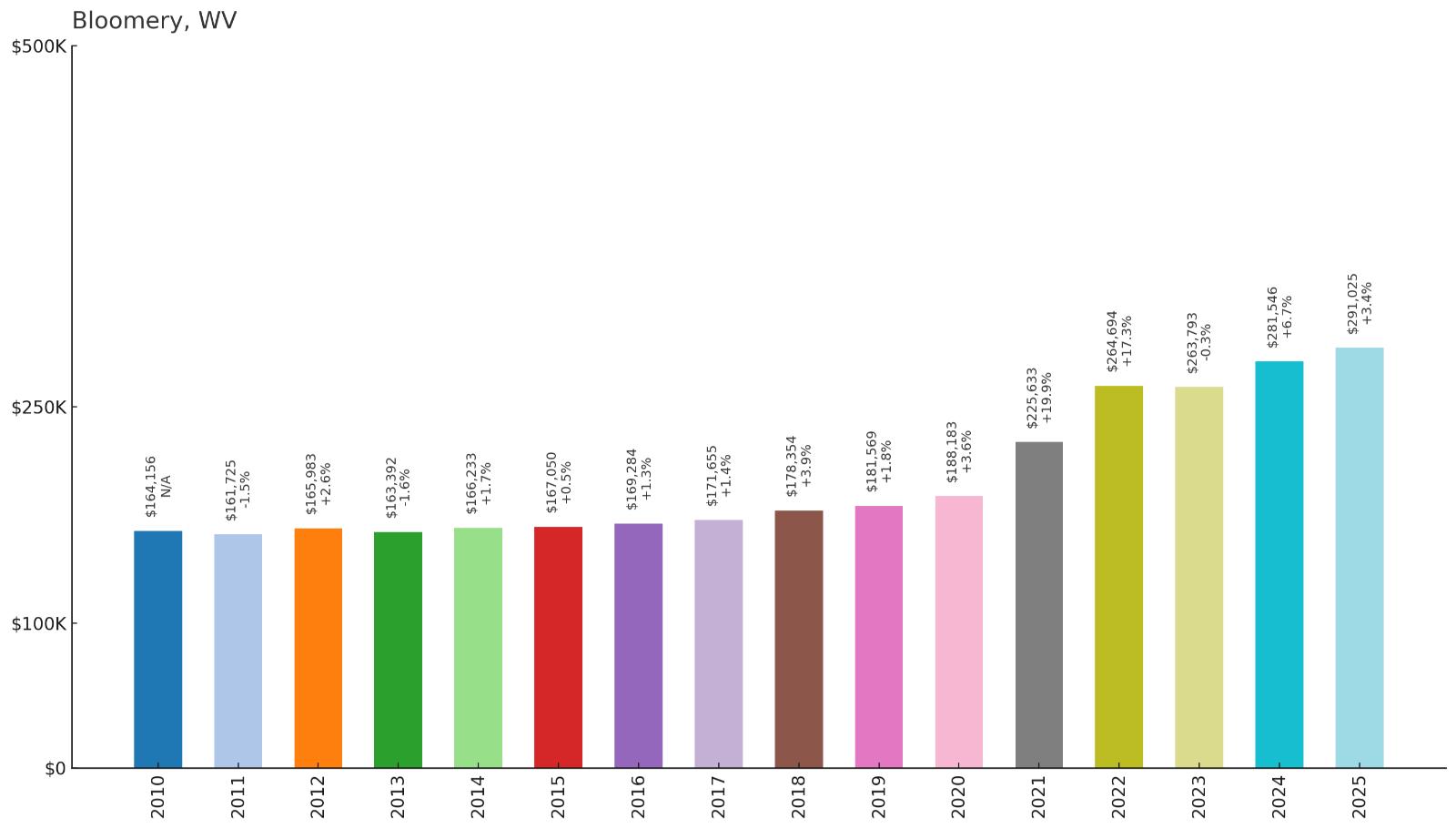
- 2010: $164,156
- 2011: $161,725
- 2012: $165,983
- 2013: $163,392
- 2014: $166,233
- 2015: $167,050
- 2016: $169,284
- 2017: $171,655
- 2018: $178,354
- 2019: $181,569
- 2020: $188,183
- 2021: $225,633
- 2022: $264,694
- 2023: $263,793
- 2024: $281,546
- 2025: $291,025
Bloomery shows exceptional market stability with consistent gradual appreciation from 2010 through 2020. The community experienced its most significant growth during 2021-2022, gaining over $75,000 in value during that period. Current prices near $291,000 reflect steady demand for properties in this Winchester metropolitan area location.
Why Bloomery?
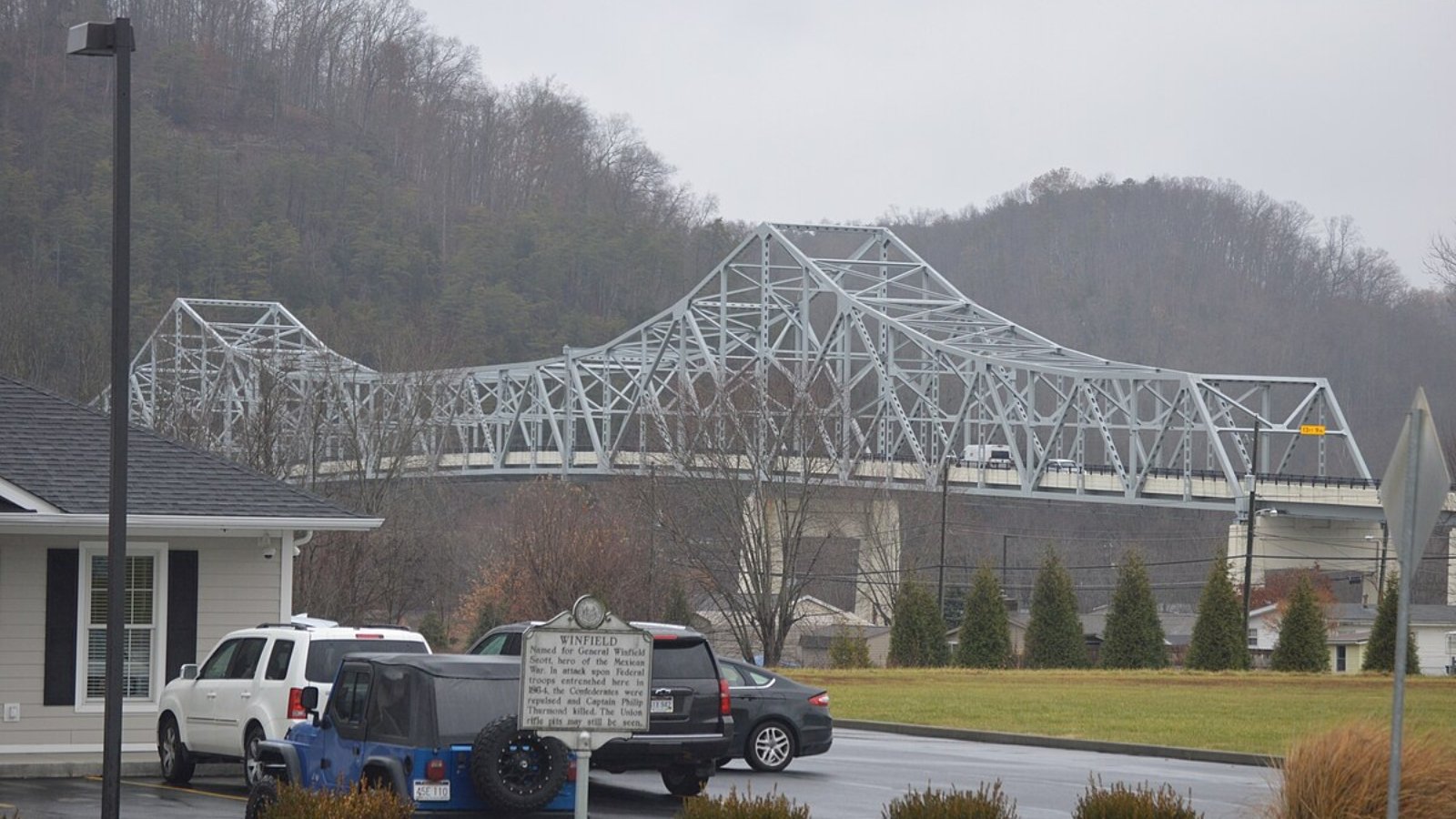
Why Are People Willing to Pay So Much to Live Here? What’s Special About It?
Bloomery offers rural character with scenic mountain views while maintaining access to Winchester, Virginia employment and amenities. The community appeals to buyers seeking larger lots and custom home opportunities without complete isolation from urban conveniences. Its Hampshire County location provides outdoor recreation access while serving commuters working in the broader Washington metro region.
How Bloomery Rose to Prominence
Bloomery developed as part of Hampshire County’s residential expansion, serving buyers seeking alternatives to more expensive Virginia markets while maintaining reasonable commuting distance. The community’s scenic location and rural character attracted residents valuing space and natural beauty. Growth accelerated as remote work trends and housing market dynamics made rural locations more attractive to a broader range of buyers.
3 Interesting Tidbits
1. Market Stability – Bloomery showed remarkable price consistency for a decade before experiencing rapid appreciation during the pandemic years.
2. Winchester Metro – The community sits within the Winchester, VA metropolitan area, providing access to Virginia employment while maintaining West Virginia character.
3. Rural Appeal – Bloomery attracts buyers seeking countryside living with mountain views and larger properties than typical suburban developments offer.
21. Winfield – 60% Home Price Increase Since 2010
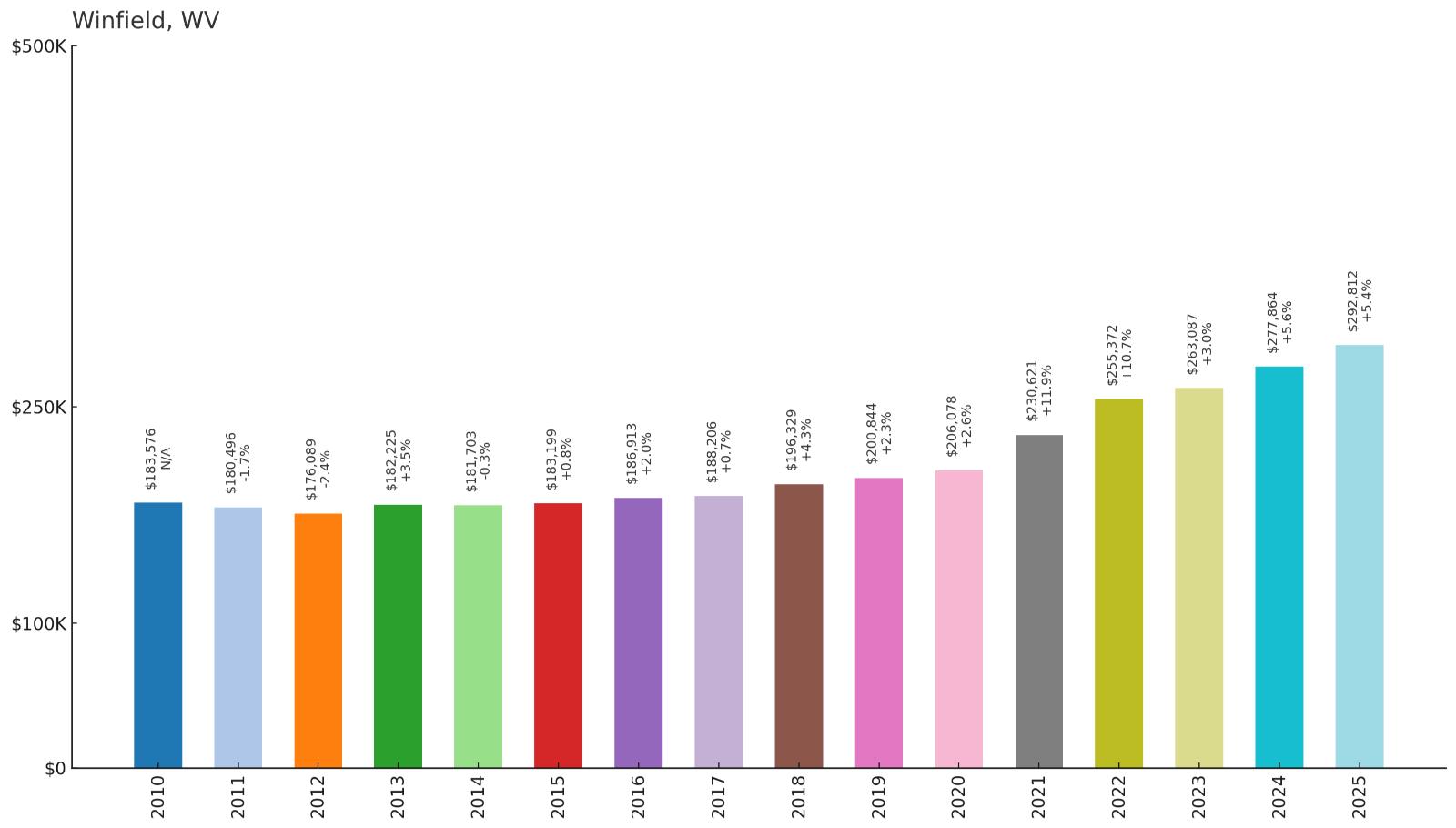
- 2010: $183,576
- 2011: $180,496
- 2012: $176,089
- 2013: $182,225
- 2014: $181,703
- 2015: $183,199
- 2016: $186,913
- 2017: $188,206
- 2018: $196,329
- 2019: $200,844
- 2020: $206,078
- 2021: $230,621
- 2022: $255,372
- 2023: $263,087
- 2024: $277,864
- 2025: $292,812
Winfield maintained relative stability through 2020 with gradual but consistent appreciation, avoiding major volatility during market fluctuations. The community saw strong growth during pandemic years, gaining over $85,000 in value between 2020 and 2025. Current prices approaching $293,000 reflect its appeal within the Huntington-Ashland metropolitan area.
Why Winfield?
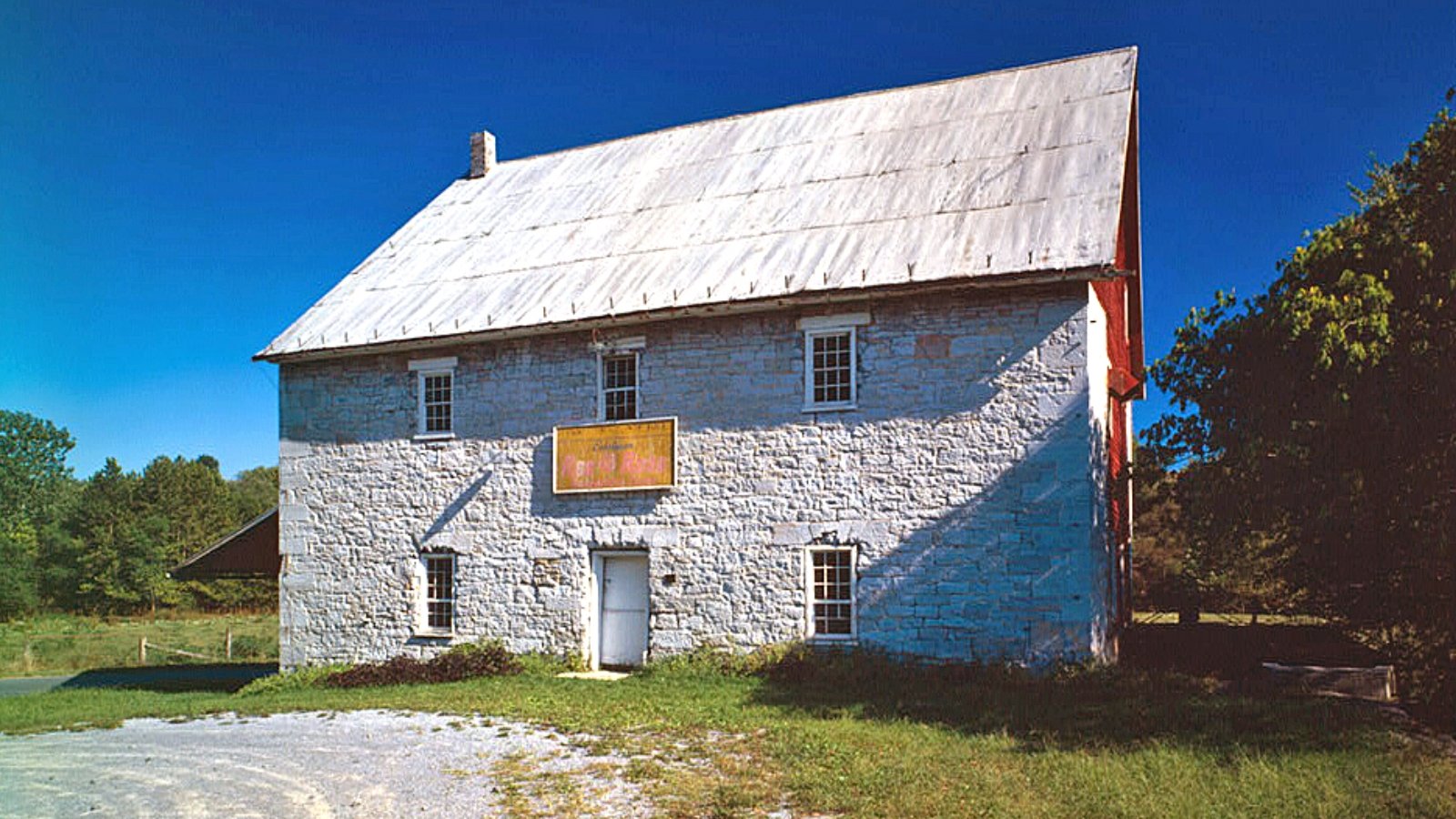
Why Are People Willing to Pay So Much to Live Here? What’s Special About It?
Winfield attracts families seeking suburban amenities with small-town character within the Huntington metropolitan area. The community offers good schools, recreational facilities, and convenient shopping while maintaining reasonable commuting distance to major employment centers. Its Putnam County location provides access to both Charleston and Huntington job markets with quality residential neighborhoods.
How Winfield Rose to Prominence
Winfield developed as part of Putnam County’s suburban expansion, serving families and professionals working in the Huntington-Charleston corridor. The community benefited from planned development including schools, parks, and retail facilities that created an attractive residential environment. Its growth reflects the broader trend toward suburban living in West Virginia’s more populous regions.
3 Interesting Tidbits
1. Metro Access – Winfield sits within the Huntington-Ashland metropolitan area, providing access to employment in both West Virginia and Kentucky.
2. Suburban Planning – The community features planned residential development with attention to schools, parks, and neighborhood amenities.
3. Market Resilience – Winfield showed steady appreciation without major volatility, demonstrating market stability attractive to long-term residents.
20. Slanesville – 91% Home Price Increase Since 2010

- 2010: $154,158
- 2011: $150,633
- 2012: $154,982
- 2013: $154,089
- 2014: $156,309
- 2015: $161,194
- 2016: $170,887
- 2017: $173,322
- 2018: $177,913
- 2019: $178,456
- 2020: $185,804
- 2021: $221,907
- 2022: $257,183
- 2023: $266,079
- 2024: $284,043
- 2025: $294,170
Slanesville showed steady but modest growth through 2020, with values remaining relatively stable around $150,000-$180,000 for most of the decade. The pandemic years brought dramatic appreciation, with the community gaining over $100,000 in value between 2020 and 2025. Current prices near $294,000 represent strong performance in this Winchester metropolitan area location.
Why Slanesville?
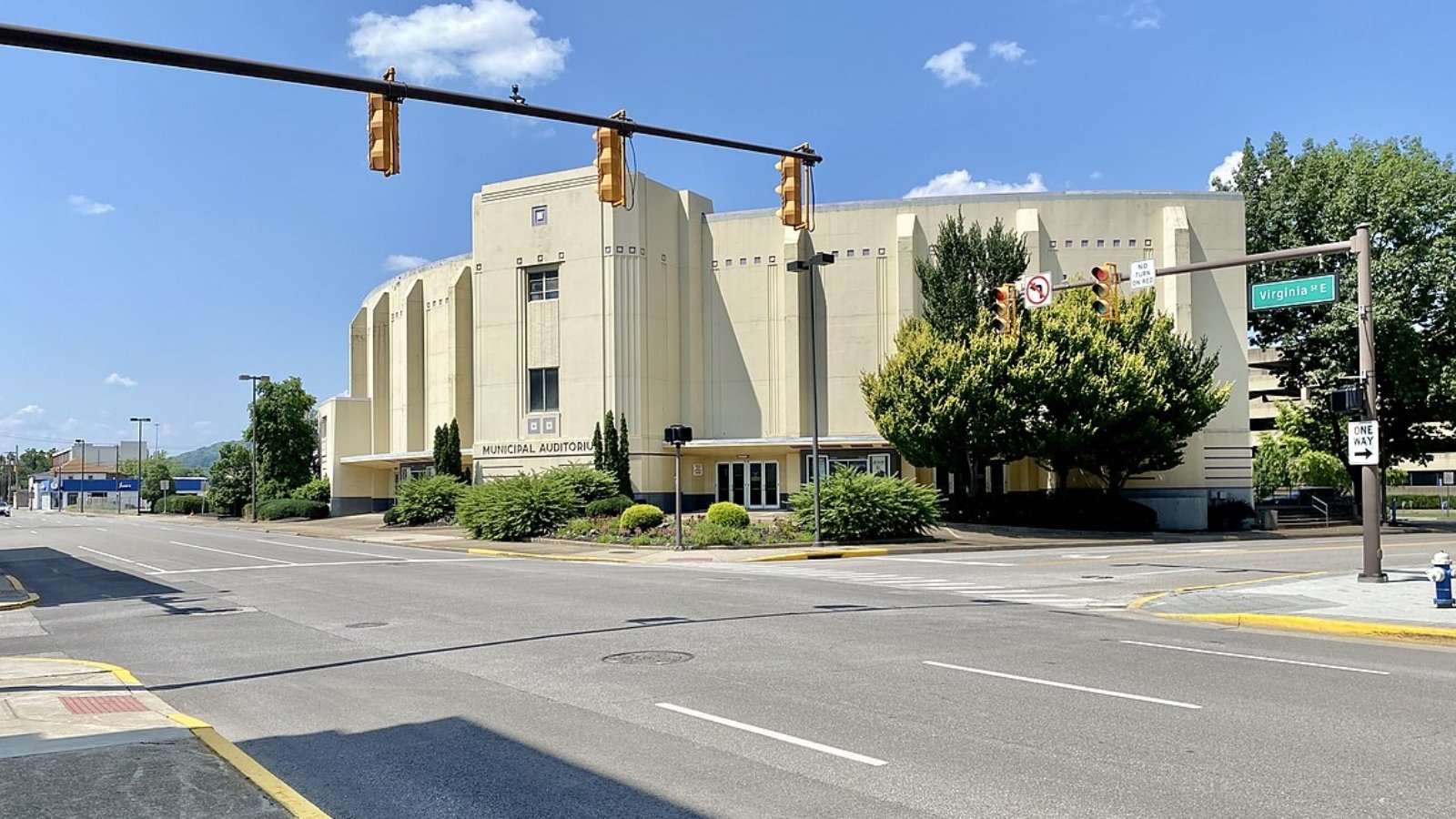
Why Are People Willing to Pay So Much to Live Here? What’s Special About It?
Slanesville attracts buyers seeking rural mountain living with scenic beauty while maintaining access to Winchester, Virginia employment opportunities. The community offers larger properties and custom home sites that appeal to those wanting space and privacy. Its Hampshire County location provides outdoor recreation access while serving commuters working throughout the four-state region.
How Slanesville Rose to Prominence
Slanesville developed as part of Hampshire County’s appeal to buyers seeking alternatives to Virginia’s higher-priced markets while maintaining reasonable commuting distance. The area’s natural beauty and rural character attracted residents valuing mountain views and outdoor access. Recent growth reflects broader market trends favoring scenic rural locations, particularly as remote work made location flexibility more practical.
3 Interesting Tidbits
1. Mountain Setting – Slanesville offers elevated terrain and mountain views that enhance property values and recreational opportunities.
2. Winchester Access – The community sits within the Winchester, VA metropolitan area, providing employment access while maintaining rural West Virginia character.
3. Growth Acceleration – After years of modest appreciation, Slanesville experienced rapid value increases during the 2020-2025 period, nearly doubling in price.
19. Lewisburg – 44% Home Price Increase Since 2010

- 2010: $205,247
- 2011: $176,788
- 2012: $172,008
- 2013: $152,923
- 2014: $161,640
- 2015: $170,421
- 2016: $175,383
- 2017: $182,210
- 2018: $188,064
- 2019: $192,133
- 2020: $201,704
- 2021: $234,528
- 2022: $264,798
- 2023: $269,229
- 2024: $281,417
- 2025: $295,348
Lewisburg experienced significant volatility during the early 2010s, dropping from over $205,000 to around $153,000 before beginning steady recovery in 2014. The community showed consistent growth through 2020 and accelerated during pandemic years to current values near $295,000. This pattern reflects both local economic adjustments and broader market recovery.
Why Lewisburg?
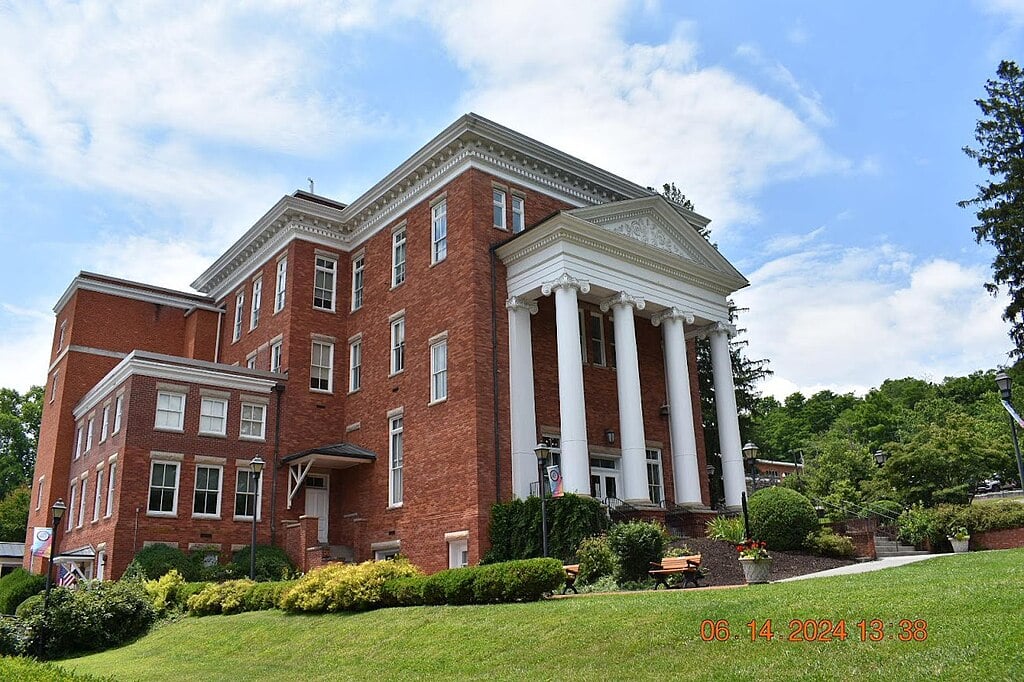
Why Are People Willing to Pay So Much to Live Here? What’s Special About It?
Lewisburg attracts buyers with its historic downtown charm, cultural amenities, and proximity to the West Virginia School of Osteopathic Medicine. The community offers small-town sophistication with art galleries, restaurants, and events that create a vibrant cultural scene. Its Greenbrier County location provides access to outdoor recreation while maintaining the amenities of a county seat.
How Lewisburg Rose to Prominence
Lewisburg’s prominence stems from its role as the Greenbrier County seat and its historic downtown district, which attracts both residents and visitors. The presence of the West Virginia School of Osteopathic Medicine brought educational and medical professionals to the area, stabilizing the economy and housing market. The community’s cultural development, including arts organizations and festivals, enhanced its appeal beyond traditional rural West Virginia communities.
3 Interesting Tidbits
1. Medical School – The West Virginia School of Osteopathic Medicine brings students, faculty, and medical professionals to the area, creating steady housing demand.
2. Historic District – Lewisburg’s historic downtown features 19th-century architecture and serves as a cultural and commercial hub for the region.
3. Cultural Hub – The community hosts numerous festivals and cultural events, including the Taste of Our Towns food festival and various arts celebrations.
18. Bridgeport – 62% Home Price Increase Since 2010
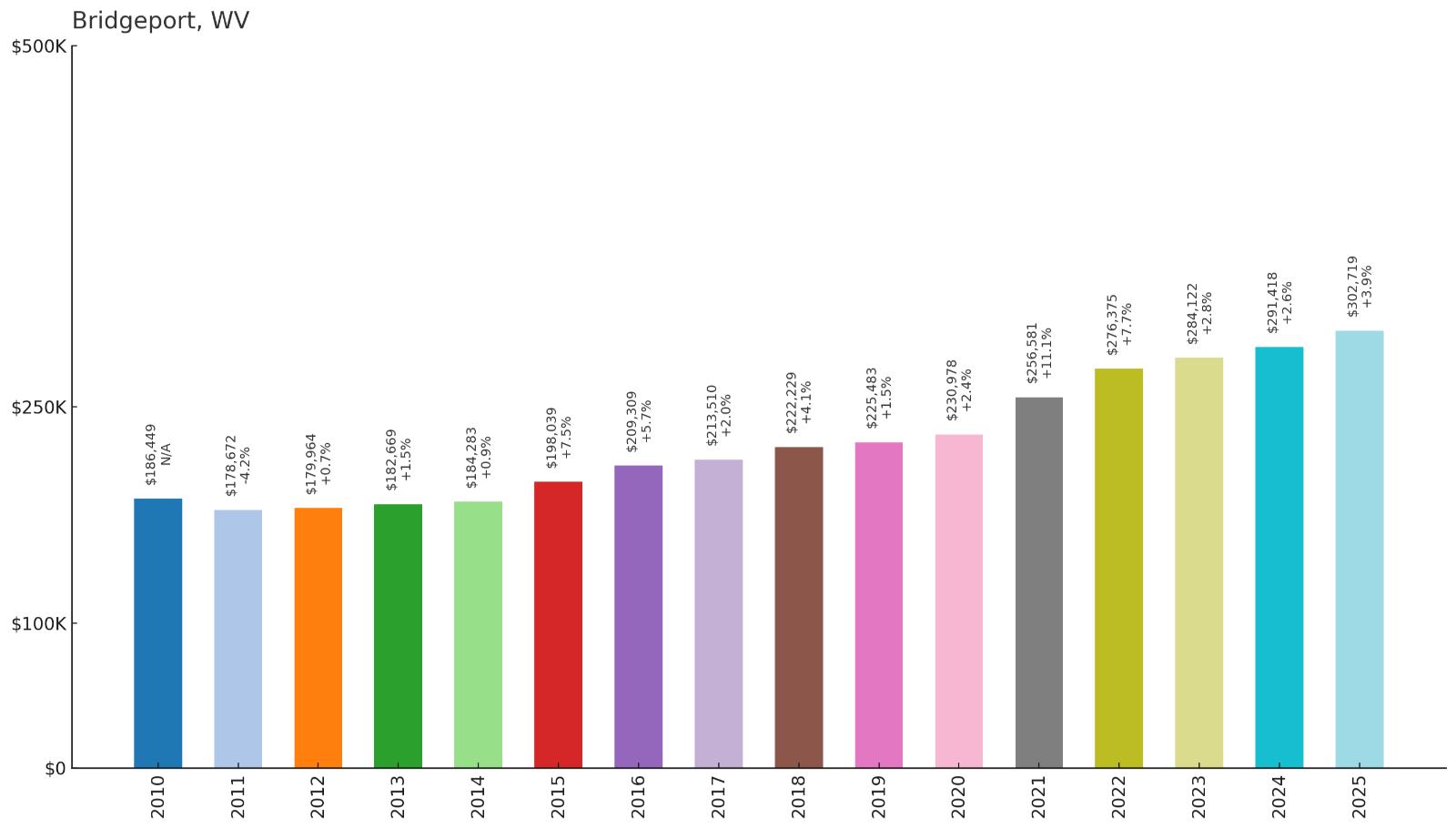
- 2010: $186,449
- 2011: $178,672
- 2012: $179,964
- 2013: $182,669
- 2014: $184,283
- 2015: $198,039
- 2016: $209,309
- 2017: $213,510
- 2018: $222,229
- 2019: $225,483
- 2020: $230,978
- 2021: $256,581
- 2022: $276,375
- 2023: $284,122
- 2024: $291,418
- 2025: $302,719
Bridgeport recovered from early market softness and maintained consistent upward momentum since 2012. The community showed steady appreciation through 2020 before accelerating during pandemic years to current values exceeding $302,000. This Harrison County location demonstrates the appeal of smaller cities with urban amenities and economic stability.
Why Bridgeport?
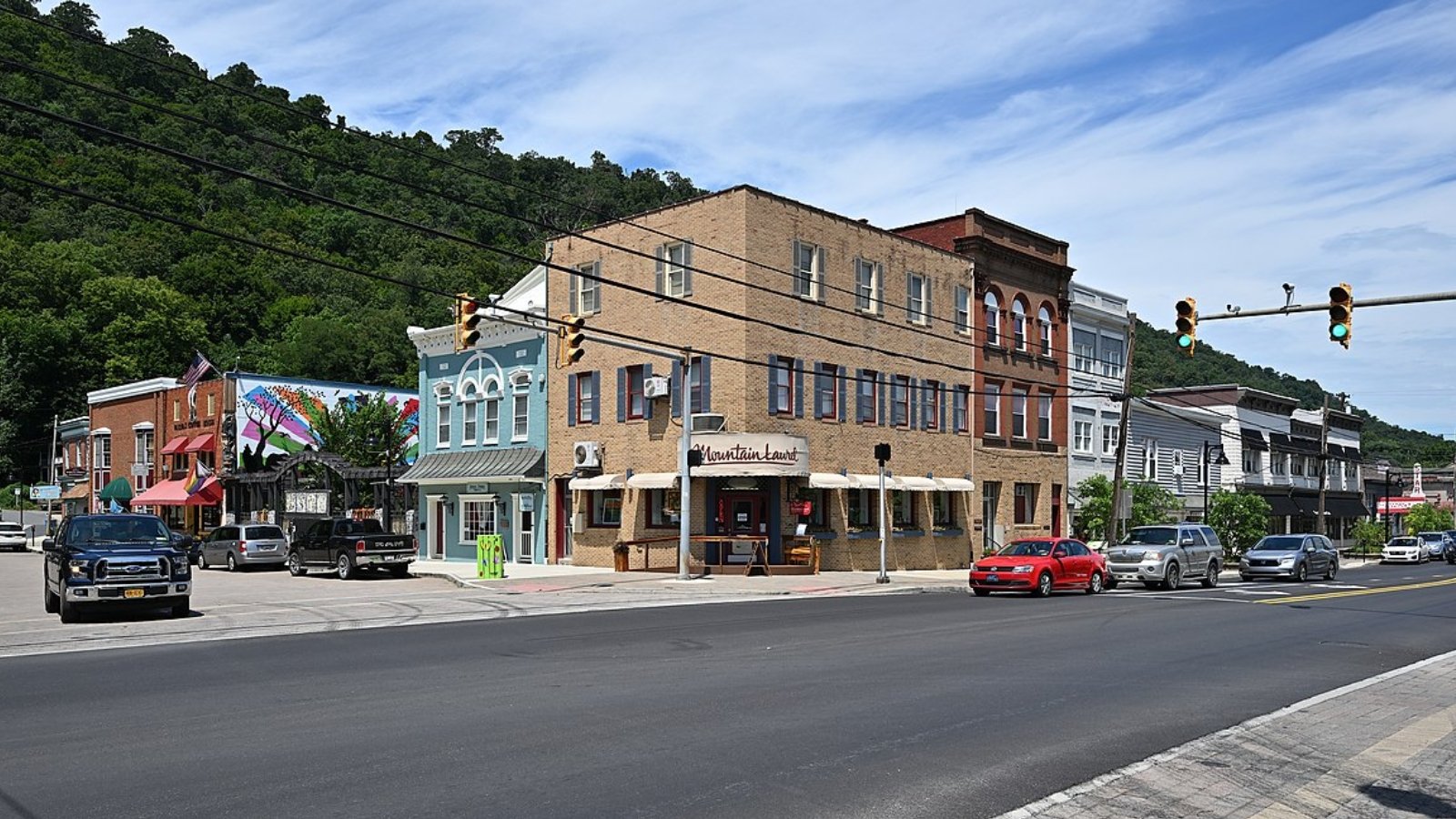
Why Are People Willing to Pay So Much to Live Here? What’s Special About It?
Bridgeport attracts residents seeking small-city amenities with convenient access to both Morgantown and Clarksburg employment markets. The community offers quality schools, shopping, and recreational facilities while maintaining reasonable living costs compared to larger metropolitan areas. Its central West Virginia location provides easy highway access throughout the state and region.
How Bridgeport Rose to Prominence
Bridgeport developed as a regional hub in Harrison County, benefiting from its location along major transportation corridors and proximity to larger employment centers. The community attracted families and professionals seeking quality of life amenities including good schools, parks, and retail development. Its growth reflects successful planning and development that created an attractive residential environment.
3 Interesting Tidbits
1. Regional Hub – Bridgeport serves as a commercial and residential center for the broader Harrison County area with significant retail development.
2. Transportation Access – The community benefits from excellent highway access, including Interstate 79, connecting residents to employment throughout the region.
3. Economic Stability – Bridgeport’s diversified economy and regional importance provide stability that supports consistent housing market growth.
17. Martinsburg – 100% Home Price Increase Since 2014
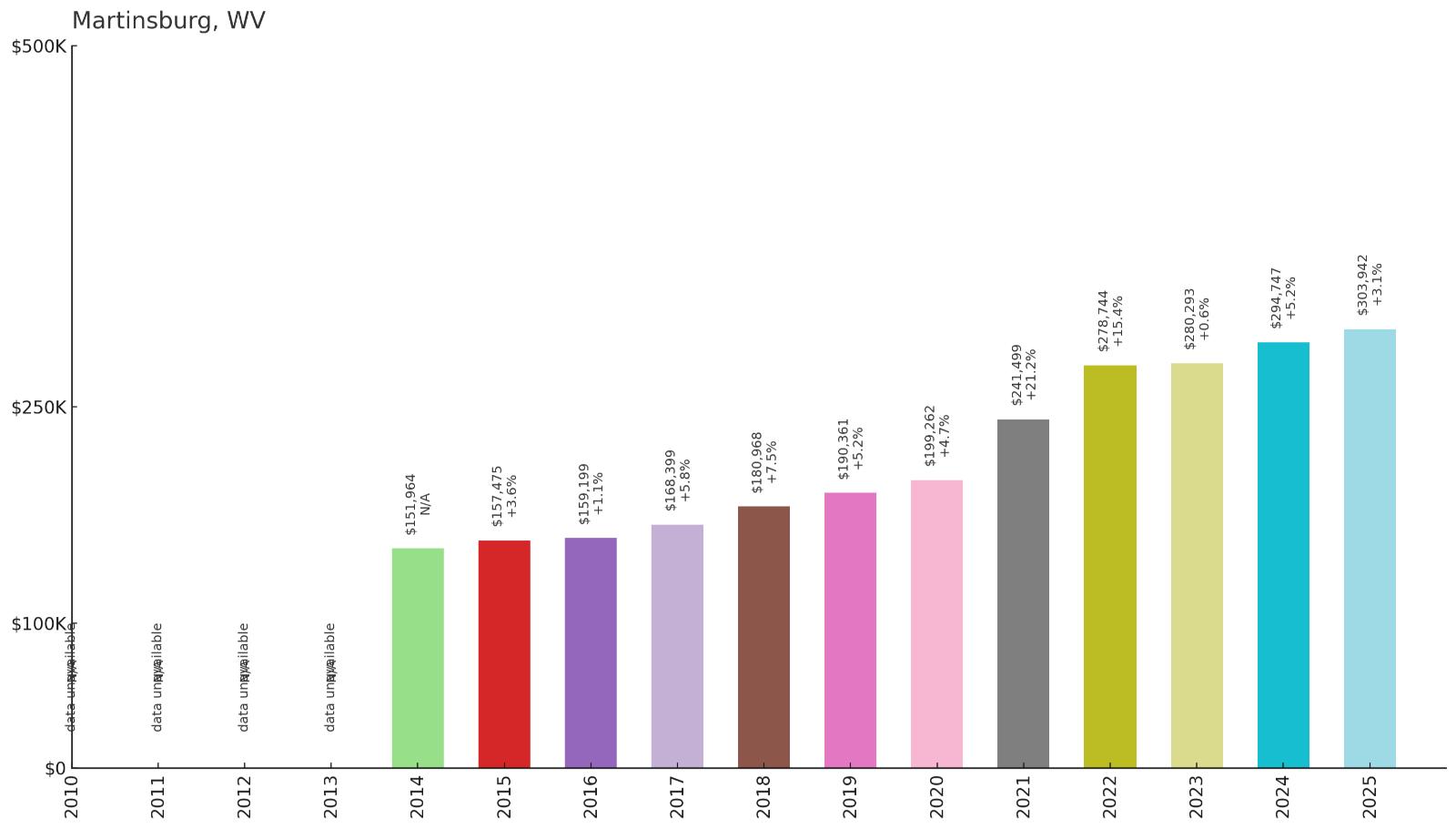
- 2010: N/A
- 2011: N/A
- 2012: N/A
- 2013: N/A
- 2014: $151,964
- 2015: $157,475
- 2016: $159,199
- 2017: $168,399
- 2018: $180,968
- 2019: $190,361
- 2020: $199,262
- 2021: $241,499
- 2022: $278,744
- 2023: $280,293
- 2024: $294,747
- 2025: $303,942
Martinsburg doubled in value between 2014 and 2025, showing consistent year-over-year growth with particularly strong gains during 2017-2018 and again during pandemic years. Values increased from around $152,000 to over $303,000, reflecting the city’s appeal within the Hagerstown-Martinsburg metropolitan area. This Berkeley County location demonstrates strong market fundamentals.
Why Martinsburg?
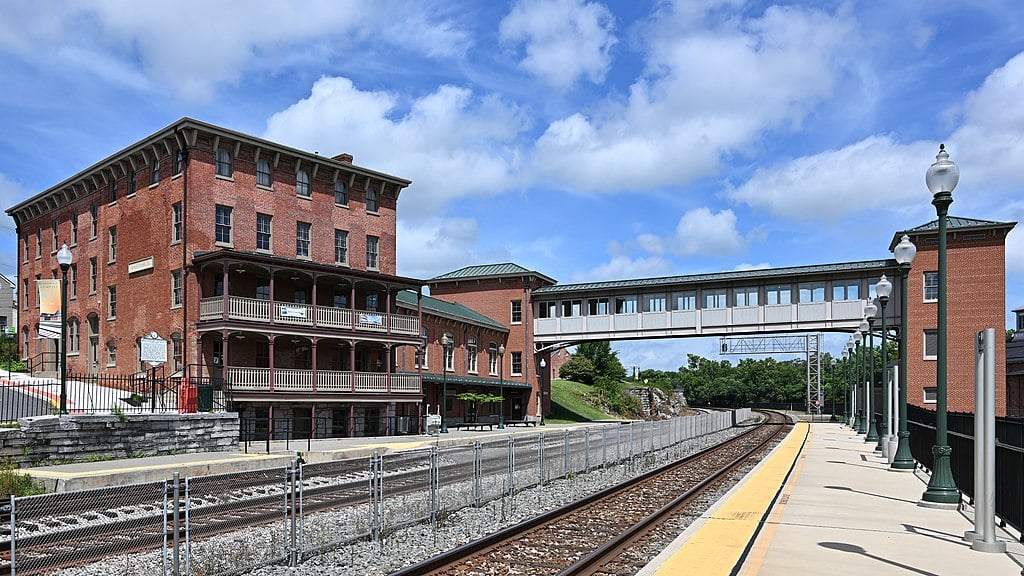
Why Are People Willing to Pay So Much to Live Here? What’s Special About It?
Martinsburg attracts residents seeking urban amenities with proximity to Washington D.C. employment while enjoying West Virginia’s lower cost of living. The city offers shopping, dining, and entertainment options along with good schools and healthcare facilities. Its position as a regional hub provides employment opportunities while serving commuters working throughout the four-state area.
How Martinsburg Rose to Prominence
Martinsburg’s prominence stems from its role as Berkeley County’s seat and its strategic location within the Washington D.C. metropolitan statistical area. The city’s development as a regional commercial and employment center attracted residents and businesses seeking affordable alternatives to Virginia and Maryland markets. Railroad heritage and modern transportation access enhanced its appeal as both a residential and commercial hub.
3 Interesting Tidbits
1. Railroad Heritage – Martinsburg’s historic Roundhouse reflects its important role in American railroad history and Civil War events.
2. Metro Area Status – The city is part of the Hagerstown-Martinsburg metropolitan area, providing access to higher-paying regional employment.
3. Regional Center – Martinsburg serves as a major commercial and employment hub for the Eastern Panhandle, supporting diverse economic activity.
16. Berkeley Springs – 110% Home Price Increase Since 2010
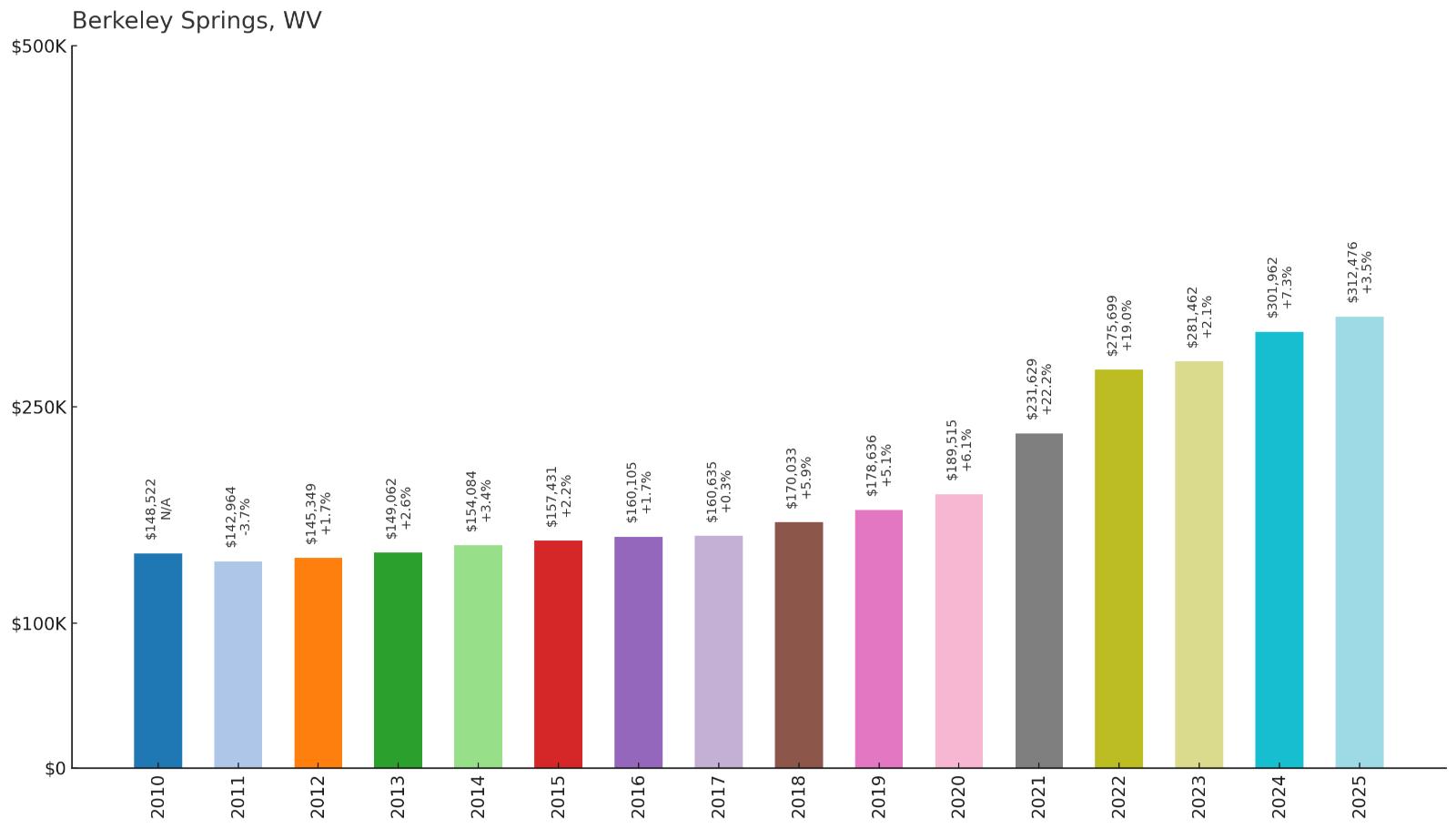
- 2010: $148,522
- 2011: $142,964
- 2012: $145,349
- 2013: $149,062
- 2014: $154,084
- 2015: $157,431
- 2016: $160,105
- 2017: $160,635
- 2018: $170,033
- 2019: $178,636
- 2020: $189,515
- 2021: $231,629
- 2022: $275,699
- 2023: $281,462
- 2024: $301,962
- 2025: $312,476
Berkeley Springs showed steady but modest growth through 2020, more than doubling from around $148,000 to over $312,000 in 15 years. The community experienced its most dramatic appreciation during 2021-2022, gaining over $85,000 in value during that period. Current prices reflect its unique appeal as America’s first spa town with continuing wellness tourism.
Why Berkeley Springs?
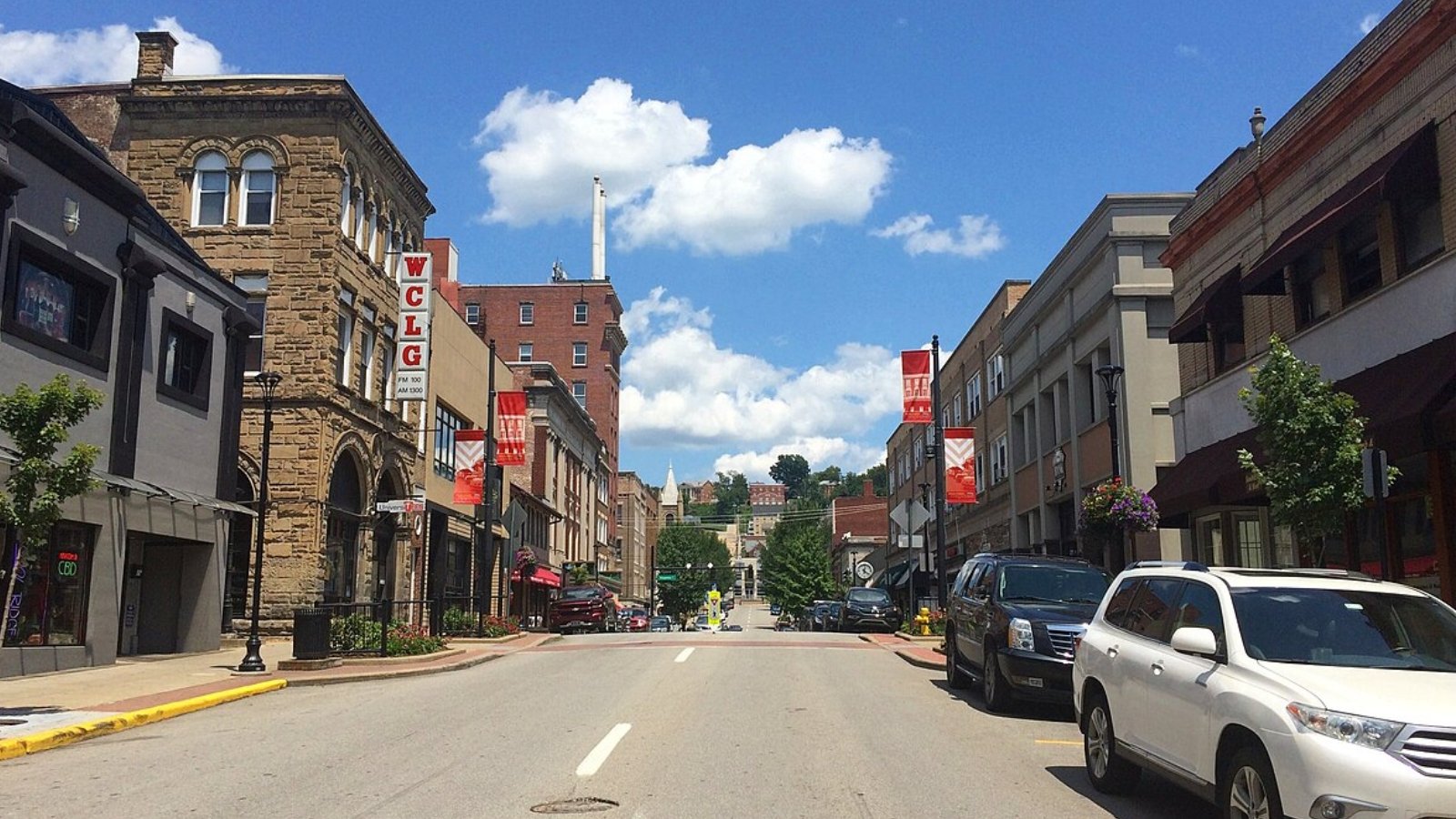
Why Are People Willing to Pay So Much to Live Here? What’s Special About It?
Berkeley Springs attracts buyers seeking a unique blend of historic charm and wellness amenities in America’s original spa town. The community offers natural mineral springs, spa facilities, and artistic culture that create a distinctive lifestyle rarely found elsewhere. Its proximity to Washington D.C. makes it attractive to professionals seeking a retreat-like setting while maintaining reasonable commuting access.
How Berkeley Springs Rose to Prominence
Berkeley Springs achieved prominence as America’s first spa town, established in 1776 when George Washington frequented the natural mineral springs. The community maintained its wellness tourism focus while developing into an arts and culture hub attracting artists, writers, and creative professionals. Recent growth reflects increased interest in wellness lifestyle communities and the appeal of small towns with unique character and amenities.
3 Interesting Tidbits
1. America’s First Spa – Berkeley Springs was established in 1776 as the nation’s first spa town, with George Washington among its early visitors.
2. Natural Springs – The mineral springs flow at a constant 74 degrees and produce over 1,000 gallons per minute, still used today for therapeutic purposes.
3. Arts Community – The town has developed into a significant arts hub with galleries, studios, and cultural events that attract creative professionals.
15. North Hills – 88% Home Price Increase Since 2010
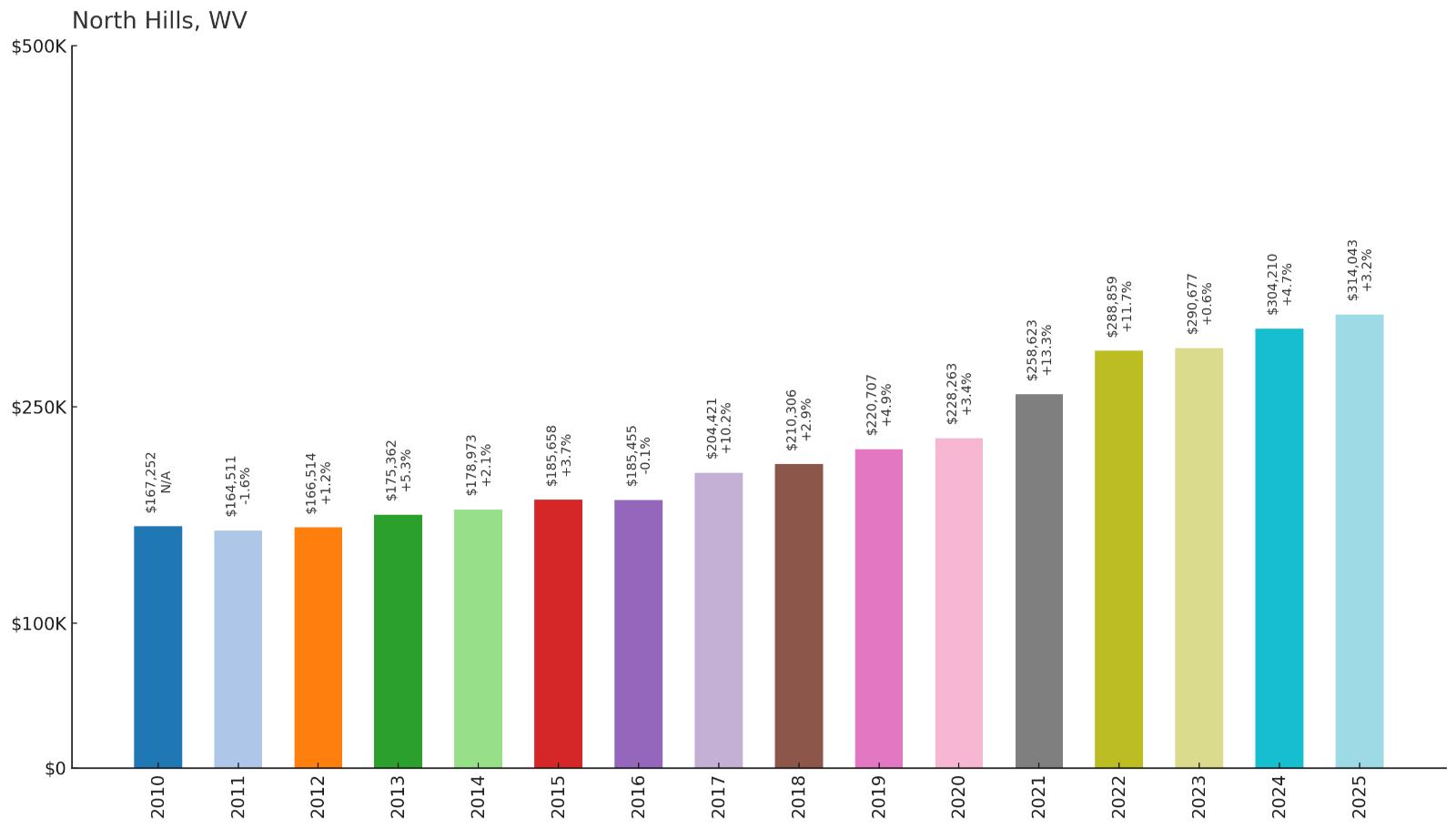
- 2010: $167,252
- 2011: $164,511
- 2012: $166,514
- 2013: $175,362
- 2014: $178,973
- 2015: $185,658
- 2016: $185,455
- 2017: $204,421
- 2018: $210,306
- 2019: $220,707
- 2020: $228,263
- 2021: $258,623
- 2022: $288,859
- 2023: $290,677
- 2024: $304,210
- 2025: $314,043
North Hills maintained steady appreciation throughout the period, nearly doubling from $167,000 to over $314,000 in 15 years. The community showed consistent growth with notable acceleration in 2017 and again during pandemic years. Current values reflect its appeal within the Parkersburg-Vienna metropolitan area.
Why North Hills?
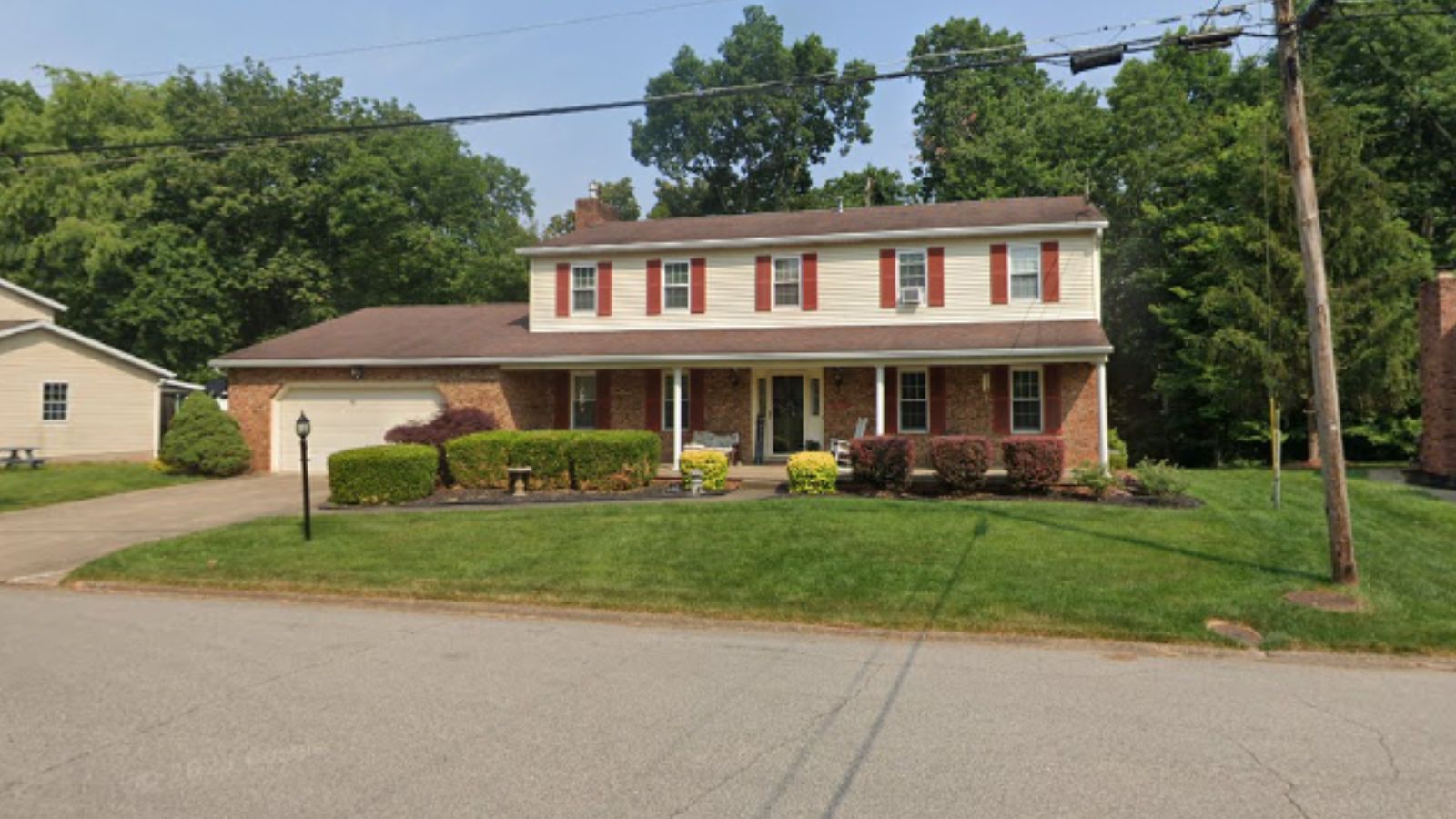
Why Are People Willing to Pay So Much to Live Here? What’s Special About It?
North Hills attracts buyers seeking upscale suburban living within the Parkersburg metropolitan area, offering quality neighborhoods and amenities. The community provides access to good schools, recreational facilities, and shopping while maintaining reasonable living costs compared to major metropolitan areas. Its location offers both urban conveniences and outdoor recreation opportunities along the Ohio River.
How North Hills Rose to Prominence
North Hills developed as an upscale residential area serving the Parkersburg-Vienna metropolitan region, attracting families and professionals working in the area’s energy, healthcare, and government sectors. The community’s planned development and quality amenities created an attractive residential environment that commands premium prices within the local market.
3 Interesting Tidbits
1. Metro Location – North Hills sits within the Parkersburg-Vienna metropolitan area, providing access to regional employment and amenities.
2. River Access – The community offers proximity to the Ohio River for recreational boating, fishing, and water sports.
3. Consistent Growth – North Hills showed steady appreciation without major volatility, demonstrating stable market fundamentals attractive to long-term residents.
14. Bolivar – 103% Home Price Increase Since 2010

- 2010: $154,751
- 2011: $144,821
- 2012: $143,032
- 2013: $149,108
- 2014: $154,396
- 2015: $159,605
- 2016: $158,597
- 2017: $177,304
- 2018: $188,218
- 2019: $201,456
- 2020: $210,099
- 2021: $260,192
- 2022: $282,473
- 2023: $283,043
- 2024: $304,797
- 2025: $314,446
Bolivar recovered from early market weakness and more than doubled in value since 2010, reaching current levels over $314,000. The community experienced steady growth beginning around 2017 with dramatic acceleration during pandemic years, gaining over $100,000 between 2020 and 2025. This Jefferson County location benefits from Washington D.C. metropolitan area proximity.
Why Bolivar?
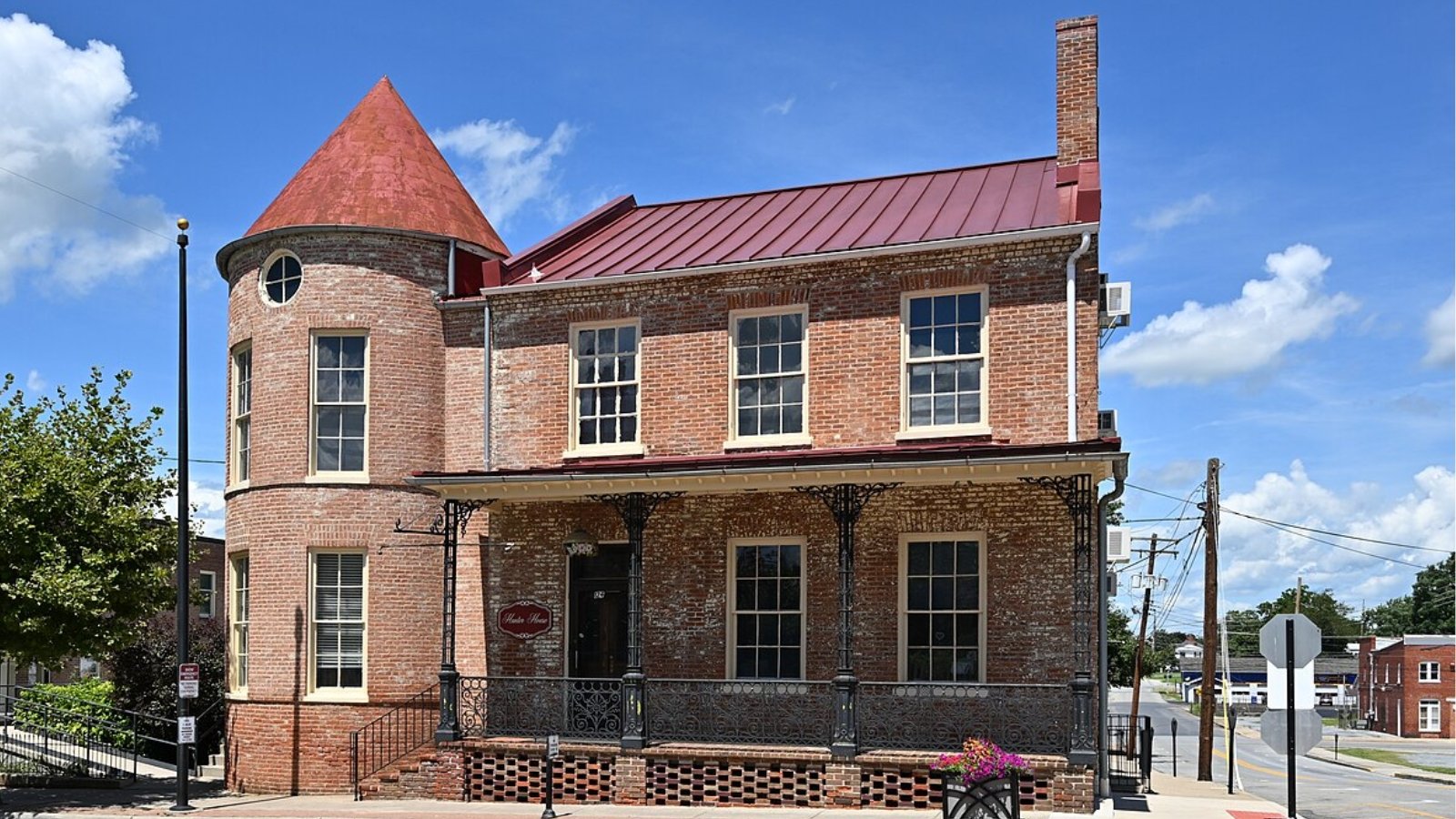
Why Are People Willing to Pay So Much to Live Here? What’s Special About It?
Bolivar attracts buyers seeking affordable entry into Jefferson County’s real estate market while benefiting from Washington D.C. metropolitan area employment access. The community offers rural character with larger lots and custom home opportunities that appeal to families wanting space and privacy. Its location provides outdoor recreation access while serving commuters working throughout the region.
How Bolivar Rose to Prominence
Bolivar developed as part of Jefferson County’s residential expansion serving the Washington D.C. metropolitan area, attracting buyers seeking alternatives to higher-priced Virginia and Maryland markets. The community’s growth accelerated as transportation improvements and remote work options made longer commutes more practical. Recent appreciation reflects broader Eastern Panhandle trends toward rapid housing market growth.
3 Interesting Tidbits
1. D.C. Metro Access – Bolivar sits within the Washington-Arlington-Alexandria metropolitan statistical area, providing access to high-paying federal employment.
2. Market Recovery – After struggling during the early 2010s, Bolivar found strong growth momentum beginning around 2017.
3. Rural Character – The community maintains rural atmosphere with larger properties while providing metropolitan area employment access.
13. Falling Waters – 79% Home Price Increase Since 2014
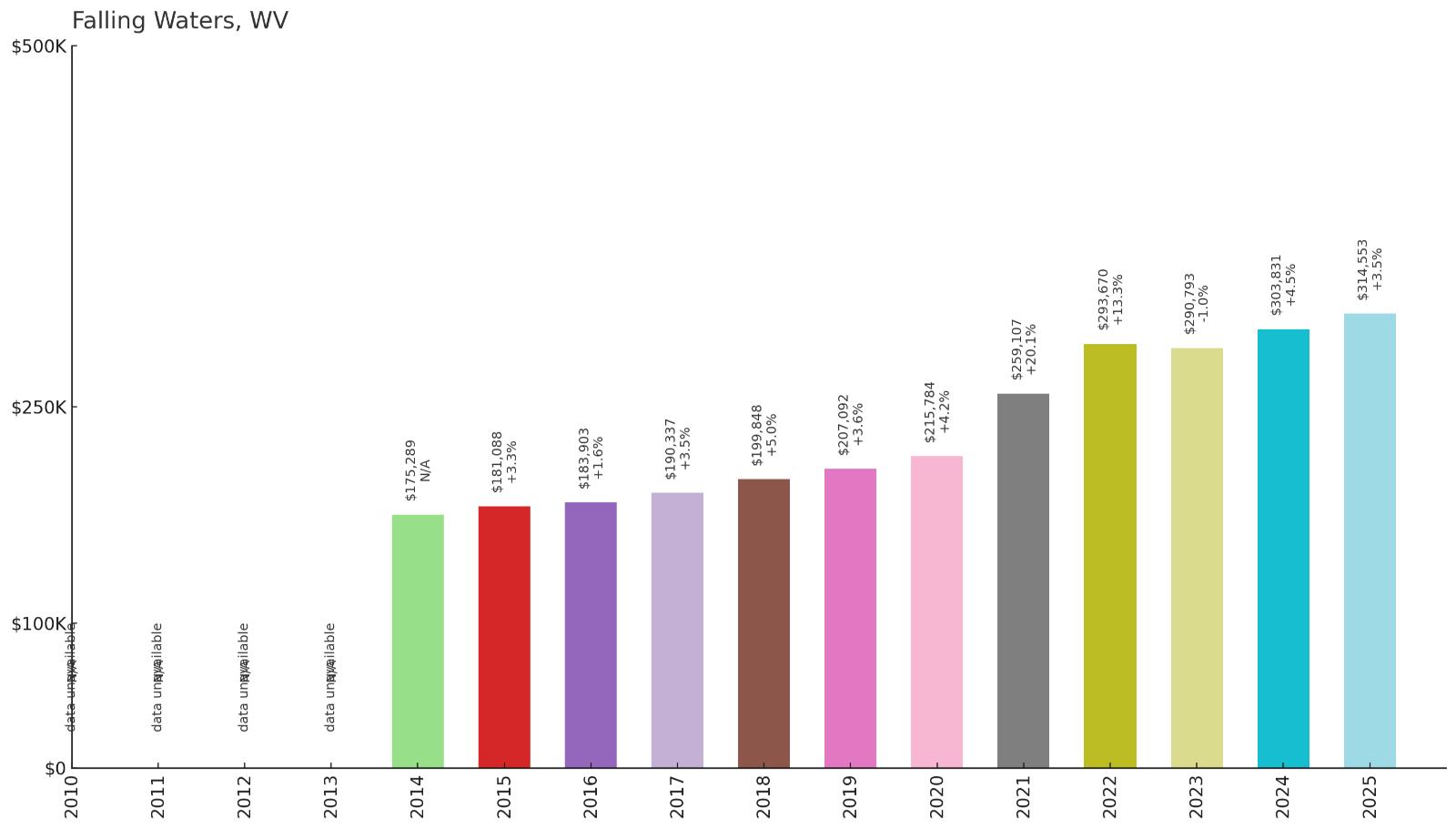
- 2010: N/A
- 2011: N/A
- 2012: N/A
- 2013: N/A
- 2014: $175,289
- 2015: $181,088
- 2016: $183,903
- 2017: $190,337
- 2018: $199,848
- 2019: $207,092
- 2020: $215,784
- 2021: $259,107
- 2022: $293,670
- 2023: $290,793
- 2024: $303,831
- 2025: $314,553
Falling Waters showed consistent year-over-year growth since data became available in 2014, increasing from $175,289 to over $314,000. The community experienced particularly strong gains during 2021-2022, adding over $75,000 in value during that period. Current prices reflect its strategic location within the Hagerstown-Martinsburg metropolitan area.
Why Falling Waters?
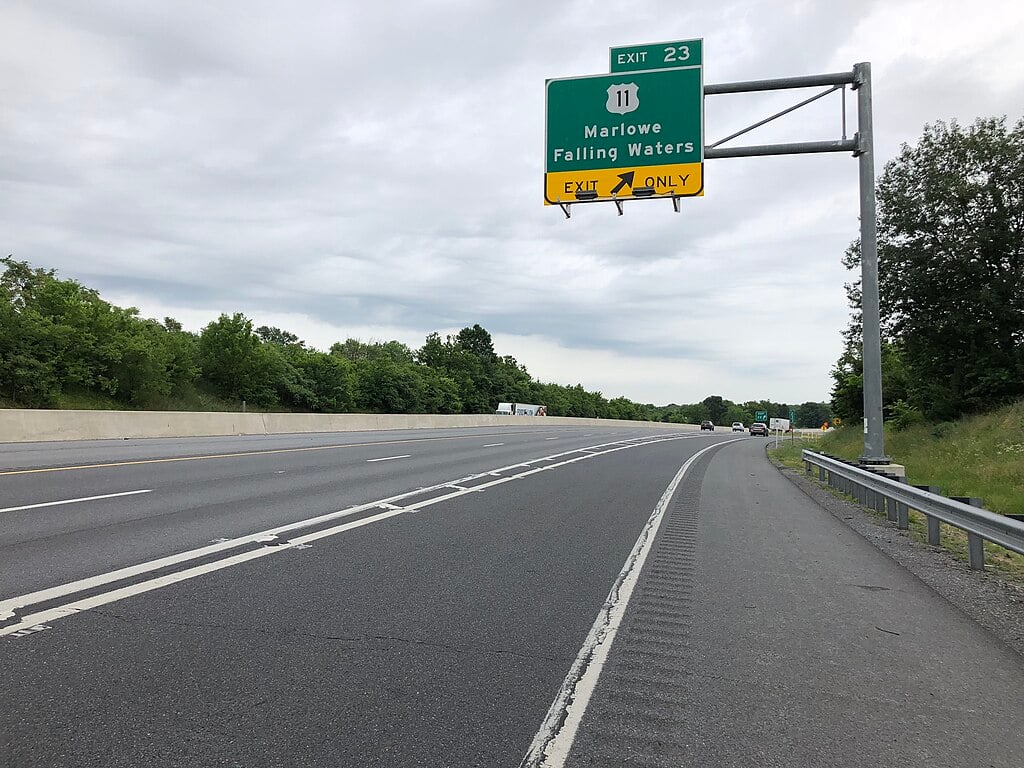
Why Are People Willing to Pay So Much to Live Here? What’s Special About It?
Falling Waters attracts buyers seeking suburban lifestyle with convenient Interstate 81 access for commuting throughout the four-state region. The community offers newer housing developments and quality schools that appeal to families relocating from more expensive metropolitan areas. Its Berkeley County location provides access to both West Virginia affordability and regional employment opportunities.
How Falling Waters Rose to Prominence
Falling Waters developed as a planned community along Interstate 81, strategically positioned to serve commuters working throughout the Washington D.C., Baltimore, and Hagerstown metropolitan areas. The community’s suburban amenities and convenient highway access attracted families and professionals seeking quality of life improvements while maintaining career opportunities in larger metropolitan markets.
3 Interesting Tidbits
1. Interstate Access – Falling Waters sits directly along Interstate 81, providing excellent commuting access to multiple metropolitan areas.
2. Planned Community – The area features planned residential development with attention to schools, parks, and suburban amenities.
3. Metro Area – Falling Waters is part of the Hagerstown-Martinsburg metropolitan area, providing access to diverse employment opportunities.
12. Inwood – 107% Home Price Increase Since 2014

- 2010: N/A
- 2011: N/A
- 2012: N/A
- 2013: N/A
- 2014: $151,966
- 2015: $156,639
- 2016: $161,052
- 2017: $168,838
- 2018: $181,650
- 2019: $192,163
- 2020: $203,589
- 2021: $246,048
- 2022: $284,028
- 2023: $286,526
- 2024: $303,862
- 2025: $315,104
Inwood more than doubled in value since 2014, growing from around $152,000 to over $315,000 with consistent year-over-year appreciation. The community experienced strong acceleration during pandemic years, particularly in 2021-2022 when values jumped significantly. Current prices reflect its appeal within the Hagerstown-Martinsburg metropolitan area.
Why Inwood?
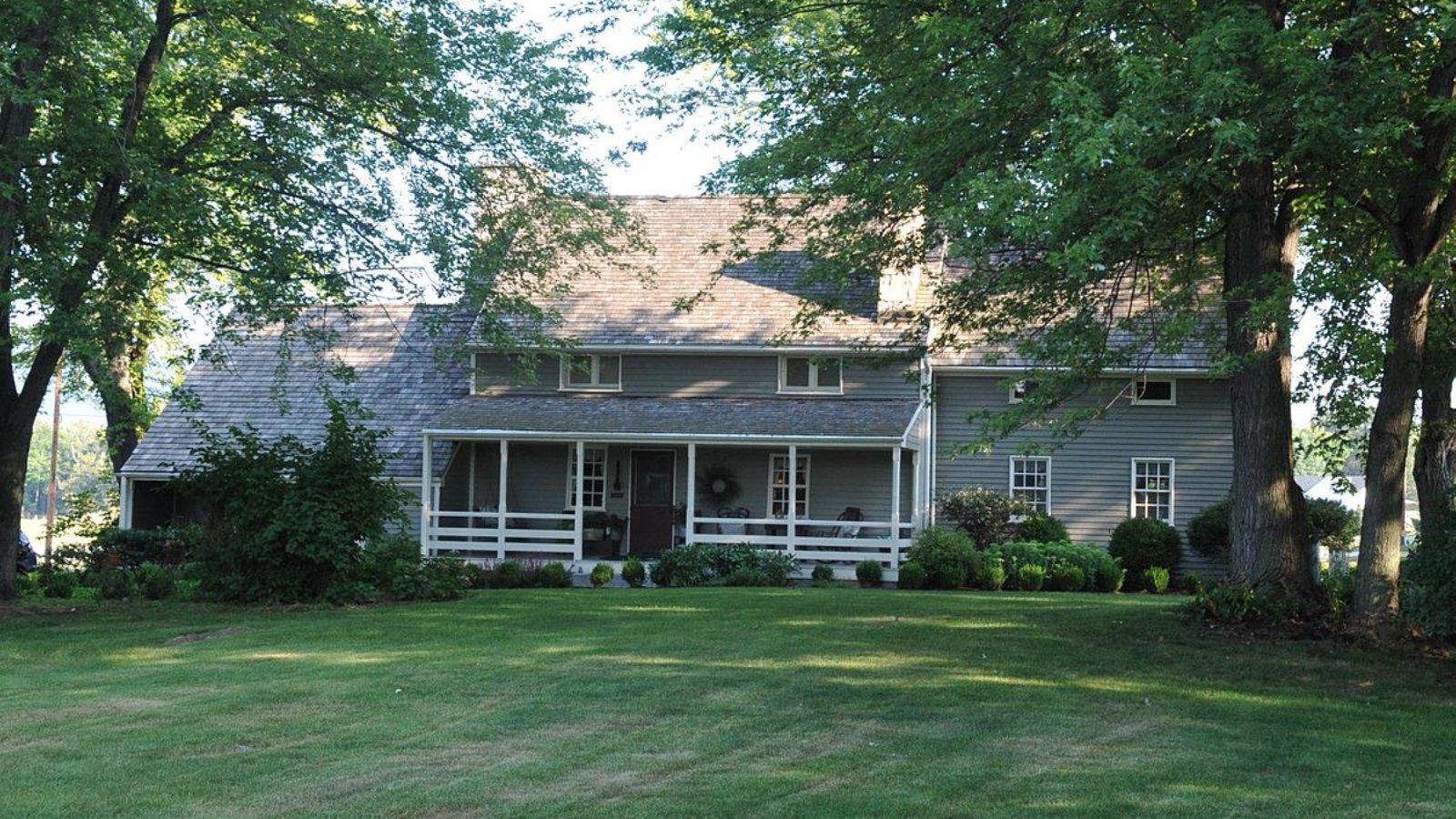
Why Are People Willing to Pay So Much to Live Here? What’s Special About It?
Inwood attracts buyers seeking newer suburban development with quality schools and amenities while maintaining reasonable commuting distance to major employment centers. The community offers planned neighborhoods and convenient shopping that appeal to families relocating from more expensive metropolitan areas. Its Berkeley County location provides the benefits of both West Virginia living and regional employment access.
How Inwood Rose to Prominence
Inwood developed as a modern suburban community designed to serve commuters working throughout the Washington D.C., Baltimore, and Hagerstown metropolitan areas. The area’s planned development included retail, schools, and residential amenities that created an attractive alternative to higher-priced Virginia and Maryland markets. Growth accelerated as transportation improvements and changing work patterns made the location increasingly practical for regional commuters.
3 Interesting Tidbits
1. Retail Hub – Inwood features significant commercial development including shopping centers and restaurants serving the broader Berkeley County area.
2. School Quality – The community is served by highly-rated Berkeley County schools, a major attraction for families with children.
3. Metro Access – Inwood sits within the Hagerstown-Martinsburg metropolitan area, providing access to diverse, higher-paying employment opportunities.
11. Capon Bridge – 87% Home Price Increase Since 2010
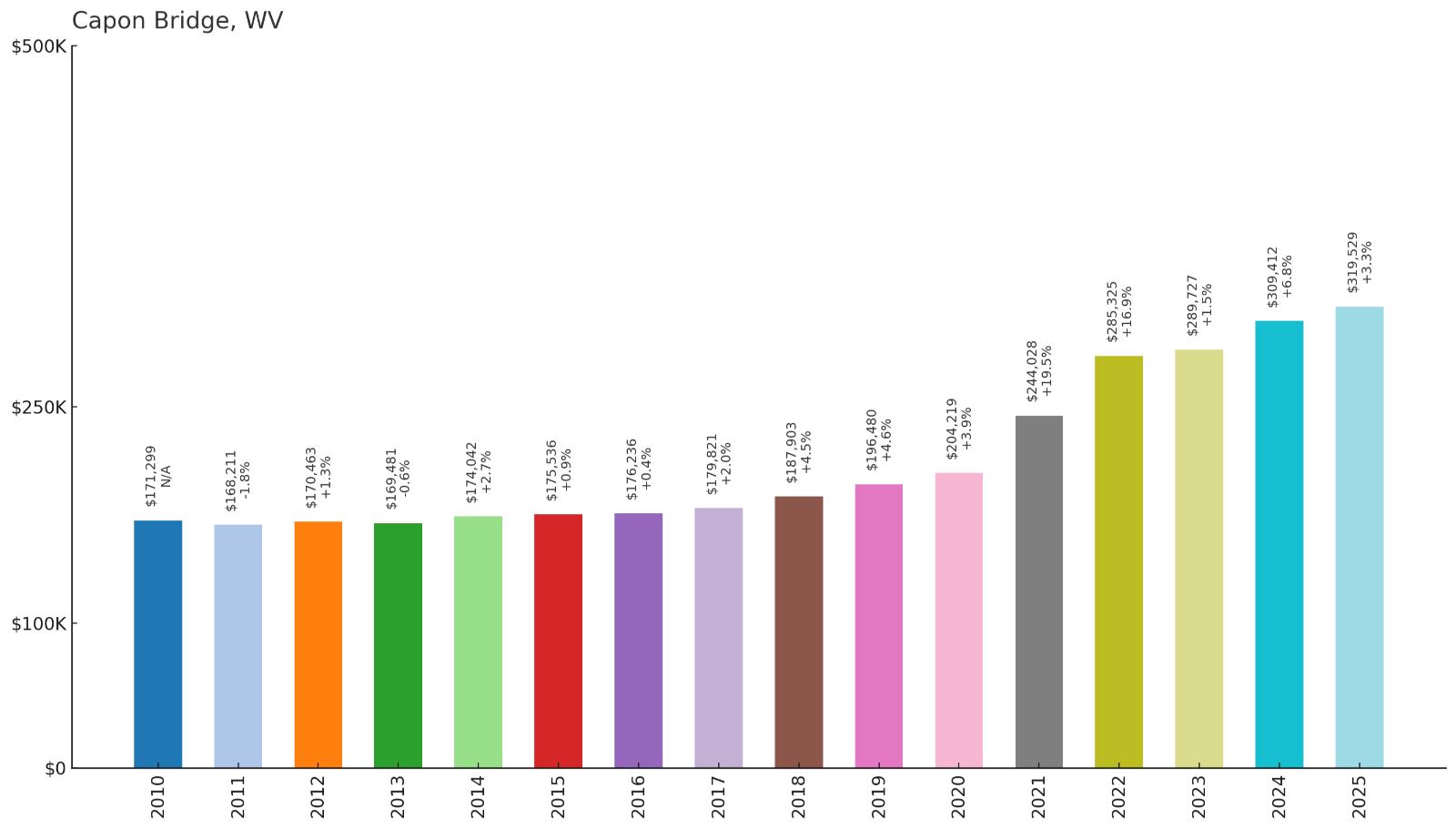
- 2010: $171,299
- 2011: $168,211
- 2012: $170,463
- 2013: $169,481
- 2014: $174,042
- 2015: $175,536
- 2016: $176,236
- 2017: $179,821
- 2018: $187,903
- 2019: $196,480
- 2020: $204,219
- 2021: $244,028
- 2022: $285,325
- 2023: $289,727
- 2024: $309,412
- 2025: $319,529
Capon Bridge demonstrated remarkable stability through 2020, with values hovering around $170,000-$200,000 for most of the decade before accelerating dramatically. The community gained over $115,000 in value between 2020 and 2025, with the largest single-year gain occurring in 2022. Current prices approaching $320,000 reflect strong demand for properties in this Winchester metropolitan area location.
Why Capon Bridge?
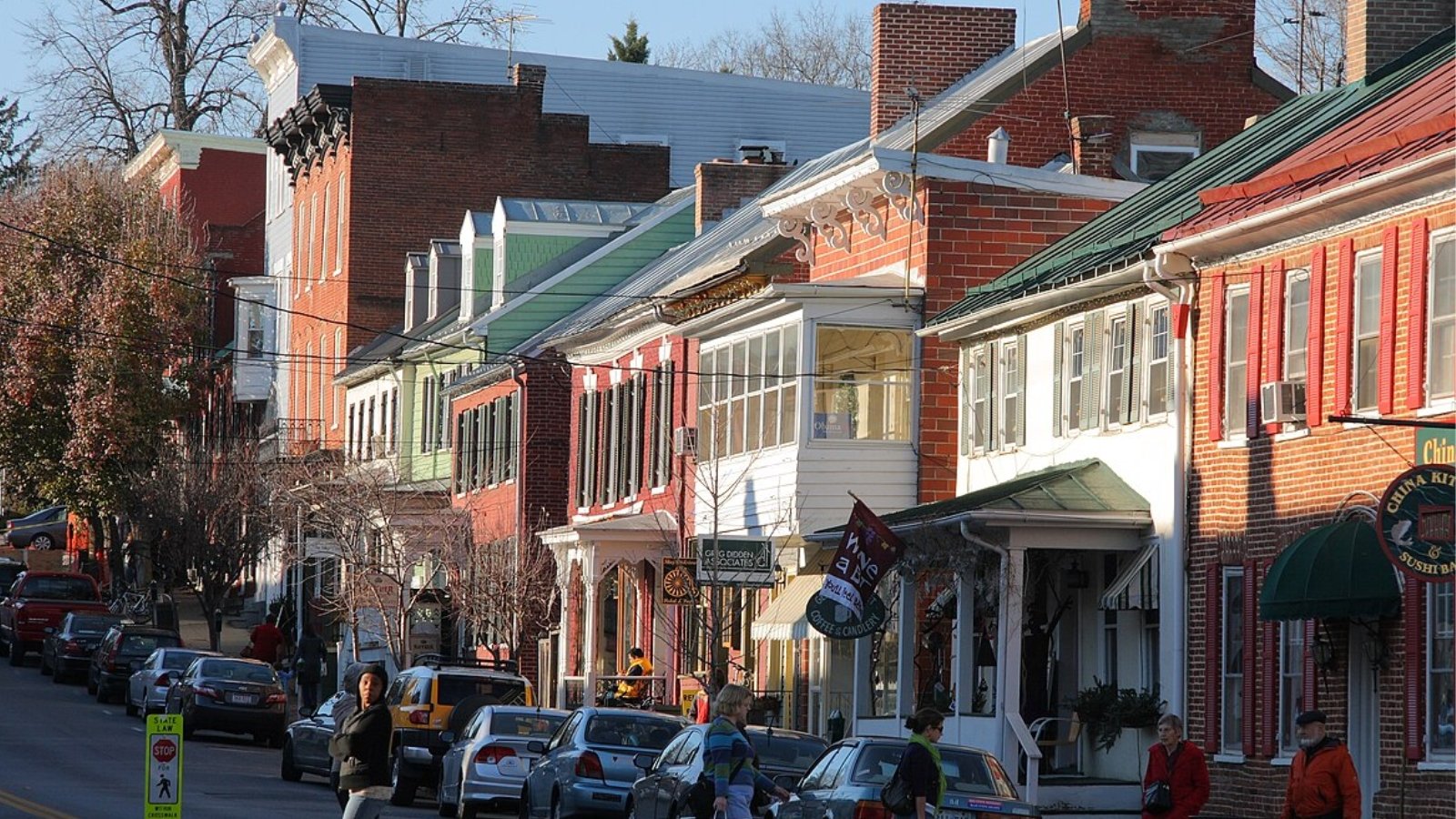
Why Are People Willing to Pay So Much to Live Here? What’s Special About It?
Capon Bridge attracts buyers seeking rural charm with scenic mountain and river views while maintaining access to Winchester, Virginia employment opportunities. The community offers larger lots, wooded properties, and custom home sites that appeal to those wanting privacy and natural beauty. Its location along U.S. Route 50 provides convenient access to regional amenities while preserving rural character.
How Capon Bridge Rose to Prominence
Capon Bridge developed as a scenic rural community serving buyers seeking alternatives to Virginia’s higher-priced markets while maintaining reasonable commuting distance to Winchester and the broader Washington metro region. The area’s natural beauty, including mountain views and river access, attracted residents valuing outdoor recreation and rural lifestyle. Growth accelerated as remote work trends made scenic locations more practical for a broader range of professionals.
3 Interesting Tidbits
1. Natural Beauty – Capon Bridge offers mountain views and river access that enhance both quality of life and property values.
2. Winchester Metro – The community sits within the Winchester, VA metropolitan area, providing employment access while maintaining rural West Virginia character.
3. Route 50 Access – Location along U.S. Route 50 provides convenient transportation to Virginia employment centers and amenities.
10. Bunker Hill – 102% Home Price Increase Since 2014
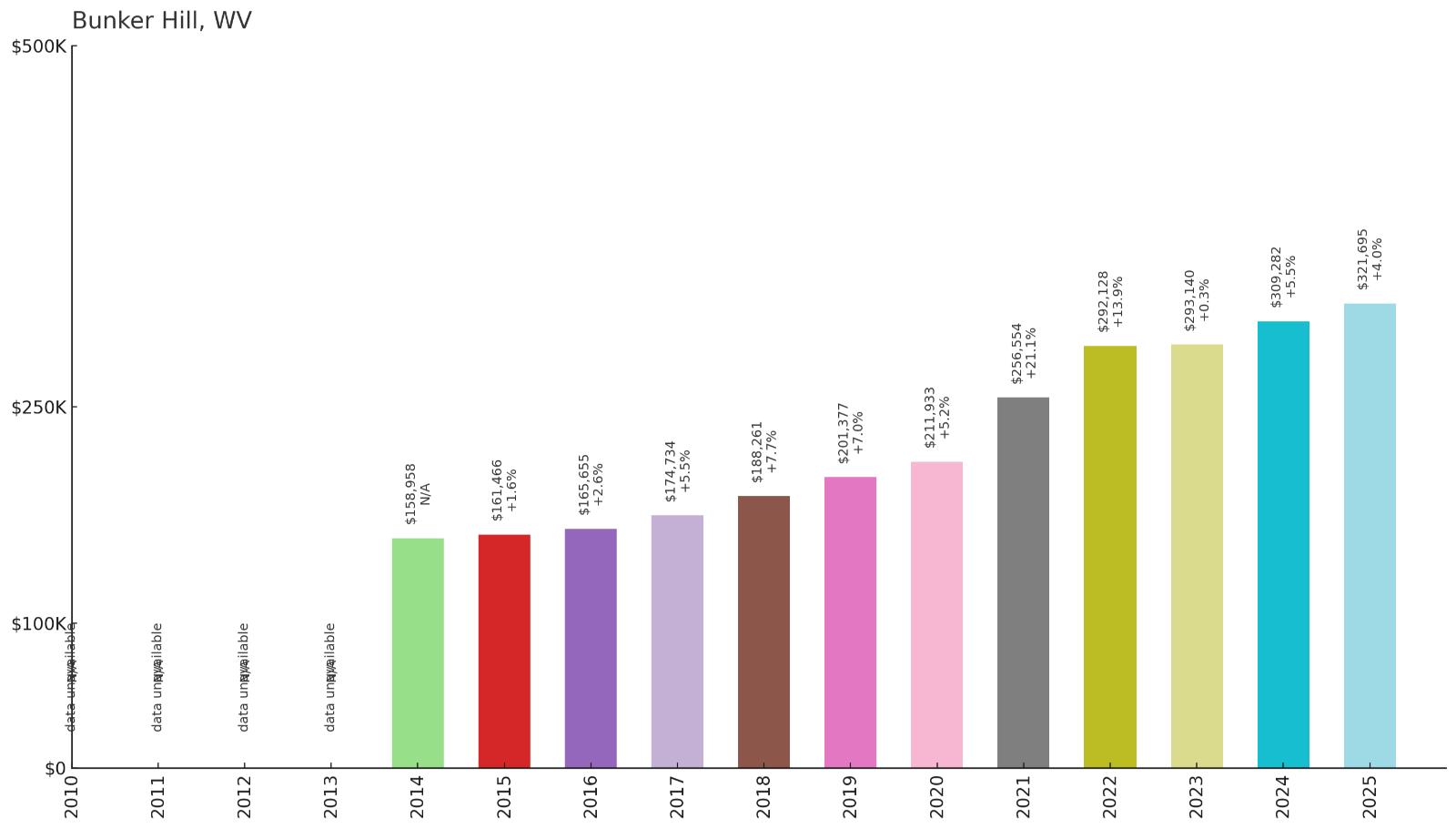
- 2010: N/A
- 2011: N/A
- 2012: N/A
- 2013: N/A
- 2014: $158,958
- 2015: $161,466
- 2016: $165,655
- 2017: $174,734
- 2018: $188,261
- 2019: $201,377
- 2020: $211,933
- 2021: $256,554
- 2022: $292,128
- 2023: $293,140
- 2024: $309,282
- 2025: $321,695
Bunker Hill doubled in value since 2014, growing from around $159,000 to over $321,000 with consistent year-over-year appreciation accelerating after 2016. The community experienced particularly strong gains during 2021-2022, jumping over $80,000 during that period. Current prices reflect its strategic location within the Hagerstown-Martinsburg metropolitan area.
Why Bunker Hill?
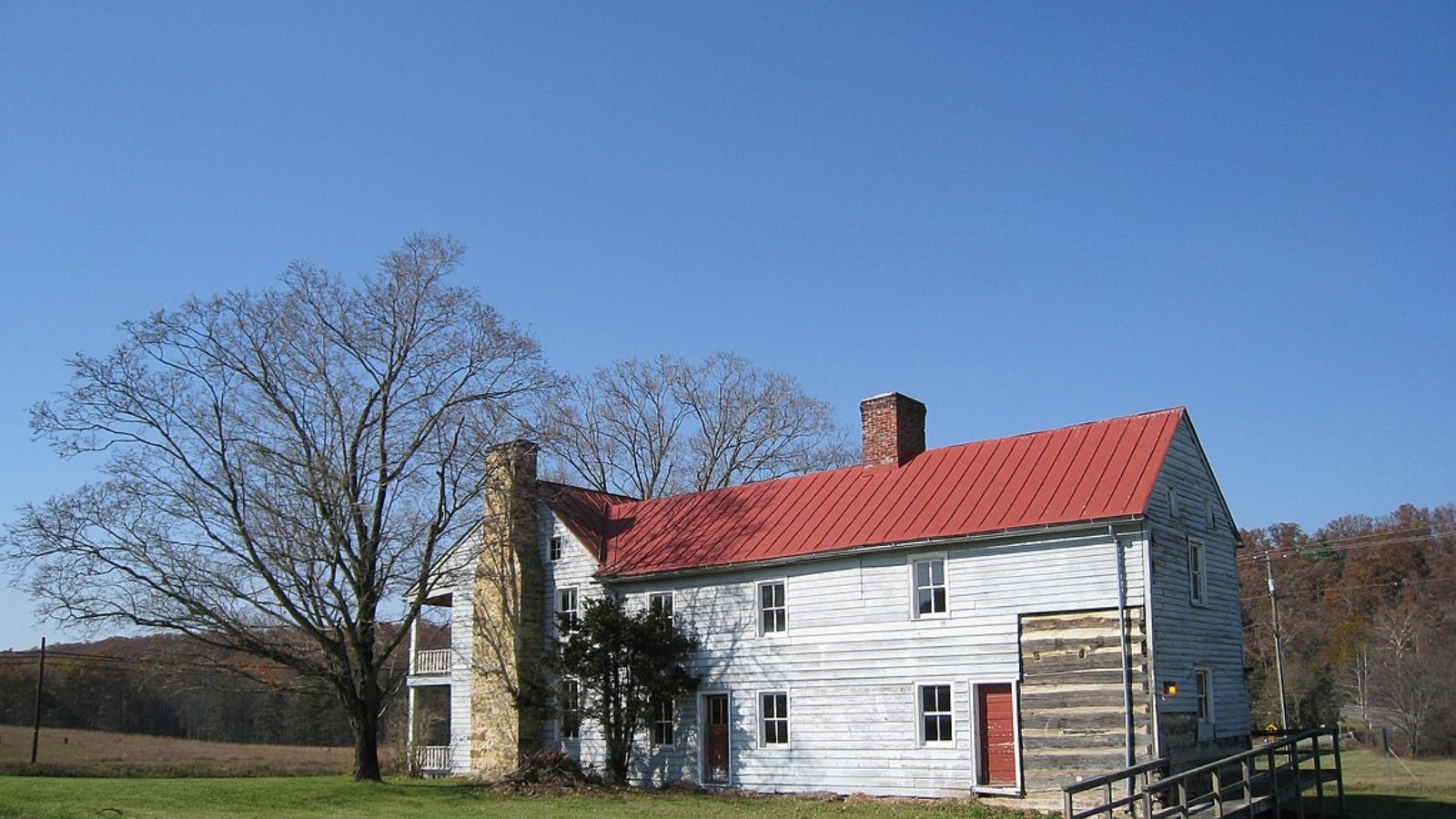
Why Are People Willing to Pay So Much to Live Here? What’s Special About It?
Bunker Hill attracts buyers seeking convenient Interstate 81 access for regional commuting while enjoying West Virginia’s lower cost of living and rural character. The community offers newer housing developments and quality amenities that appeal to families relocating from more expensive metropolitan areas. Its Berkeley County location provides access to excellent schools and growing retail options.
How Bunker Hill Rose to Prominence
Bunker Hill developed as a strategically located community along Interstate 81, designed to serve commuters working throughout the Washington D.C., Baltimore, and Hagerstown metropolitan areas. The area’s highway access and planned development attracted families and professionals seeking quality of life improvements while maintaining career opportunities in larger markets. Growth accelerated as the community established retail, schools, and suburban amenities.
3 Interesting Tidbits
1. Interstate Location – Bunker Hill sits directly along Interstate 81 between Martinsburg and Winchester, providing excellent commuting access.
2. Rapid Growth – The community more than doubled in value in just 11 years, making it one of the fastest appreciating markets in West Virginia.
3. Metro Area – Bunker Hill is part of the Hagerstown-Martinsburg metropolitan area, providing access to diverse employment opportunities.
9. Hedgesville – 153% Home Price Increase Since 2010
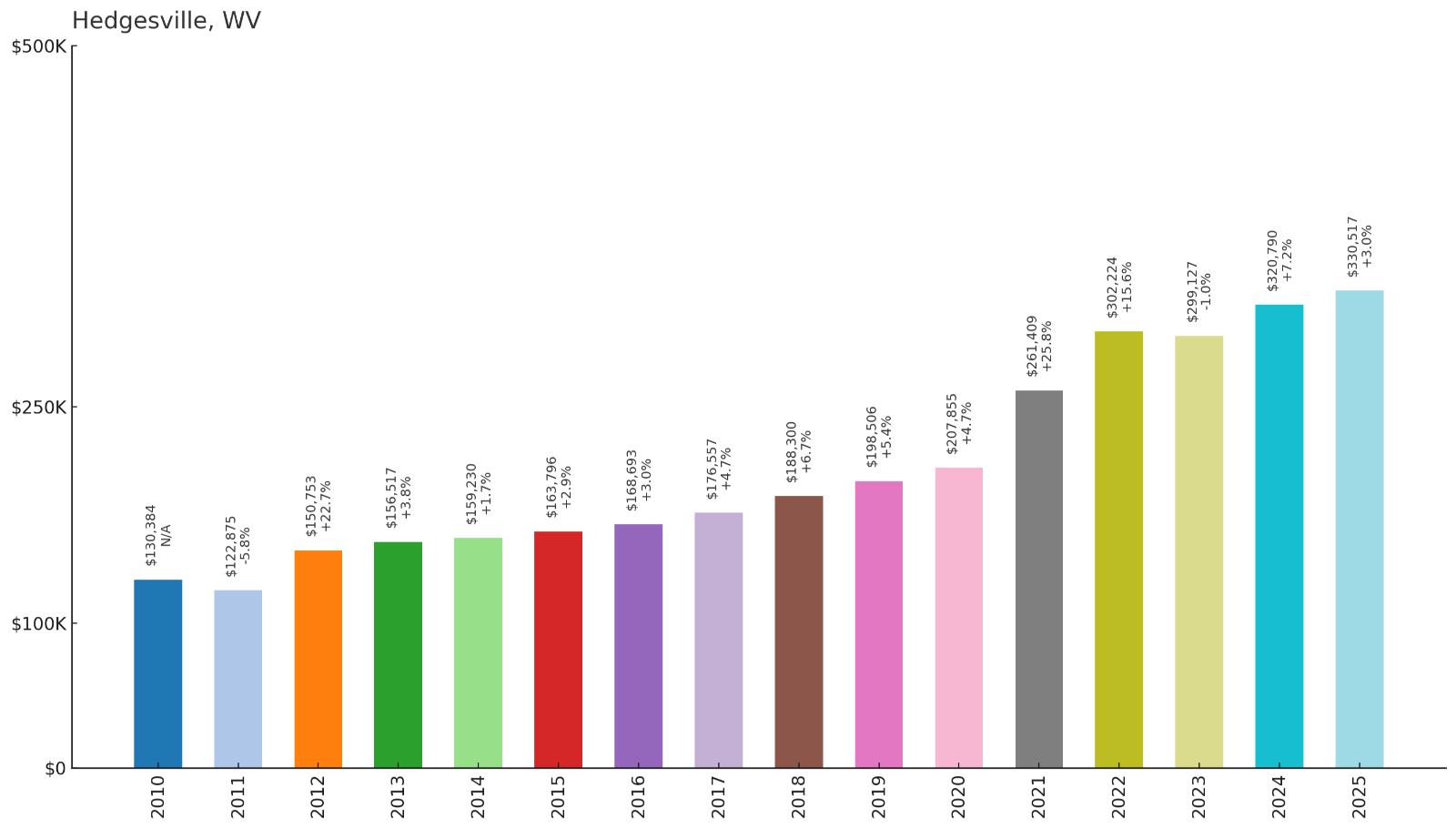
- 2010: $130,384
- 2011: $122,875
- 2012: $150,753
- 2013: $156,517
- 2014: $159,230
- 2015: $163,796
- 2016: $168,693
- 2017: $176,557
- 2018: $188,300
- 2019: $198,506
- 2020: $207,855
- 2021: $261,409
- 2022: $302,224
- 2023: $299,127
- 2024: $320,790
- 2025: $330,517
Hedgesville achieved the highest long-term appreciation among all communities, growing from around $130,000 to over $330,000 since 2010. After an early dip in 2011, the community showed consistent growth with dramatic acceleration during pandemic years, gaining over $120,000 between 2020 and 2025. Current values represent exceptional performance within the Hagerstown-Martinsburg metropolitan area.
Why Hedgesville?
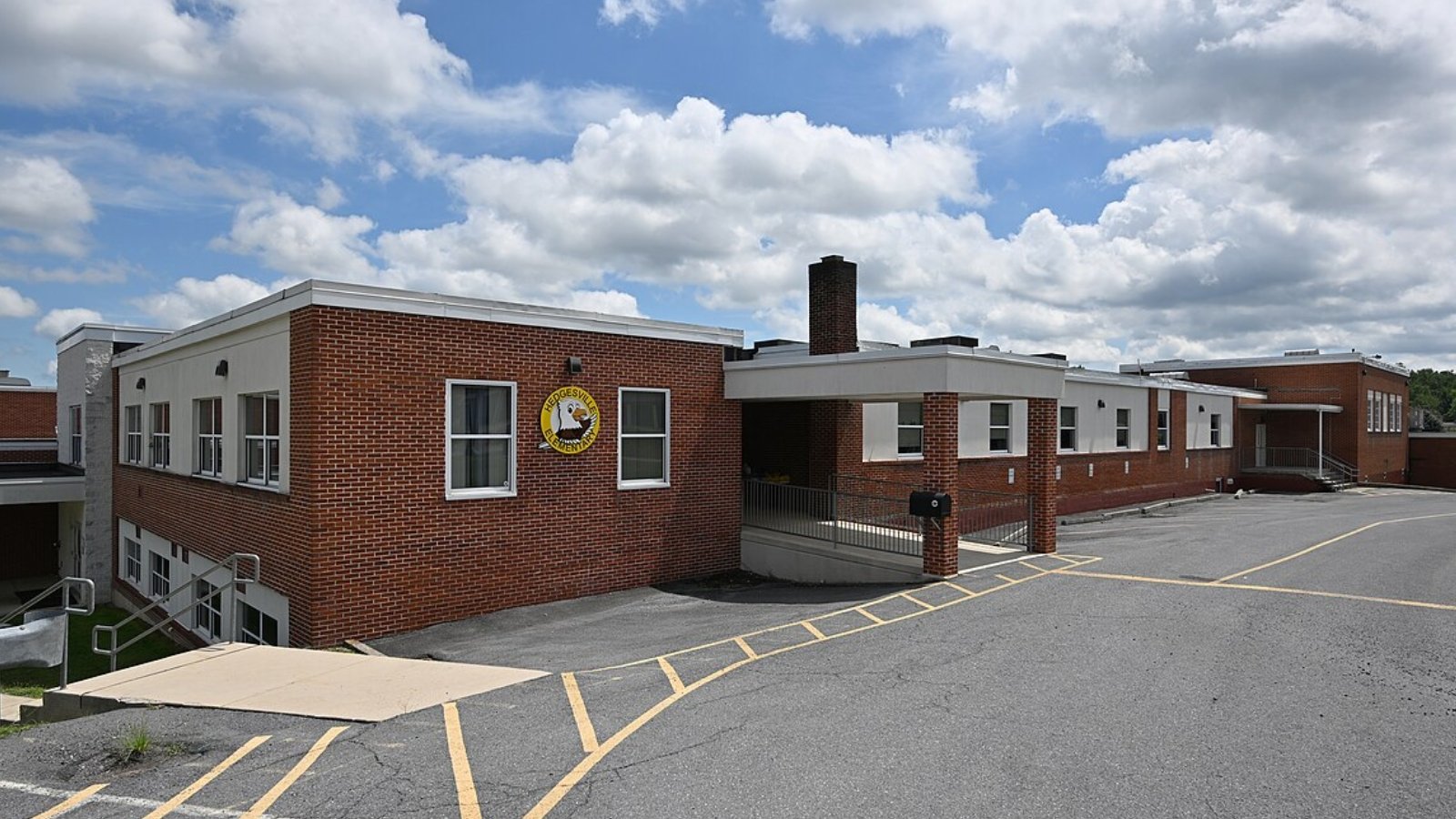
Why Are People Willing to Pay So Much to Live Here? What’s Special About It?
Hedgesville attracts buyers seeking small-town charm with convenient access to major employment centers throughout the four-state region. The community offers historic character combined with newer housing developments that appeal to families wanting both authenticity and modern amenities. Its Berkeley County location provides excellent schools and growing retail options while maintaining reasonable commuting distance to Washington D.C., Baltimore, and Hagerstown.
How Hedgesville Rose to Prominence
Hedgesville’s prominence grew from its historic foundation and strategic location in Berkeley County, attracting buyers seeking alternatives to Virginia and Maryland’s higher-priced markets. The community’s combination of historic charm and modern development created appeal for both long-term residents and newcomers seeking quality of life improvements. Growth accelerated as transportation access and remote work options made the location increasingly practical for regional commuters.
3 Interesting Tidbits
1. Historic Charm – Hedgesville maintains its historic small-town character while accommodating modern residential and commercial development.
2. Highest Returns – The community achieved 153% appreciation since 2010, the highest long-term return among all communities on this list.
3. Four-State Access – Hedgesville’s location provides convenient commuting access to employment centers in West Virginia, Virginia, Maryland, and Pennsylvania.
8. Davis – 70% Home Price Increase Since 2010

- 2010: $196,540
- 2011: $203,430
- 2012: $167,465
- 2013: $164,695
- 2014: $166,123
- 2015: $171,696
- 2016: $176,694
- 2017: $177,350
- 2018: $185,180
- 2019: $191,048
- 2020: $196,796
- 2021: $226,934
- 2022: $272,134
- 2023: $299,899
- 2024: $323,885
- 2025: $333,633
Davis experienced significant volatility during the early 2010s, dropping from over $203,000 to around $164,000 before beginning steady recovery. The community showed consistent growth from 2015 onward with dramatic acceleration during pandemic years, gaining over $135,000 between 2020 and 2025. Current values exceeding $333,000 reflect its transformation into a premier mountain destination.
Why Davis?
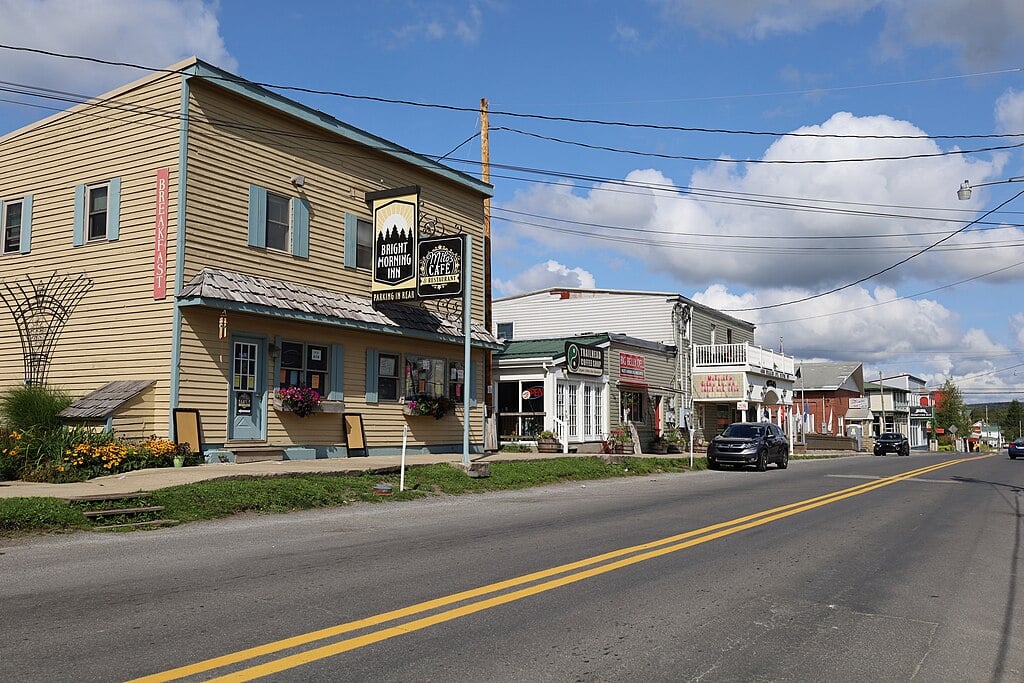
Why Are People Willing to Pay So Much to Live Here? What’s Special About It?
Davis attracts buyers seeking a premier mountain lifestyle at the highest elevation of any town in West Virginia. The community offers world-class outdoor recreation including skiing, hiking, and mountain biking that appeals to adventure enthusiasts and vacation home buyers. Its transformation from a timber town into a destination resort area creates unique appeal for those valuing mountain living and recreational access.
How Davis Rose to Prominence
Davis evolved from its timber town origins into West Virginia’s premier mountain resort destination, benefiting from its elevation and proximity to outdoor recreation opportunities. The community’s development of skiing, mountain biking, and hiking facilities attracted both seasonal visitors and permanent residents seeking mountain lifestyle. Recent growth reflects increased demand for recreational properties and remote work locations with natural amenities.
3 Interesting Tidbits
1. Highest Elevation – Davis sits at the highest elevation of any incorporated town in West Virginia, providing unique mountain climate and views.
2. Outdoor Recreation – The town offers world-class skiing at Canaan Valley Resort and extensive mountain biking and hiking trail systems.
3. Destination Appeal – Davis has transformed from a timber town into a premier mountain destination attracting both visitors and permanent residents seeking outdoor lifestyle.
7. Gerrardstown – 117% Home Price Increase Since 2011

- 2010: N/A
- 2011: $154,984
- 2012: $151,819
- 2013: $148,896
- 2014: $153,718
- 2015: $167,319
- 2016: $171,572
- 2017: $180,344
- 2018: $194,438
- 2019: $205,361
- 2020: $213,920
- 2021: $267,294
- 2022: $305,577
- 2023: $301,980
- 2024: $323,183
- 2025: $336,493
Gerrardstown more than doubled in value since 2011, recovering from early market weakness and achieving consistent growth since 2014. The community experienced dramatic acceleration during pandemic years, gaining over $120,000 between 2020 and 2025. Current values exceeding $336,000 reflect strong demand in this Jefferson County location within the Washington D.C. metropolitan area.
Why Gerrardstown?
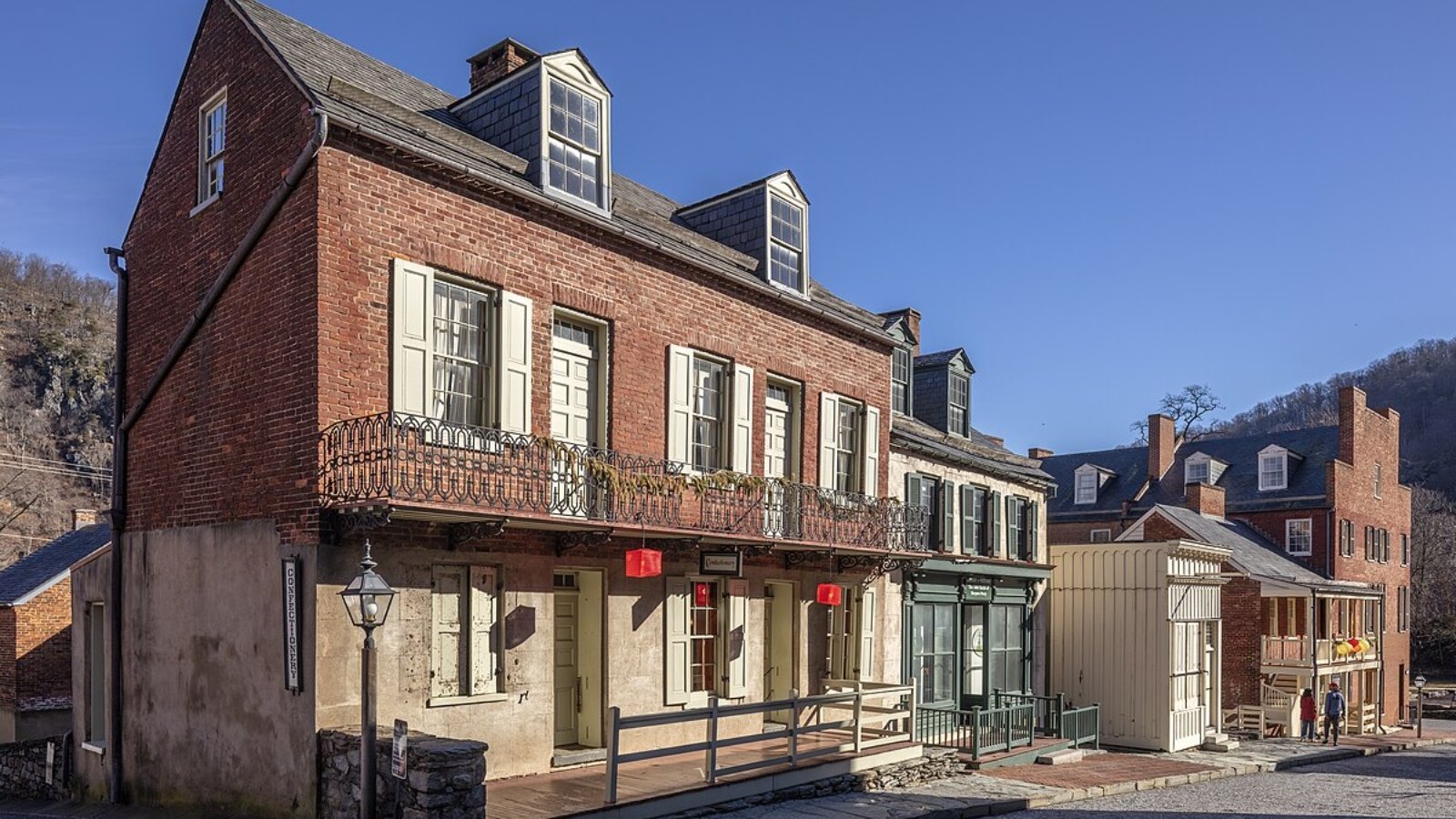
Why Are People Willing to Pay So Much to Live Here? What’s Special About It?
Gerrardstown attracts buyers seeking rural character with larger properties while maintaining access to Washington D.C. metropolitan area employment opportunities. The community offers scenic landscapes and custom home sites that appeal to those wanting privacy and natural beauty. Its Jefferson County location provides access to quality schools and regional amenities while preserving countryside atmosphere.
How Gerrardstown Rose to Prominence
Gerrardstown developed as part of Jefferson County’s appeal to buyers seeking alternatives to Virginia and Maryland’s higher-priced markets while maintaining reasonable commuting distance to the Washington D.C. metropolitan area. The community’s rural character and larger lot sizes attracted residents valuing space and privacy. Growth accelerated as transportation improvements and remote work options made the location increasingly attractive to regional professionals.
3 Interesting Tidbits
1. Rural Character – Gerrardstown maintains countryside atmosphere with larger properties and scenic landscapes that enhance quality of life.
2. D.C. Metro Access – The community sits within the Washington-Arlington-Alexandria metropolitan statistical area, providing access to high-paying employment.
3. Strong Appreciation – Gerrardstown achieved 117% appreciation since 2011, demonstrating exceptional long-term investment performance.
6. Kearneysville – 114% Home Price Increase Since 2010

- 2010: $180,708
- 2011: $173,187
- 2012: $178,735
- 2013: $187,845
- 2014: $195,958
- 2015: $211,734
- 2016: $214,111
- 2017: $225,994
- 2018: $238,710
- 2019: $246,207
- 2020: $258,279
- 2021: $316,428
- 2022: $353,466
- 2023: $354,324
- 2024: $374,298
- 2025: $386,343
Kearneysville more than doubled in value since 2010, maintaining consistent year-over-year growth with particularly strong acceleration during pandemic years. The community gained over $125,000 between 2020 and 2025, reaching current values approaching $386,000. This Jefferson County location demonstrates exceptional performance within the Washington D.C. metropolitan area.
Why Kearneysville?
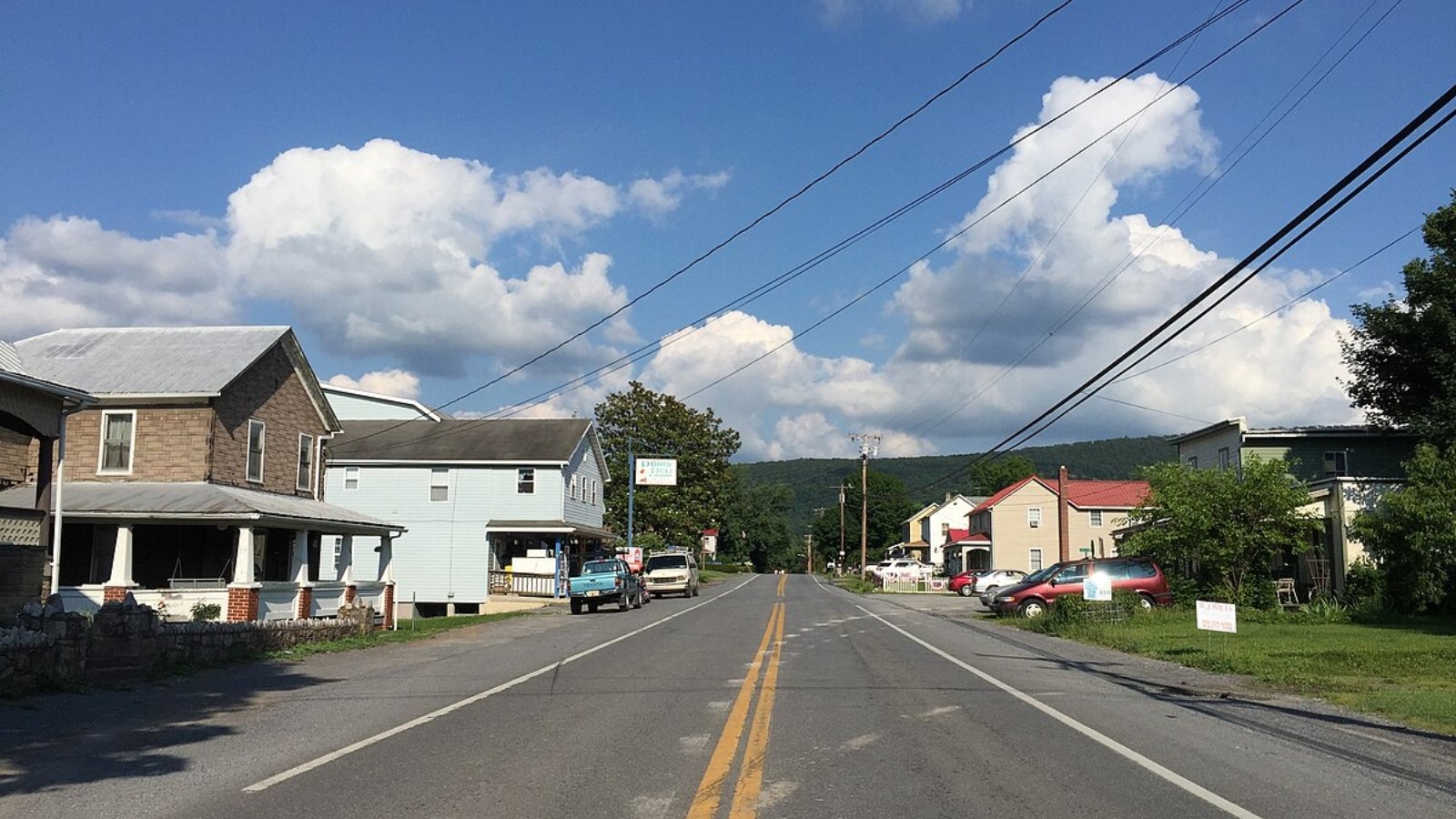
Why Are People Willing to Pay So Much to Live Here? What’s Special About It?
Kearneysville attracts affluent buyers seeking upscale suburban living with convenient access to Washington D.C. employment while enjoying West Virginia’s lower taxes and cost of living. The community offers quality neighborhoods, excellent schools, and modern amenities that appeal to professionals and families relocating from more expensive metropolitan areas. Its strategic location provides the best of both worlds: career opportunities and quality of life.
How Kearneysville Rose to Prominence
Kearneysville developed as an upscale suburban community designed to serve high-earning professionals working throughout the Washington D.C. metropolitan area. The community’s planned development, quality schools, and convenient highway access attracted families seeking suburban amenities while maintaining reasonable commuting distance to major employment centers. Growth accelerated as the area established itself as a premier residential location within Jefferson County.
3 Interesting Tidbits
1. Upscale Community – Kearneysville features higher-end residential development that attracts affluent families and professionals seeking quality amenities.
2. School Quality – The community is served by highly-rated Jefferson County schools, a major attraction for families with children.
3. Metro Proximity – Kearneysville’s location within the Washington D.C. metropolitan area provides access to high-paying federal and contractor employment.
5. Harpers Ferry – 96% Home Price Increase Since 2010

- 2010: $202,224
- 2011: $186,568
- 2012: $191,614
- 2013: $193,986
- 2014: $196,053
- 2015: $198,962
- 2016: $206,373
- 2017: $222,015
- 2018: $232,013
- 2019: $241,598
- 2020: $255,293
- 2021: $312,939
- 2022: $348,635
- 2023: $350,303
- 2024: $379,668
- 2025: $396,107
Harpers Ferry nearly doubled in value since 2010, maintaining steady appreciation through 2020 before accelerating dramatically during pandemic years. The community gained over $140,000 between 2020 and 2025, reaching current values approaching $396,000. This historic location demonstrates exceptional appeal within the Washington D.C. metropolitan area.
Why Harpers Ferry?
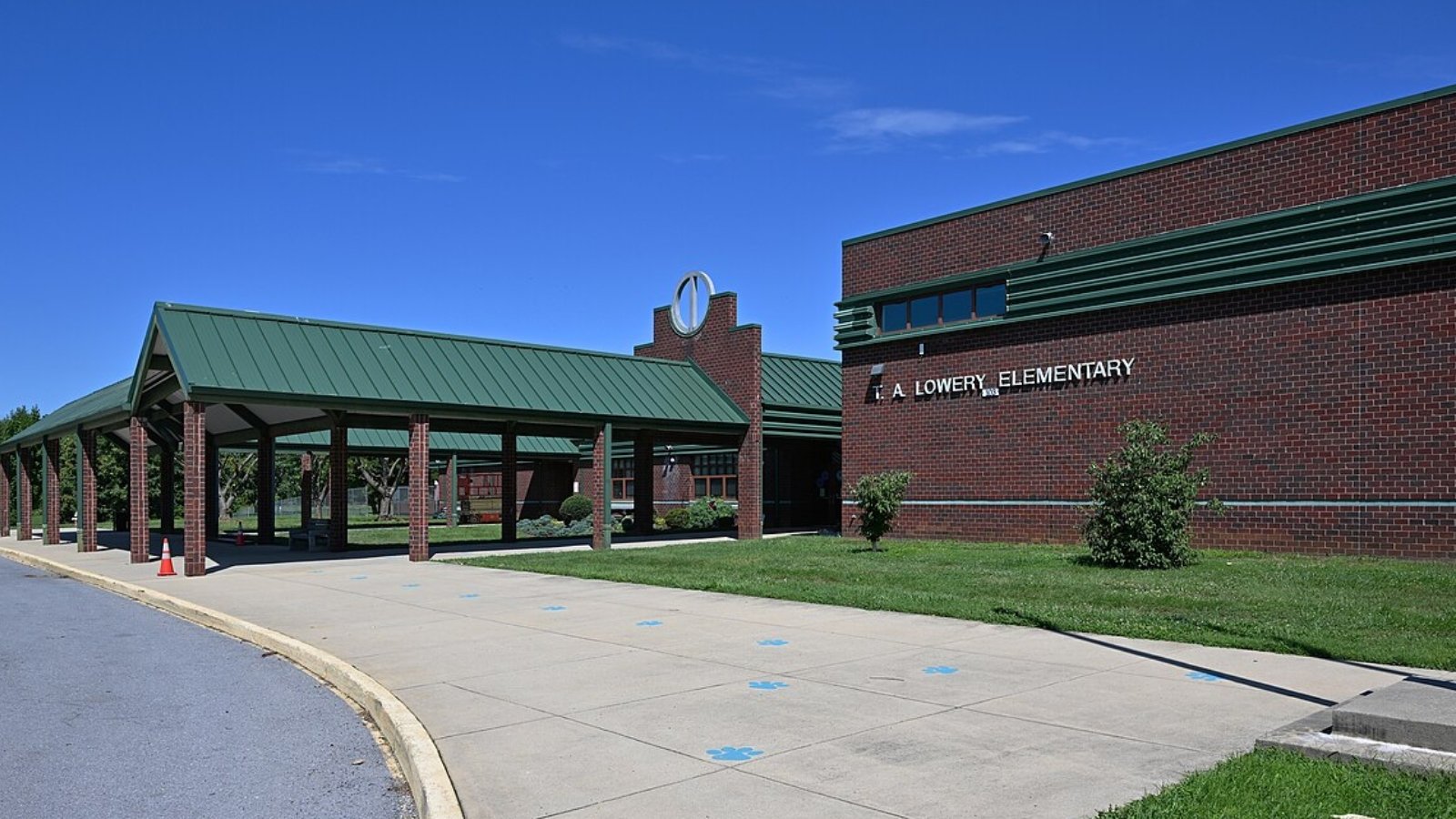
Why Are People Willing to Pay So Much to Live Here? What’s Special About It?
Harpers Ferry attracts buyers seeking to live within a National Historic Park setting while maintaining access to Washington D.C. employment opportunities. The community offers unparalleled historical significance, scenic beauty at the confluence of two rivers, and outdoor recreation access including the Appalachian Trail. Its unique combination of history, natural beauty, and metropolitan access creates exceptional appeal for discerning buyers.
How Harpers Ferry Rose to Prominence
Harpers Ferry’s prominence stems from its crucial role in American history, particularly John Brown’s 1859 raid that helped precipitate the Civil War. The town’s designation as a National Historic Park preserved its character while attracting residents and visitors interested in history and natural beauty. Modern growth reflects demand for unique properties with historical significance and scenic location within commuting distance of major employment centers.
3 Interesting Tidbits
1. Historic Significance – Harpers Ferry is the site of John Brown’s famous 1859 raid and features numerous Civil War historical sites within the National Historic Park.
2. River Confluence – The town sits at the confluence of the Potomac and Shenandoah Rivers, providing unique scenic beauty and recreational opportunities.
3. Appalachian Trail – Harpers Ferry serves as the psychological halfway point of the Appalachian Trail and houses the Appalachian Trail Conservancy headquarters.
4. Charles Town – 94% Home Price Increase Since 2010
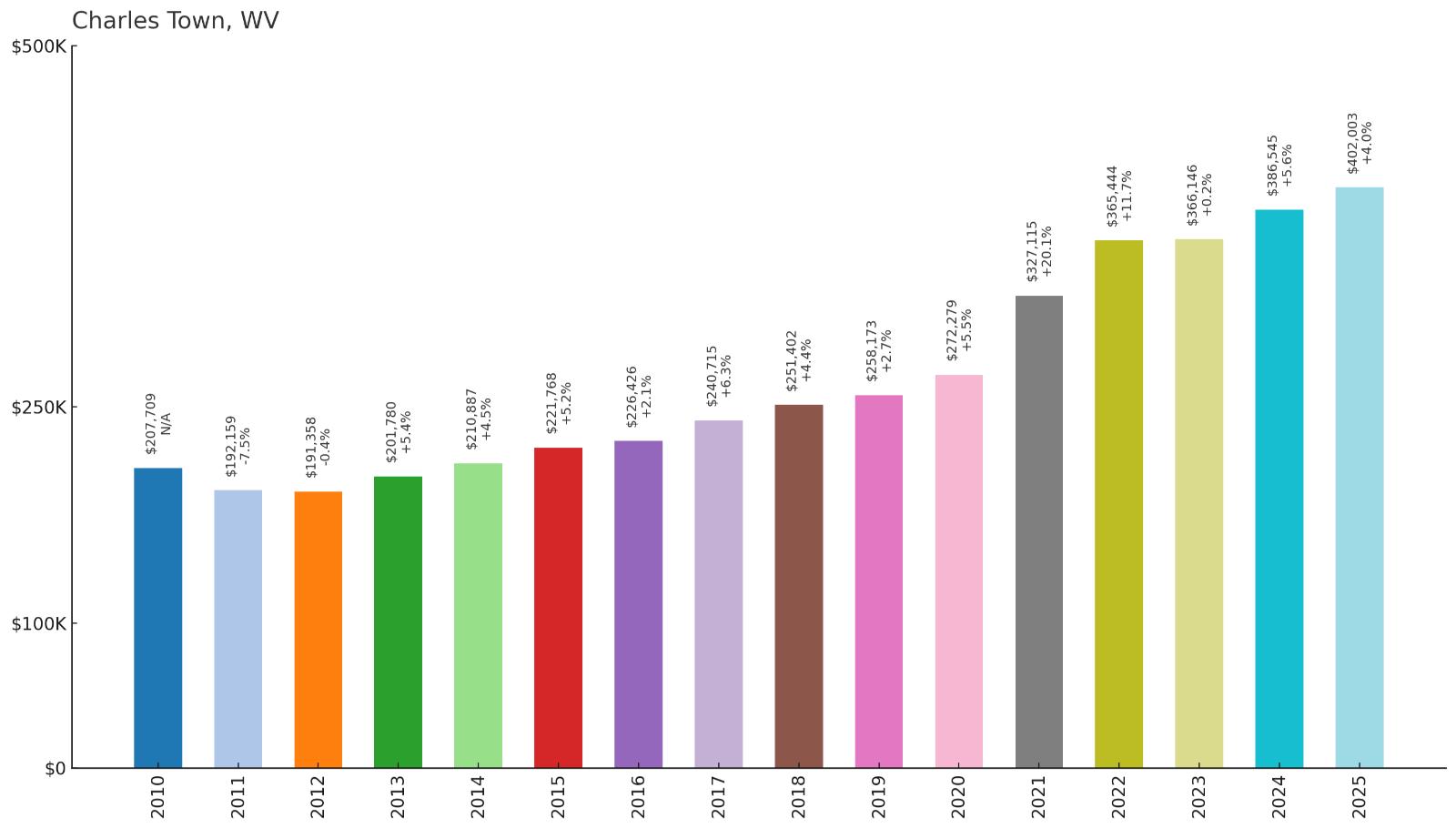
- 2010: $207,709
- 2011: $192,159
- 2012: $191,358
- 2013: $201,780
- 2014: $210,887
- 2015: $221,768
- 2016: $226,426
- 2017: $240,715
- 2018: $251,402
- 2019: $258,173
- 2020: $272,279
- 2021: $327,115
- 2022: $365,444
- 2023: $366,146
- 2024: $386,545
- 2025: $402,003
Charles Town nearly doubled in value since 2010, maintaining steady growth through 2020 before accelerating significantly during pandemic years. The community gained nearly $130,000 between 2020 and 2025, reaching current values exceeding $402,000. This Jefferson County seat demonstrates exceptional appeal as both a historic community and modern suburban center.
Why Charles Town?
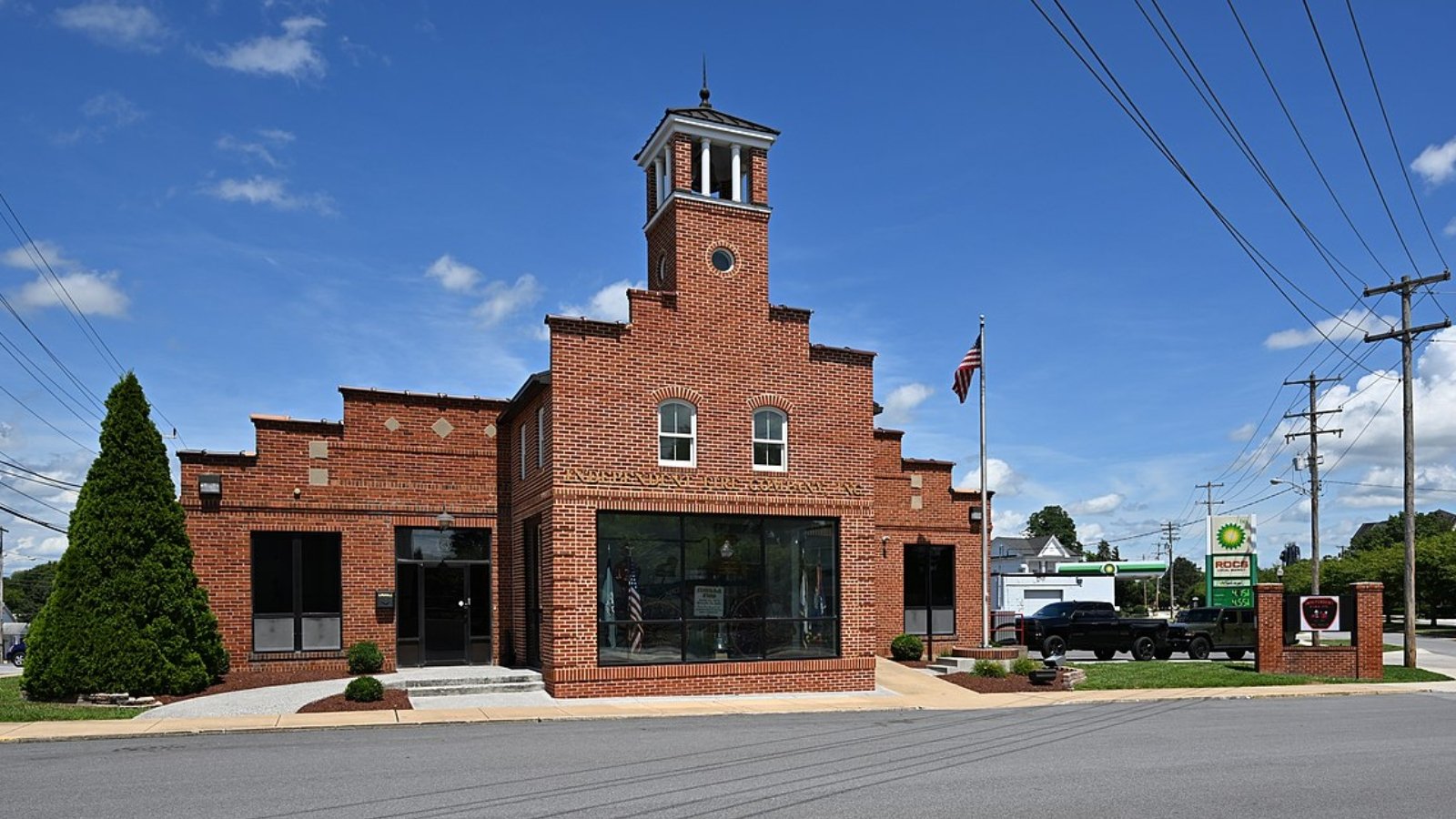
Why Are People Willing to Pay So Much to Live Here? What’s Special About It?
Charles Town attracts buyers seeking historic charm combined with modern suburban amenities while maintaining access to Washington D.C. employment opportunities. The community offers excellent schools, shopping, dining, and entertainment options including the Hollywood Casino that appeal to families and professionals. Its status as Jefferson County seat provides stability and services while offering both urban conveniences and small-town character.
How Charles Town Rose to Prominence
Charles Town’s prominence began with its founding by Charles Washington, youngest brother of George Washington, establishing its historical significance from the beginning. The community developed as the Jefferson County seat, providing governmental and commercial services that created economic stability. Modern growth reflects its strategic location within the Washington D.C. metropolitan area, attracting residents seeking quality of life improvements while maintaining career opportunities.
3 Interesting Tidbits
1. Washington Heritage – Charles Town was founded by Charles Washington, George Washington’s youngest brother, and features numerous historical connections to the Washington family.
2. County Seat – As Jefferson County’s seat, Charles Town provides governmental services and maintains a stable economic base that supports the housing market.
3. Gaming Destination – The Hollywood Casino at Charles Town Races provides entertainment and employment while attracting visitors to the area.
3. Shenandoah Junction – 113% Home Price Increase Since 2010
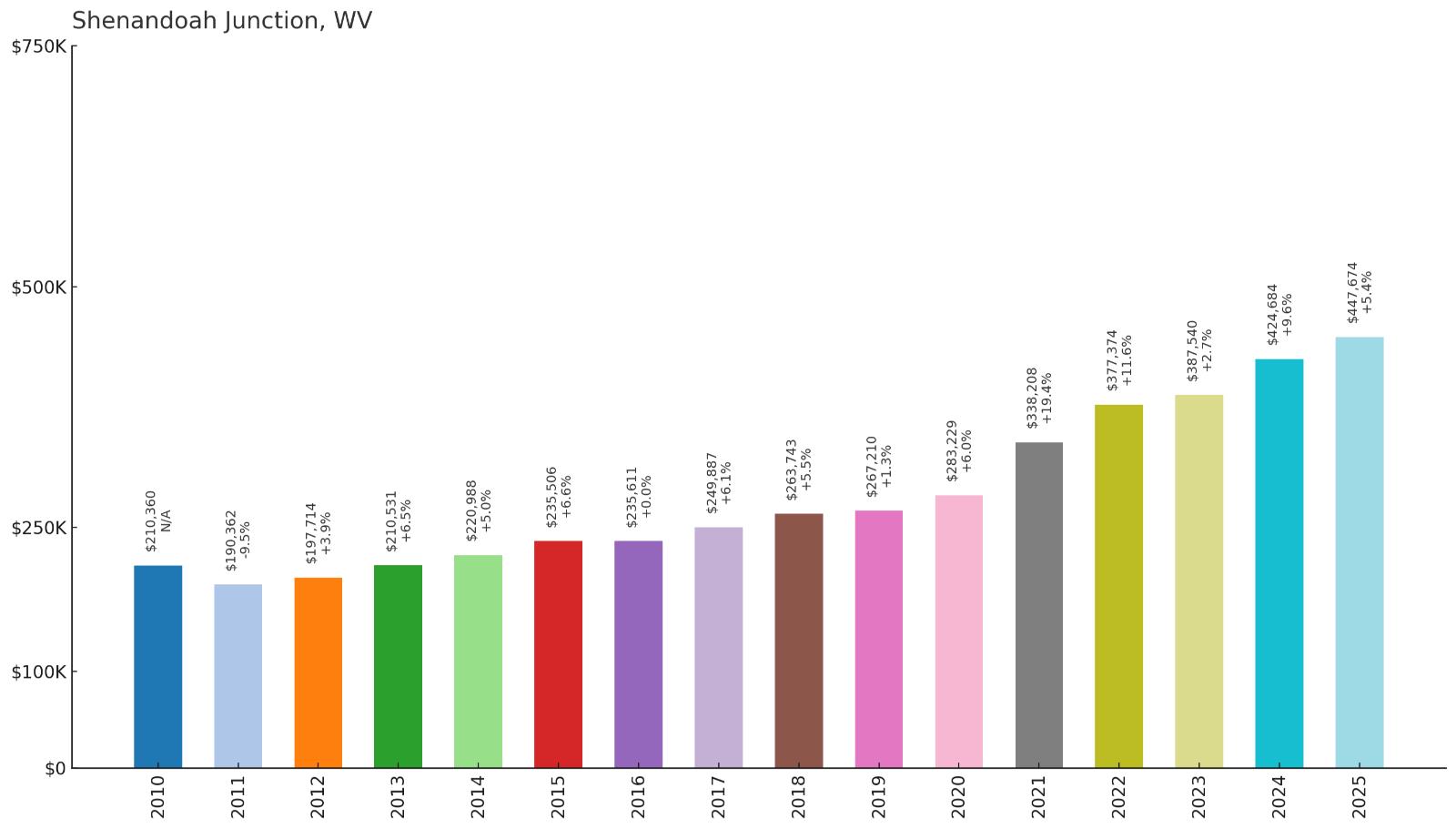
- 2010: $210,360
- 2011: $190,362
- 2012: $197,714
- 2013: $210,531
- 2014: $220,988
- 2015: $235,506
- 2016: $235,611
- 2017: $249,887
- 2018: $263,743
- 2019: $267,210
- 2020: $283,229
- 2021: $338,208
- 2022: $377,374
- 2023: $387,540
- 2024: $424,684
- 2025: $447,674
Shenandoah Junction more than doubled in value since 2010, maintaining consistent growth through 2020 before experiencing dramatic acceleration during pandemic years. The community gained over $164,000 between 2020 and 2025, reaching current values approaching $448,000. This Jefferson County location demonstrates exceptional performance within the Washington D.C. metropolitan area.
Why Shenandoah Junction?

Why Are People Willing to Pay So Much to Live Here? What’s Special About It?
Shenandoah Junction attracts affluent buyers seeking upscale residential properties with convenient access to Washington D.C. employment while enjoying West Virginia’s favorable tax environment. The community offers luxury housing developments and scenic locations that appeal to high-earning professionals and executives. Its strategic location provides excellent transportation access while maintaining privacy and exclusivity that commands premium prices.
How Shenandoah Junction Rose to Prominence
Shenandoah Junction developed as an exclusive residential area serving the Washington D.C. metropolitan market, attracting buyers seeking luxury properties with convenient commuting access. The community’s upscale development and scenic location created appeal for affluent professionals seeking alternatives to Virginia and Maryland’s high-priced luxury markets. Growth accelerated as the area established itself as a premier address within Jefferson County.
3 Interesting Tidbits
1. Luxury Market – Shenandoah Junction features upscale residential development that attracts affluent buyers seeking exclusive properties.
2. Transportation Hub – The community’s name reflects its historic role as a railroad junction, now providing convenient modern transportation access.
3. Premium Location – Shenandoah Junction’s position within the Washington D.C. metropolitan area combined with luxury amenities commands premium pricing.
2. Summit Point – 64% Home Price Increase Since 2019
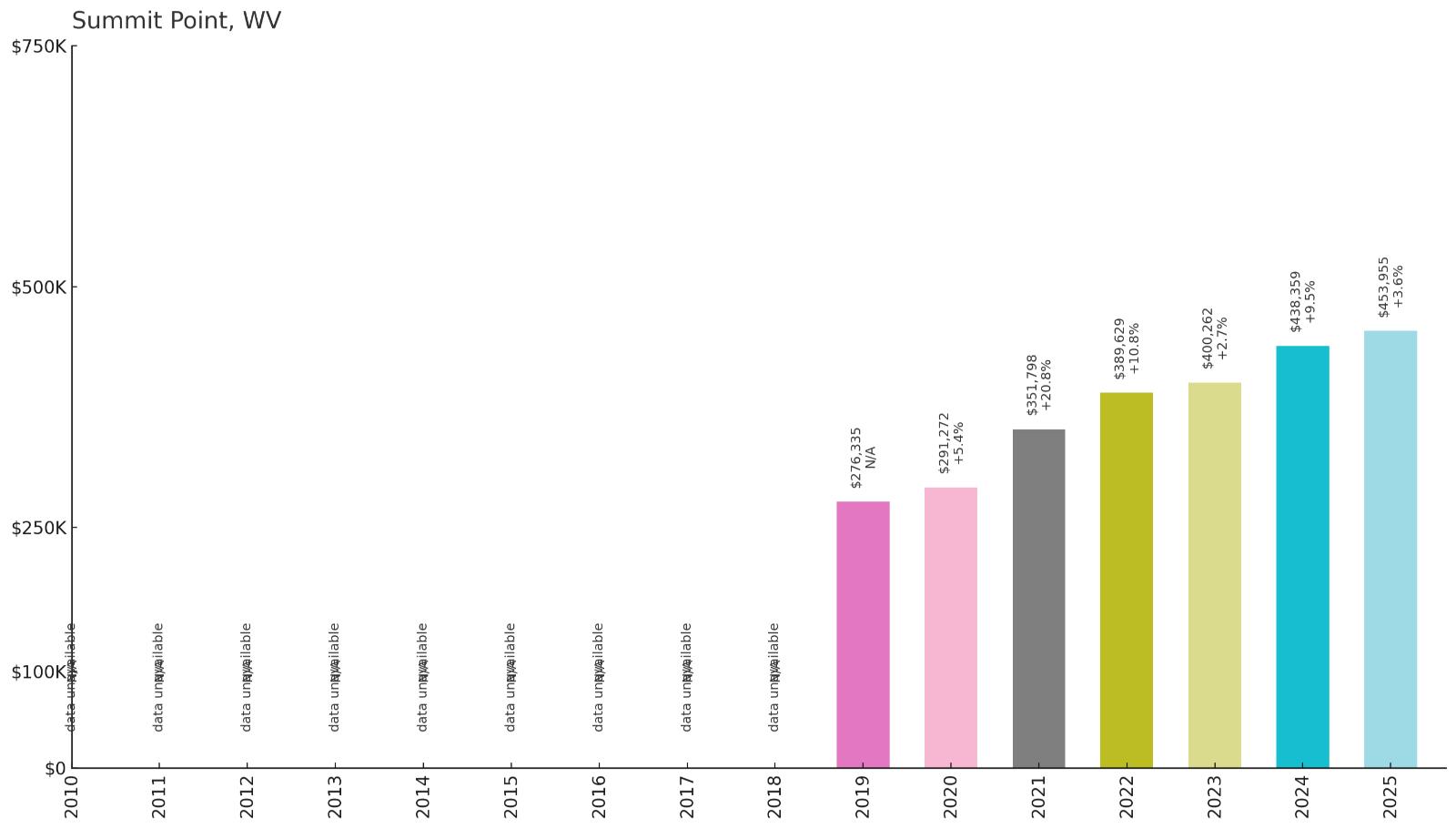
- 2010: N/A
- 2011: N/A
- 2012: N/A
- 2013: N/A
- 2014: N/A
- 2015: N/A
- 2016: N/A
- 2017: N/A
- 2018: N/A
- 2019: $276,335
- 2020: $291,272
- 2021: $351,798
- 2022: $389,629
- 2023: $400,262
- 2024: $438,359
- 2025: $453,955
Summit Point achieved remarkable appreciation in just six years, growing from around $276,000 to over $453,000 since data became available in 2019. The community experienced consistent year-over-year growth with particularly strong gains during 2021-2022. Current values approaching $454,000 reflect its appeal as a newer luxury development within the Washington D.C. metropolitan area.
Why Summit Point?
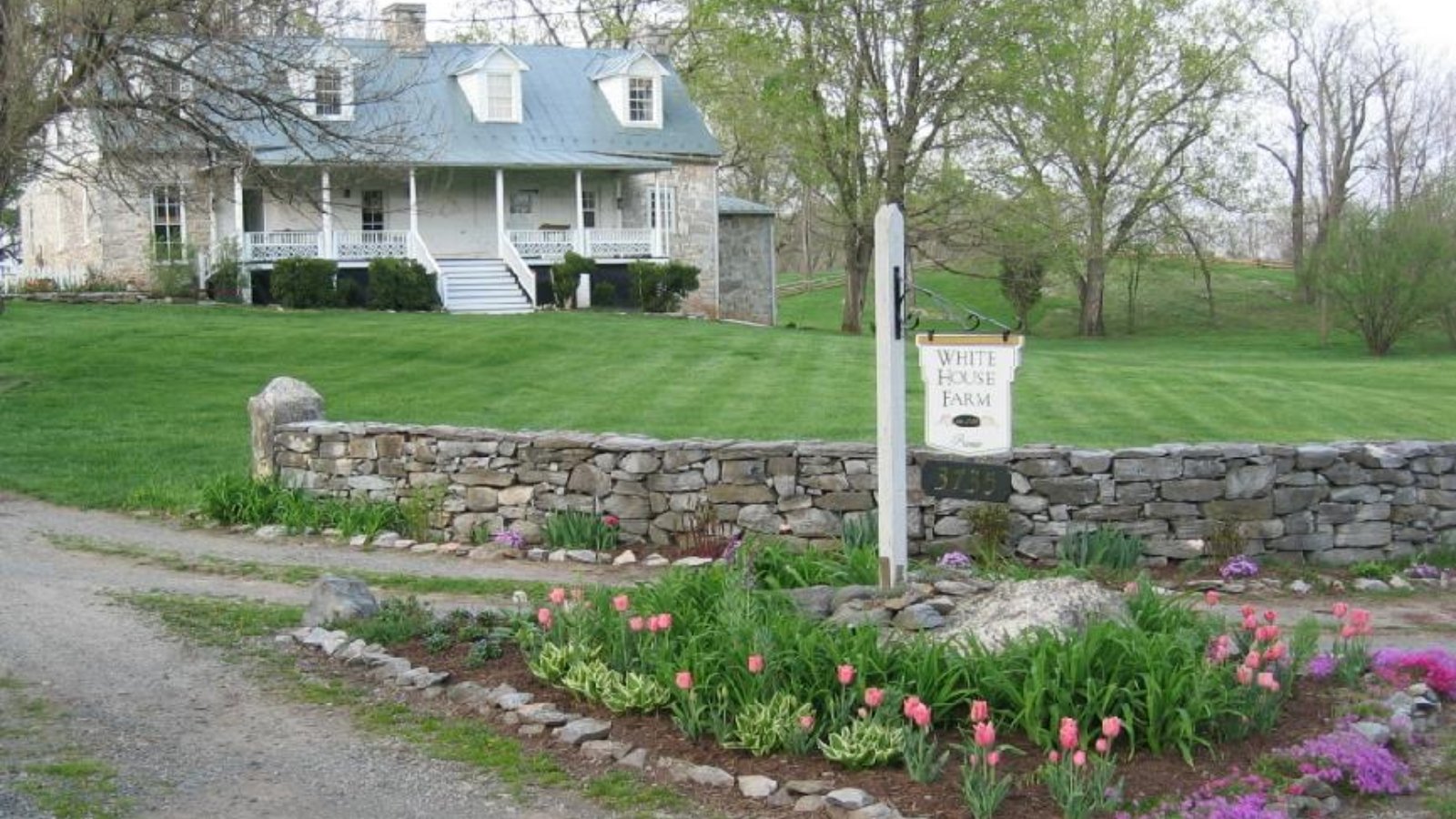
Why Are People Willing to Pay So Much to Live Here? What’s Special About It?
Summit Point attracts buyers seeking modern luxury properties with motorsports amenities and proximity to Washington D.C. employment opportunities. The community offers unique appeal through its connection to Summit Point Motorsports Park, creating a distinctive lifestyle for automotive enthusiasts. Its newer development and upscale amenities appeal to affluent professionals seeking contemporary living with recreational access.
How Summit Point Rose to Prominence
Summit Point developed around the famous Summit Point Motorsports Park, creating a unique residential community that appeals to racing enthusiasts and luxury home buyers. The area’s connection to motorsports culture combined with convenient access to the Washington D.C. metropolitan area attracted affluent buyers seeking distinctive properties. Recent development has enhanced the community’s appeal with modern amenities and upscale residential options.
3 Interesting Tidbits
1. Motorsports Connection – Summit Point is home to the renowned Summit Point Motorsports Park, attracting racing enthusiasts and automotive industry professionals.
2. Rapid Growth – The community achieved 64% appreciation in just six years since data became available, demonstrating exceptional market performance.
3. Luxury Development – Summit Point features modern, upscale residential development that commands premium prices within Jefferson County.
1. Shepherdstown – 86% Home Price Increase Since 2010
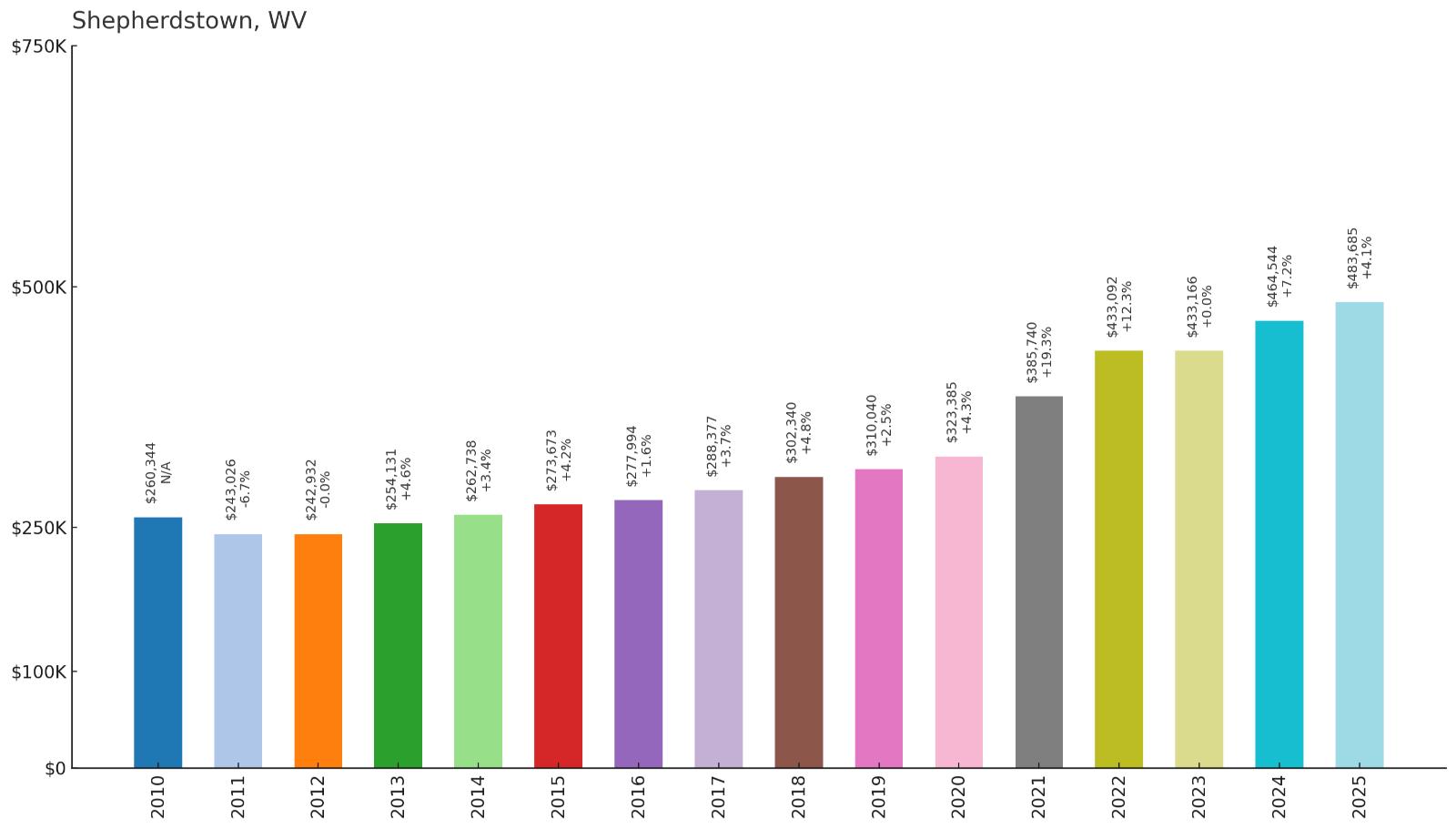
- 2010: $260,344
- 2011: $243,026
- 2012: $242,932
- 2013: $254,131
- 2014: $262,738
- 2015: $273,673
- 2016: $277,994
- 2017: $288,377
- 2018: $302,340
- 2019: $310,040
- 2020: $323,385
- 2021: $385,740
- 2022: $433,092
- 2023: $433,166
- 2024: $464,544
- 2025: $483,685
Shepherdstown leads all West Virginia communities with current median home values approaching $484,000, nearly doubling since 2010. The town maintained steady appreciation through 2020 before experiencing dramatic acceleration during pandemic years, gaining over $160,000 between 2020 and 2025. This historic college town demonstrates exceptional appeal within the Washington D.C. metropolitan area.
Why Shepherdstown?
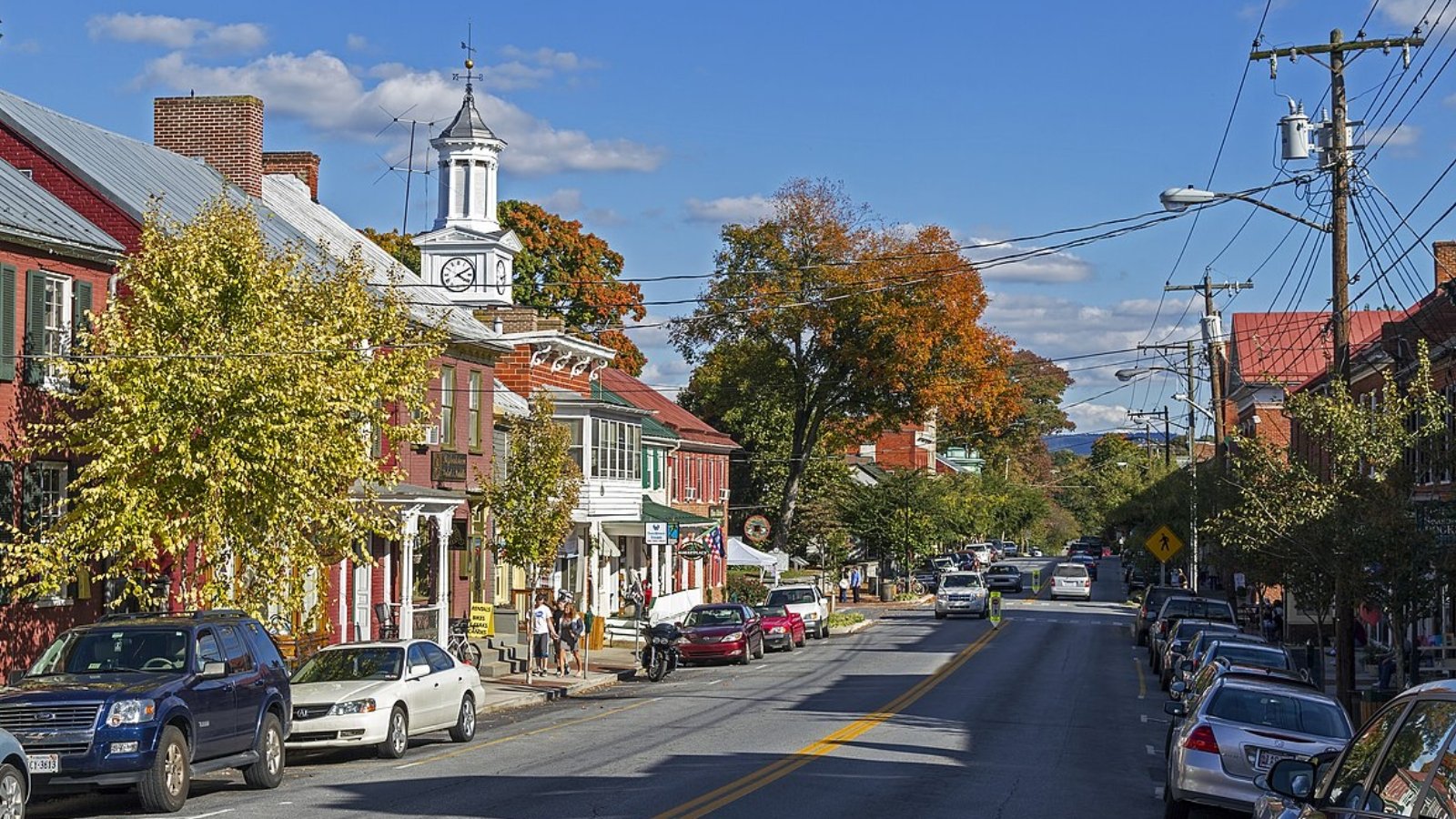
Why Are People Willing to Pay So Much to Live Here? What’s Special About It?
Shepherdstown attracts discerning buyers seeking historic charm combined with intellectual culture in West Virginia’s oldest town. The community offers Shepherd University’s cultural and educational amenities, historic architecture, and sophisticated dining and arts scene that creates unique appeal. Its location provides access to Washington D.C. employment while maintaining small-town character and walkable downtown that appeals to professionals and retirees alike.
How Shepherdstown Rose to Prominence
Shepherdstown’s prominence began as West Virginia’s oldest town, chartered in 1762, with deep historical roots including connections to George Washington and the Civil War. Shepherd University’s presence created an intellectual and cultural foundation that attracted educated residents and enhanced the community’s sophistication. The town’s careful preservation of historic character while accommodating modern amenities created exceptional appeal for buyers seeking authentic charm with contemporary conveniences.
3 Interesting Tidbits
1. Oldest Town – Shepherdstown is West Virginia’s oldest town, chartered in 1762, with numerous buildings listed on the National Register of Historic Places.
2. University Town – Shepherd University provides cultural amenities, intellectual environment, and economic stability that enhance the community’s appeal and property values.
3. Historic Preservation – The town’s Historic District features carefully preserved 18th and 19th-century architecture that creates unique character and attracts buyers seeking authentic historic properties.


